13 SMART Goals Examples for Special Education Teachers
Do you work as a special education teacher and struggle to set practical goals in the classroom? If so, you are not alone. Many teachers face challenges when creating goals that align with their students’ needs.
However, developing SMART goals can make a significant difference in promoting student success and improving teaching practices . Here, we’ll explore 13 examples of SMART goals for special education teachers.
But before diving into the specific examples, let’s first understand what SMART goals are and why they are essential for special education teachers.
Table of Contents

What is a SMART Goal?
SMART is a framework for setting goals to enhance the quality of special education teaching. SMART is an acronym for Specific, Measurable, Attainable, Relevant, and Time-based.
If you’re still unsure what these mean, let’s delve deeper into each component of the SMART system:
Vague goals can lead to a lack of focus, resulting in wasted time. However, crafting well-defined goals will clarify what needs to be achieved, thereby increasing your overall efficiency.
It’s crucial to outline the steps and identify those responsible for accomplishing them. This approach creates a clear roadmap for everyone involved in the task and aids in finding challenges early on.
Measuring your teaching goals is crucial for success. Regularly monitoring progress allows you to spot areas that require further enhancement. Without this aspect, it’s hard to ascertain whether your efforts are making an impact or are merely spinning your wheels.
While it’s natural to get swept up in the thrill of your desires, you might fall short of your goals without a solid plan and realistic expectations.
Considering your current circumstances, it’s necessary to evaluate what is genuinely achievable . Reflect on the available resources to meet your objectives. The idea is to balance between ambition and feasibility.
Establishing goals aligning with your values can inspire you to reach your desired outcomes. Your core values will be a compass during challenging times, helping you stay on course.
A clear timeline enhances your ability to adhere to your schedule and maintain focus on your targets. As success isn’t achieved overnight, setting a deadline can encourage sustained dedication over time.
1. Utilize Positive Reinforcement
“For 6 months, I’ll use positive reinforcement techniques such as praise, encouragement, and rewards for students who display desired behaviors. I plan to observe student behavior before and after implementing this technique to measure its effectiveness.”
Specific: This goal specifies the reinforcement techniques the teacher will employ (e.g., praise, encouragement, and rewards).
Measurable: This can be measured by observing student behavior before and after implementing the technique.
Attainable: The timeline of 6 months is reasonable for a teacher to implement positive reinforcement techniques.
Relevant: Positive reinforcement is an important teaching tool to help students learn better and behave more appropriately in the classroom.
Time-based: The SMART statement should be achieved after 6 months.
2. Create an Individualized Education Program
“I’ll develop individualized education plans for every student in my classroom. This is a critical step to ensure that each student gets the best learning experience tailored to their needs. I will design all IEPs by the end of the school year.”
Specific: The goal clearly states what will be done and when it must be completed.
Measurable: You can measure success by looking at how many IEPs are created and how well they serve their purpose.
Attainable: This is possible because there is enough time to create individualized education plans for each student.
Relevant: This relates to creating the best learning experience for special education students.
Time-based: There is a one-year time frame to develop all IEPs.
3. Improve Students’ Reading Comprehension
“By the end of this semester, I want to implement a literacy program that will enable my special education students to enhance their reading comprehension. I’ll select a curriculum incorporating direct instruction and creative learning strategies, like story-building.”
Specific: You have precise actions available—implement a literacy program and incorporate direct instruction and creative learning strategies.
Measurable: Assess the student’s reading comprehension through formal and informal assessments.
Attainable: This is a reasonable goal if you dedicate time to research effective literacy programs.
Relevant: Special education students might often need extra help to develop reading comprehension skills.
Time-based: You should expect goal achievement by the end of the semester.
4. Expand Social Skills Development
“I want to focus on providing extra activities that encourage social skills development for my special education students. By the end of the school year, I’d like to see an improvement in how well students can communicate and collaborate with their peers.”
Specific: You will be working to provide activities that promote successful peer interactions.
Measurable: The teacher can measure students’ progress in interacting with peers through observation and assessments.
Attainable: Helping your students acquire these social skills is reasonable and achievable.
Relevant: This pertains to the overall development of these students , as socialization is an essential aspect of growth.
Time-based: You should see improvements by the end of the school year.
5. Strengthen Academic Performance
“I will work to improve the academic performance of my special education students by incorporating more hands-on activities into each lesson. I hope to have each student maintain an average grade of 75% or higher in each subject by the end of the semester.”
Specific: This SMART goal is explicit because it focuses on improving academic performance through a clearly defined plan.
Measurable: Take note of students’ performance in each lesson and make necessary changes.
Attainable: Enhancing academic performance is feasible if the special education teacher can implement their plan successfully.
Relevant: Boosting the academic performance of students is a priority for many teachers and is thus pertinent to their role.
Time-based: Four entire months are required for effective teaching.
6. Increase Parental Involvement
“I will use multiple strategies to increase parental involvement in their child’s education within three months. These strategies include weekly updates via email, face-to-face meetings, phone calls, and classroom visits.”
Specific: The goal outlines the strategies, when they should be used (weekly), and how long it’s expected to take (three months).
Measurable: You can count the updates sent each week, meetings held, calls made, and visits made.
Attainable: It is definitely possible to reach out weekly via multiple methods.
Relevant: Special education students benefit from having their parents involved in their schooling.
Time-based: The goal statement should be accomplished after three months.
7. Encourage the Inclusion of Special Needs Students
“I want to create an inclusive environment in my classroom this month. I’ll identify which special needs students can be included in regular activities and provide necessary accommodations. I’ll also ensure that students with special needs have the same access to resources as other students.”
Specific: The individual aims to create an inclusive environment in their classroom.
Measurable: Check which students should be included in regular activities.
Attainable: This is reachable because the teacher is taking proactive steps to ensure all students have access to the same resources.
Relevant: The statement is appropriate because it focuses on including special needs students in regular activities.
Time-based: The goal is time-bound because it has an end date of one month.
8. Implement Effective Behavioral Strategies
“Over two months, I will become proficient in implementing behavioral strategies for my students. I’ll read three books on the subject, attend a two-day conference about behavior strategies, and observe 5 classrooms in my school district to learn from their methods.”
Specific: This goal is straightforward because you plan to become proficient in behavior strategies for students with special needs.
Measurable: Evaluate your progress by checking off boxes after completing each step in the plan.
Attainable: The teacher has identified a realistic deadline to implement effective behavioral strategies.
Relevant: This relates directly to student success and classroom management, making it an appropriate goal.
Time-based: Completion of this goal is anticipated after two months.
9. Reduce Student Anxiety Levels
“The teacher will reduce their students’ anxiety levels by 15% within a month. They plan to teach students stress-reducing exercises such as yoga , deep breathing, guided meditation, and mindfulness activities.”
Specific: The statement outlines what the teacher will do to reduce students’ anxiety levels and how long they must do it.
Measurable: Document a baseline of each student’s anxiety levels and track the reductions over time.
Attainable: This goal is doable if the teacher provides interventions to reduce stress levels.
Relevant: The goal applies to a special education classroom environment because it focuses on improving student mental health.
Time-based: There is a time limit of one month for meeting this certain goal.
10. Boost Vocational Skills Training
“I will increase the vocational skills training of my special education students by 15% by the end of the school year. I’ll implement new strategies and activities to develop their skilled trades in carpentry, plumbing, auto repair, etc.”
Specific: This is specific because it explicitly states increasing the vocational skills training of special education students.
Measurable: This SMART goal is quantifiable as it requires increasing the training of special education students by 15%.
Attainable: Boosting vocational training by 15% is possible if the right strategies and activities are implemented.
Relevant: Increasing special education students’ vocational abilities is essential for their successful career paths .
Time-based: Goal attainment should be expected within a school year.
11. Nurture a Supportive Learning Environment
“I will create a safe and inclusive learning environment in my classroom so students feel comfortable asking questions and participating. Within four weeks, I will commit to 30 minutes each day to listen to all of my student’s concerns and needs.”
Specific: The SMART goal is clear—to foster an inclusive and supportive learning environment for the students.
Measurable: You will commit to 30 minutes each day to listen to the student’s concerns .
Attainable: Creating an inviting learning environment with the right resources and commitment is possible.
Relevant: A supportive learning environment is essential in special education.
Time-based: There is a four-week deadline to reach the desired outcome.
12. Integrate Technology in the Classroom
“I aim to integrate technology into the curriculum of my special education students by utilizing online resources. I’ll also use various technological devices to boost engagement levels with the subject material and enrich learning experiences within 7 months.”
Specific: This goal sets out what is required (integrating tech into the curriculum and utilizing online resources) and how long it will take (7 months).
Measurable: You could count the number of times you use the new tech in class.
Attainable: Integrating technology into a classroom is just a matter of research and preparation.
Relevant: Harnessing the power of tech will help special education students become more engaged in their learning experience.
Time-based: Achievement of goal is expected by the end of 7 months.
13. Promote Self-Advocacy Among Students
“I will create an open and supportive environment in my classroom for students to become comfortable with advocating for themselves. I’ll roleplay self-advocacy scenarios with my students and provide opportunities for them to voice their opinions in class for 5 months.”
Specific: The aim is precise since the teacher wants to create an open environment in the classroom to promote self-advocacy among students.
Measurable: Ensure you roleplay scenarios with their students and provide opportunities to voice their opinions in class.
Attainable: Not only is this a realistic goal but also an important one, as it can improve student confidence and communication skills.
Relevant: Self-advocacy is vital for special education students to build self-confidence and develop relationships with others.
Time-based: Five months provides enough time for the teacher to succeed.
Final Thoughts
Recognize that each goal should be tailored to meet the unique needs of your classroom. Following the SMART template, you can set incredible goals to positively impact your students’ learning experience.
So start creating SMART goals for your special education classroom today. And don’t forget to review and revise them as needed regularly. Progress is essential in any teaching journey.
Keep striving towards continuous improvement in all aspects of your work with these SMART goals. Hopefully, this guide has helped you better understand how to establish goals for your special education classroom.

11 SMART Goals Examples for Special Education Teachers
There might be affiliate links on this page, which means we get a small commission of anything you buy. As an Amazon Associate we earn from qualifying purchases. Please do your own research before making any online purchase.
Being a teacher is a fulfilling and rewarding profession. One thing I learned from my time in the classroom is that you can never plan too much as a teacher. Setting realistic goals for yourself and your students is the best way to get everyone on the same page and have a basis to measure the smallest accomplishments by.
This is especially true when it comes to special education. With over 700,000 special education teachers in the United States in 2022, these professionals must have the preparation and support needed . Every day, these teachers are tasked with the challenge of helping their students reach their full potential … despite any physical, mental, or developmental difficulties they might face.
Special education is not a one size fits all approach . So, teachers need to create goals tailored specifically to their students’ individual needs while thinking of the overall classroom. Whether you have students with autism spectrum disorder (ASD) , learning disabilities , or other challenges, setting smart goals for them can help ensure they get the quality education they deserve .
Table of Contents
What Are SMART Goals?
Setting SMART goals is one important way that special education teachers can measure the success of their educational plans , and ensure that they are staying on track .
So what do we mean by SMART goals in education ? SMART stands for Specific, Measurable, Attainable, Relevant, and Time-bound. This acronym helps educators to ensure that goals are precise, achievable and measurable within a certain timeframe.
For example, simply setting a goal of having students read more isn't SMART. However, setting a goal for students to read one book a month for the next six months is SMART!
What To Consider When Planning Smart Goals
S stands for Specific
When setting smart goals in special education, it is important to make sure your goals are as specific as possible. Goals should be clear and describe exactly what you and the student are working toward.
M stands for Measurable
Measurability is key when creating smart goals for special education. Without measurable milestones, you can’t track progress or see success. You can measure data by way of tests, surveys, observations, and other forms of assessment.
A stands for Attainable
Setting smart goals also means making sure that they are attainable. Stretch goals are great, but they should also be realistic and achievable within the specified timeframe. Remember, some special education students may be more severely disabled and require more time to reach their goals.
If a student is on the non-verbal autism spectrum, speaking goals aren't feasible. However, you can always consider assistive technology such as adaptive computers, VOCAs, PECS (Picture Exchange Communication Systems), and more for communication related goals.
R stands for Relevant
Smart Goals have to be relevant to the special education student and their individual needs. Relevant smart goals are contextual, and applicable to the classroom or even the student’s home or general environment. The goals can also apply to your career advancement as a special education teacher; the more you know, they more you can teach or adjust your methods.
T stands for Time-Bound
Most smart goals have a timeline, or an estimated time of completion. Time limits help ensure that there is a sense of urgency, and that smart goals are accomplished in a timely fashion.
Your time limit may be weekly, based on the school semester, or the whole school year. Some goals may be attainable daily such as a student answering five math questions correctly.
Now that you have a detailed understanding of the type of smart goals that special education teachers should strive for, let’s take a look at 11 smart goal examples!
11 Smart Goals Examples for Special Education Teachers
Setting SMART goals is an effective way for special education teachers to create objectives that will help drive student success . By creating Specific, Measurable, Attainable, Relevant and Time-Specific (SMART) goals, educators can track progress and maintain focus on the tasks at hand.
1. Increase Attendance Rate
By increasing attendance rates among students with disabilities by 10%, educators can ensure that all students are present and able to access the materials being taught.
“I will start reviewing attendance from previous semester or year to see where there are gaps and create plans to fill them. I will increase attendance rate by 10% within the next four months. I may have to confer with the administration to make sure “tardy” students were not marked late.”
S – The specific goal is to increase the attendance rate by 10% after reviewing previous attendance issues.
M – The measure for success is attendance rate. Teachers start by taking attendance daily.
A – An increase of 10% is attainable and realistic.
R – This smart goal is relevant to the special education classroom, as all students should be present and able to access the materials being taught.
T – This smart goal should be accomplished within the next four months. Four months is the average amount of time between each school semester, and should be an achievable timeline.
2. Create an Individualized Education Plan (IEP) for Each Student
As a special education teacher, IEPs are a vital resource for providing each student with the proper individualized instruction they need.
“I will dedicate time to see how each student learns, and create lesson plans tailored to their unique needs. I will create an individualized education plan for each student within one month.”
S – The specific goal is to create an IEP for each student.
M – The measure for success is the completion of individualized education plans.
A – This smart goal should be achievable within one month.
R – Creating an IEP is relevant to special education, as each student has unique needs that must be accounted for.
T – Creating an IEP should be achieved within one month, as this is sufficient time to assess each student and craft lesson plans tailored to their individual needs.
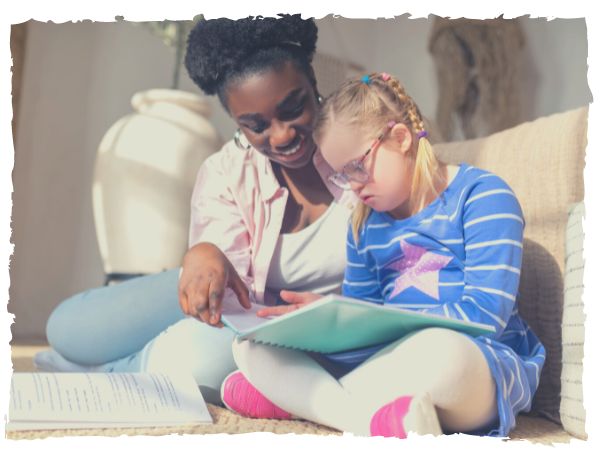
3. Increase Number of At-Risk Students Reading on Grade Level
Learning to read is a fundamental skill, and one that all students should be proficient in by the end of their elementary education.
“I will strive to increase the number of at-risk students that are reading on grade level by the end of the school year.”
S – The specific goal is to increase the number of at-risk students reading on grade level.
M – The measure for success is the number of at-risk students reading on grade level.
A – Increasing the number of at-risk students reading on grade level is attainable and realistic.
R – This smart goal is relevant to the special education classroom, as students with disabilities need extra assistance to read on grade level.
T – This smart goal should be achieved by the end of the school year, as this is a reasonable timeline for students to learn to read and become proficient. In some cases, some students may achieve this goal sooner, but the school year allows for enough time to ensure all students are reading on grade level.
4. Increase Student Vocabulary
By increasing student vocabulary, special education teachers can ensure that their students are better equipped to communicate effectively with others .
“I will work to increase my students’ vocabulary by 50% within three months.”
S – The specific goal is to increase student vocabulary by 50%.
M – The measure for success is the amount of words students can recognize.
A – Increasing student vocabulary by 50% is attainable and realistic.
R – This smart goal is relevant to the special education classroom, as students with disabilities need assistance in order to be able to communicate effectively with others. Even if students are non-verbal. teachers can use assistive technology tools to grasp student comprehension of new words.
T – This smart goal should be accomplished within three months, as this is a reasonable timeline for students to learn the necessary words to communicate effectively. This timeline also allows for review and reinforcement of previously learned vocabulary.
5. Provide At-Risk Students with Accessible Reading Materials
Special education teachers can help at-risk students increase their reading comprehension by providing them with materials that are accessible.
“I will provide at-risk students with accessible reading materials by way of audio recordings or simplified texts within two months.”
S – The specific goal is to provide at-risk students with accessible reading materials .
M – The measure for success is the number of students who have access to reading materials.
A – Providing at-risk students with accessible reading materials is achievable and realistic.
R – This smart goal is relevant to special education, as students with disabilities may require alternative forms of learning materials in order to increase their reading comprehension.
T – This smart goal should be achieved within two months, as this is a reasonable timeline to find and provide accessible reading materials for these students. Additionally, this timeline allows sufficient time for the teacher to assess each student's individual needs and source materials accordingly.
6. Get Another Special ED Certification
Ongoing professional development for Special ED specialists is vital. This smart goal is relevant for all special education teachers, as it is important to stay up-to-date on the latest trends and best practices in special education.
“ I will get certified within six months as a one of the following: Special Education Generalist, Special Education Administrator, Certified Disability Management Specialist, and Special Education Teacher Leader. ”
S – The specific goal is to get another certification within 6 months.
M – The measure for success is the successful completion of courses and exams towards the chosen certification.
A – Getting another certification within six months is achievable and realistic, providing the teacher has the necessary resources to complete courses and exams in the allotted time.
R – This smart goal is relevant to special education, as teachers need to stay up-to-date on the latest trends and best practices in special education.
T – This smart goal should be achieved within six months, as this is a reasonable timeline to complete courses and exams for the chosen certification. This timeline also allows enough time for the teacher to study and prepare for exams.
7. Increase Parental Communication
Special education teachers must ensure they are actively communicating with parents and guardians. This smart goal is relevant for all special education teachers, as parents and guardians need to be informed about the progress of their children.
“Within one month, I will create a system wherein I regularly update parents on any changes or advancements of their children in the classroom.”
S – The specific goal is to increase parental communication within one month.
M – The measure for success is the number of parents and guardians that have been updated on the progress of their children.
A – Increasing parental communication within one month is achievable and realistic, provided the teacher has a system in place to facilitate communication.
R – This smart goal is relevant to special education, as keeping parents and guardians informed about the progress of their children is an important responsibility for teachers.
T – This smart goal should be achieved within one month, as this is a reasonable timeline to put in place a system for communication and contact every parent or guardian of students in the class. This timeline also allows enough time for the teacher to arrange meetings or develop a suitable system of communication.
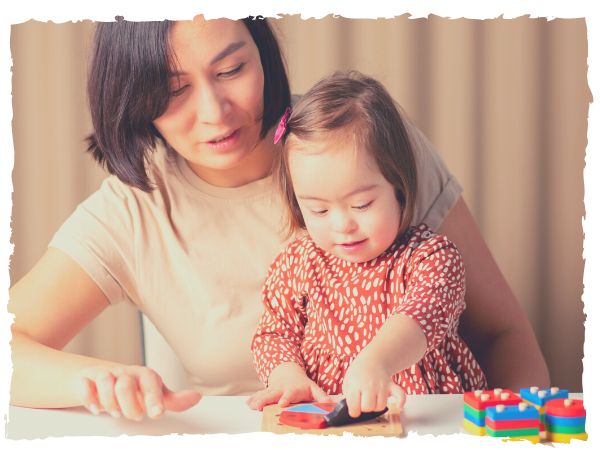
8. Facilitate Collaborative Learning Activities
Collaboration with other students is just as important for special education students as it is for any other student. This smart goal is relevant for all special education teachers, as it is important to nurture group dynamics and collaboration amongst students.
“ I will facilitate regular collaboration activities like group projects, interactive games, and other social activities within two months.”
S – The specific goal is to facilitate regular collaborative learning activities within two months.
M – The measure for success is the number of collaborative learning activities completed by students.
A – Facilitating regular collaborative learning activities within two months is achievable and realistic, provided the teacher has access to suitable resources for such activities.
R – This smart goal is relevant to special education, as collaboration is still vital to students of any and all abilities.
T – This smart goal should be achieved within two months, as this is a reasonable timeline to introduce new and engaging activities for students to work on collaboratively. This timeline also allows enough time for the teacher to plan, organize, and implement collaborative activities in the classroom. The teacher can see what works best, what the students enjoy most, and then adjust activities accordingly.
9. Implement A Positive Reinforcement System
Positive reinforcement is an important tool for special education teachers. This smart goal is relevant for all special education teachers, as positive reinforcement helps to encourage good behavior and reinforces the importance of good behavior.
“I will implement positive reinforcement through verbal praise, reward systems, or incentives within three months. The type of reinforcement I will use can vary depending on the student's comprehension level.”
S – The specific goal is to implement a positive reinforcement system within three months. Adjust reinforcement on age, grade level, comprehension level, and other factors.
M – The measure for success is the number of students who respond positively to the reinforcement system. Teachers can also measure success in terms of the number of rewards or incentives given out daily or weekly.
A – Implementing a positive reinforcement system within three months or sooner is realistic.
R – This smart goal is relevant to special education, as positive reinforcement is an important tool for reinforcing good behavior and encouraging students to work towards their goals.
T – This smart goal should be achieved within three months, as this is a reasonable timeline to implement a system of positive reinforcement. This timeline allows enough time for the teacher to research and develop an appropriate system of positive reinforcement, as well as trial and adjust the system if necessary.
10. Attend at Least One Special Education Conference
Staying up-to-date on special education practices is crucial for any special education teacher. This smart goal is relevant to all special education teachers, as attending special education conferences can help to keep up with changes in the field and stay informed on new research.
“I will attend at least one special education conference or seminar related to my field within the year.”
S – The specific goal is to attend at least one special education conference within the year.
M – The measure for success is attendance at a special education conference.
A – Attending at least one special education conference within the year is achievable and realistic. The teacher may have to confer with the administration for time off and or funding. There are also virtual ones that provide access to conference lectures and journals.
R – This smart goal is relevant to special education, as attending conferences can help teachers stay up-to-date on special education practices, changes in the field, and new research.
T – This smart goal should be achieved within a year, as there are several conferences in-person and online.
11. Incorporate Relevant Technology into Classroom Activities
Technology can be a great tool for special education teachers, as it provides an engaging and interactive way to teach students. Tools may include smart boards, tablets, timers, video monitoring of progress, and where budget permits – virtual reality .
“I will learn to use and incorporate relevant technology in my class by the end of the semester.”
S – The specific goal is to incorporate relevant technology into classroom activities within the semester.
M – The measure for success is the number of activities that incorporate technology. The amount of activities can vary based on budget and teacher comfort level using such tools.
A – Incorporating relevant technology into classroom activities is achievable and reasonable within the semester. Teachers will need to work with their administration to allocate a budget for technology as well as plan out activities that incorporate the technology. Tools may be as simple as timers for students with attention disorders or advanced options like virtual reality for collaboration.
R – This smart goal is relevant to special education, as technology can be an effective and engaging teaching tool for students with special needs. It also provides a way for teachers to monitor student progress or enhance lessons.
T – This smart goal should be achieved within the semester, as this is a realistic timeline to plan and prepare activities that incorporate technology.
Final Thoughts on SMART Goals Examples for Special Education Teachers
SMART goals are an effective tool for special education teachers as they provide a framework for teachers to set and measure their goals . Teachers stay focused on the most important areas of special education and keep track of their progress. SMART goals also help to ensure that goals are achievable and realistic with a timeline for completion.
Being a teacher is one of the hardest jobs, and special education teachers have even more on their plate than the average teacher. However, with solid and measurable planning , special education teachers can set and reach their SMART goals in a structured and effective way.
For more on the topic of education, check out this article with 87 Education Quotes: Inspire Children, Parents, and Teachers .
And if you want more SMART goal ideas and examples, be sure to check out these blog posts:
- 15 Teacher Professional Goals Examples
- 10 SMART Goals Examples for an IEP (Individualized Education Program)
- 10 SMART Goals Examples for Education and Educators
Finally, if you want to take your goal-setting efforts to the next level, check out this FREE printable worksheet and a step-by-step process that will help you set effective SMART goals .
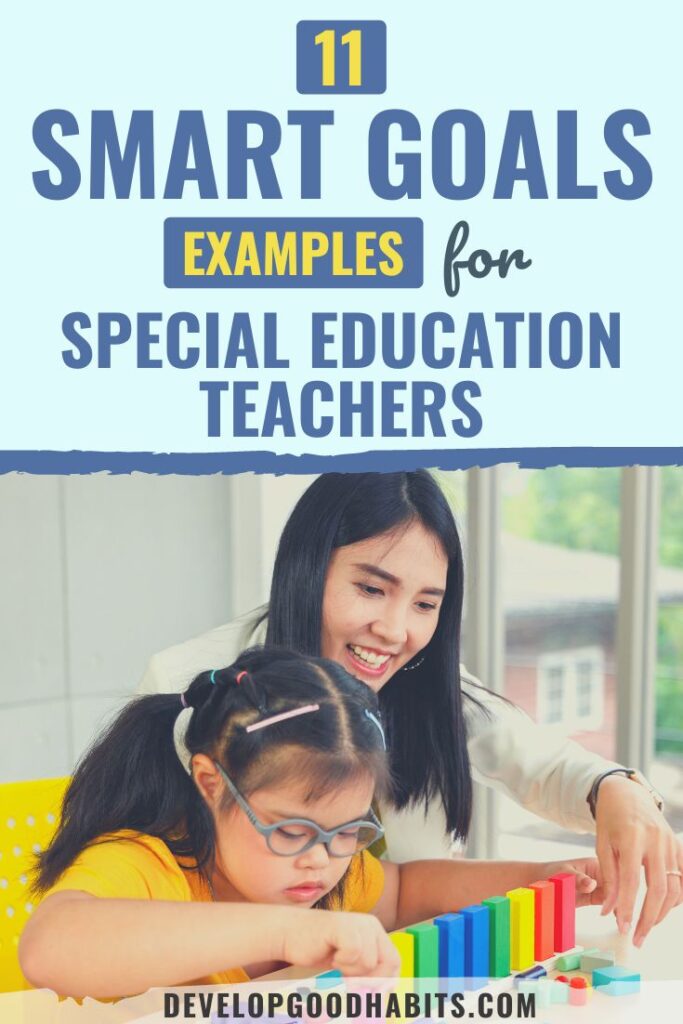

- Resource Room
- Paraprofessionals
- IEP Masterclass
Professional Goals for Special Education Teachers
Every year in our school district (public schools), we're required to submit professional annual goals and our plan to achieve them. These professional development goals may be associated with a content area we were looking to improve in and apply to our current school setting or a long term goal aligned with a degree program. While these goals may vary from one educator to another, there are some common teaching career goals that many special educators strive to achieve.
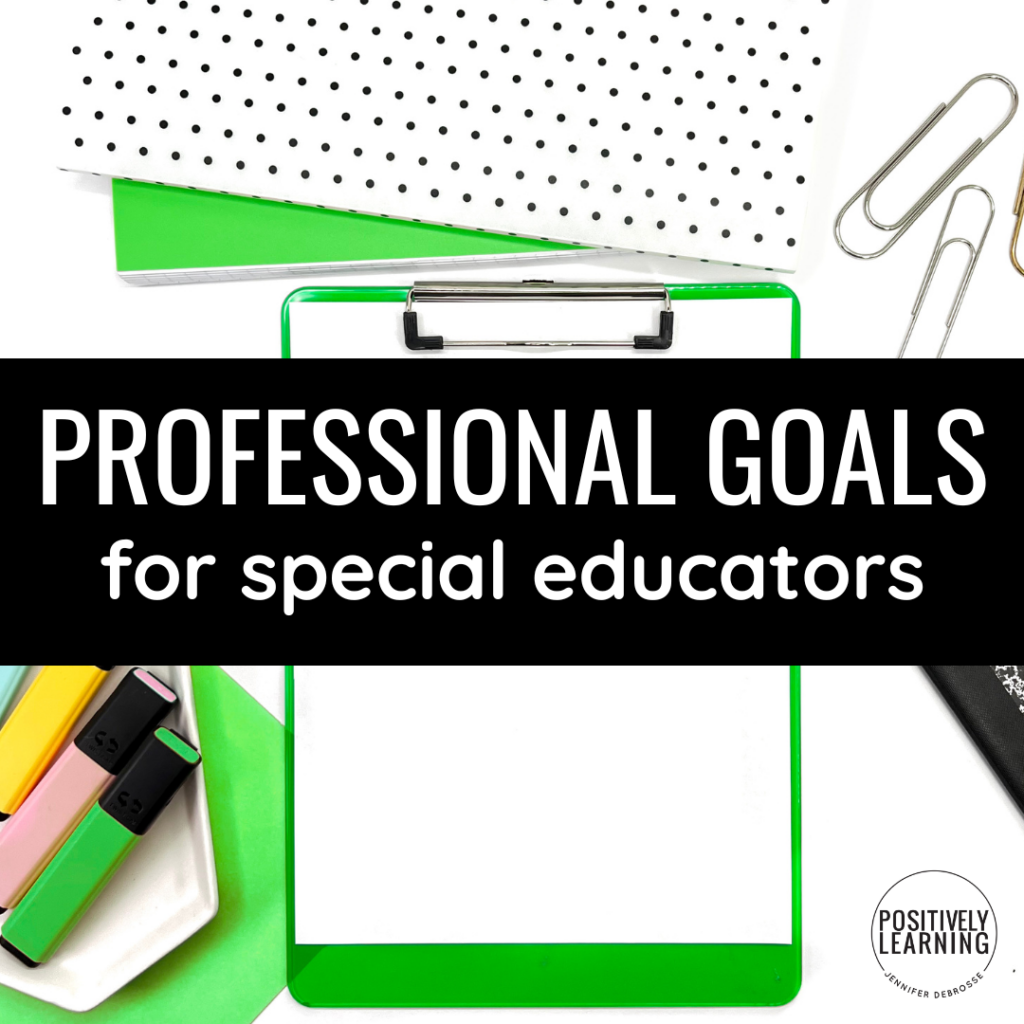
If you're a new special education teacher looking for a bit of inspiration, here are seven ideas for professional goals.
- Improve IEP implementation. One goal that many special education teachers have is to improve the IEP (individualized education program) process. Short term objectives may include steps you'll take to involve more general education teachers, communicate next steps with families, and providing more support in the general education curriculum.
- Help students make progress. Another common goal is to help students make progress on their IEP goals. This may involve exploring different methods for differentiating instruction, using data-driven decision making (progress monitoring), and providing targeted interventions.
- Meet the challenges of the school year. All teachers face challenges during the school year, but special educators often have additional challenges due to the diverse needs of their students. Some common challenges include behavior problems, lack of resources, and time constraints. Special educators may set goals to address these challenges by seek ing out professional development opportunities or collaborating with other professionals in the field.
- Learn about new technologies and how to integrate them into the classroom to support students' needs. Technology has changed tremendously in the past few years, and it is important for teachers to be on top of new trends wther this is in the area of assistive technology or using technolgy as an engagement tool. If this is an area of interest already, this additional information would be helpful to overlap with your annual goals.
- Develop strategies for collaborating with families, community members, and other professionals. A long-term goal may be focused on positive relationship development with key stakeholders. What systems could you put into place to make sure everyone is informed throughout the school year? This goal could involve researching best practices and then gathering the implementation tools.
- Explore new ideas to promote student independence and self-advocacy. Whether you're teaching at the elementary school, middle school, or high school level, student independence is every special education program's top goal. This free webinar shares ideas for implementing a work system in the resource room to promote independence – Check it out here .
- Training and managing support staff to create a positive learning environment. New teachers (and veteran, too) often find themselves in situations with supporting other staff members with little to no preparation. This would be an ideal professional goal since it's an area that would benefit EVERYONE. Here's a fast way to achieve this goal – transform your classroom in a weekend with this mini-course: Positive Paraprofessional Partnerships .
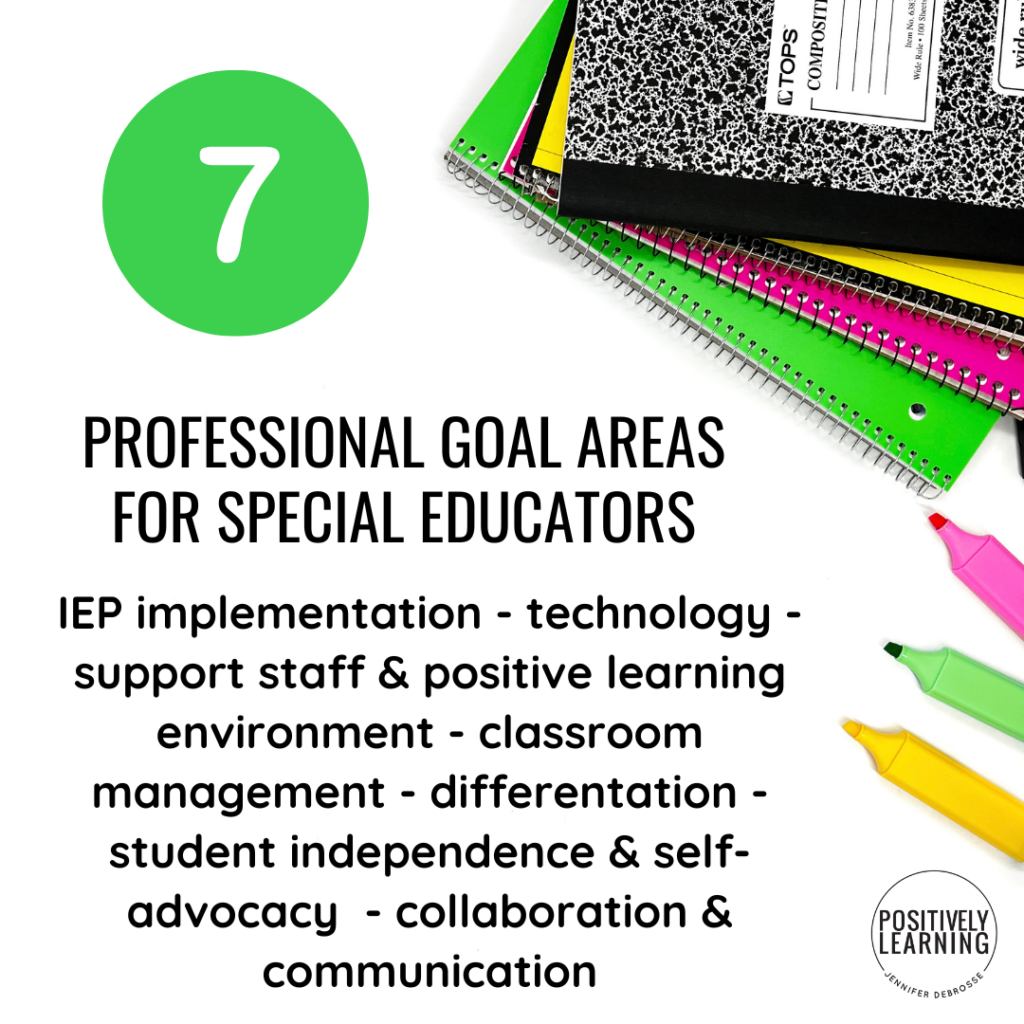
How to Design a Plan to Achieve Professional Goals in Special Education
Now that you've selected a goal that supports your educational needs, what action steps will you take to achieve them?
Especially in already-packed school hours?
Here are some options I've used when constructing my own professional goals – feel free to borrow or mix and match any of these ideas!
- Attend workshops and professional conferences on special education topics. Ongoing participation was something that was already required as a certified special education teacher, so it was beneficial to overlap with my annual goal implementation plan. Don't forget to check out online options, too. There are many webinars and masterclasses available that will hopefully count towards credit. Click here to check out my free masterclass on IEP Data Tracking .
- Read professional books and articles. Is there a special education book you're already eyeing? If you're having a hard time fitting in more workshops, a book study spread out throughout the school year may be more feasible. Choose a book that closely aligns with your professional interests, i.e.: classroom management, developing effective lesson plans, and understanding severe disabilities. Many of these titles may already have a set of critical thinking questions available as a book companion.
- Observe other special education programs. This is my favorite way to learn! Is there another special education classroom setting in your school or district? If you're an inclusion specialist, you may benefit from observing self-contained classrooms or networking with a resource room teacher. Another idea is to look beyond the classroom and schedule a consultation with occupational therapists or social workers. These professional relationships can help develop the “bigger picture” as we look for the best ways to support our students.
- Continuing formal education. In your first years of your career, you may already be required to earn continuing education credits. It's already such a busy time, so I highly recommend checing our the syllabus and aligning your professional goals with something you'll already be focused on throughout the school year. This should already be thoughtffully planned study, so there's no need to add MORE to your plate.
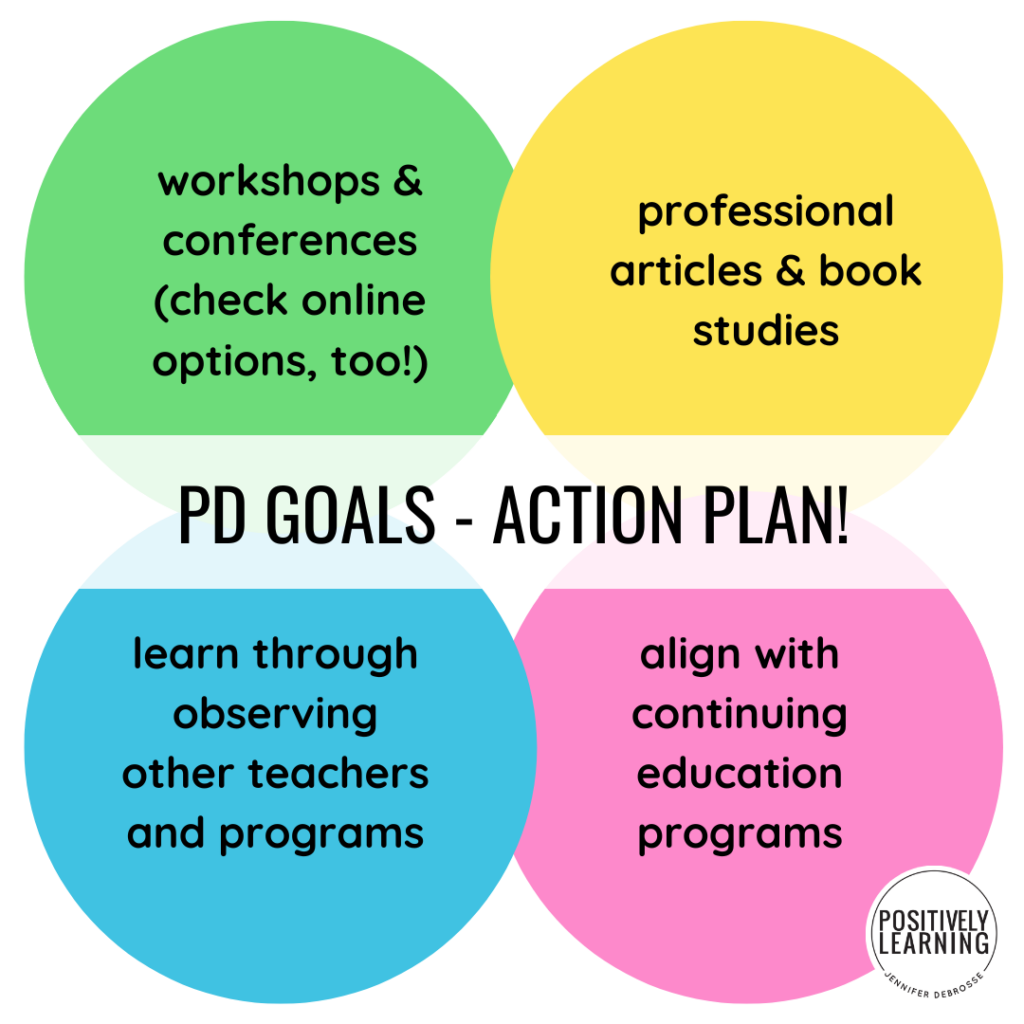
While there are many goals you could set for your professional development this school year, these seven ideas are a great place to start. And the best part is that they don’t require a lot of time or energy to implement. My biggest piece of advice is to choose a topic you're either already focused on or aligned with your professional interests.
I can't wait to hear which goal you're choosing! Leave a comment below on which goal you’ll be focusing on this school year.

I'm Jennifer!
I’m Jennifer and I was a special educator in the elementary school setting over the past decade. I entered the classroom every day dedicated to making learning inclusive AND engaging.
On the Blog

In the Shop
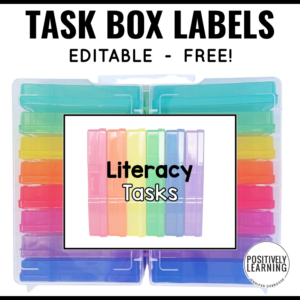
Task Boxes Free Labels for Classroom Organization

IEP Progress Report Card Comments

Classroom Routine Rubrics

- Privacy Policy
- Special Education
- Reading Intervention
- Organization
- More Topics
- Data Collection
- Teacher Gifts
- Shop on TPT
- Free-Sources
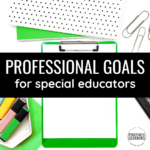
Differentiation delivered to your inbox
This website uses cookies to ensure you get the best experience on our website. See full disclosure here.
Join Pilot Waitlist

Home » Blog » General » Growth Mindset for Special Education: Activities and Discussions

Growth Mindset for Special Education: Activities and Discussions
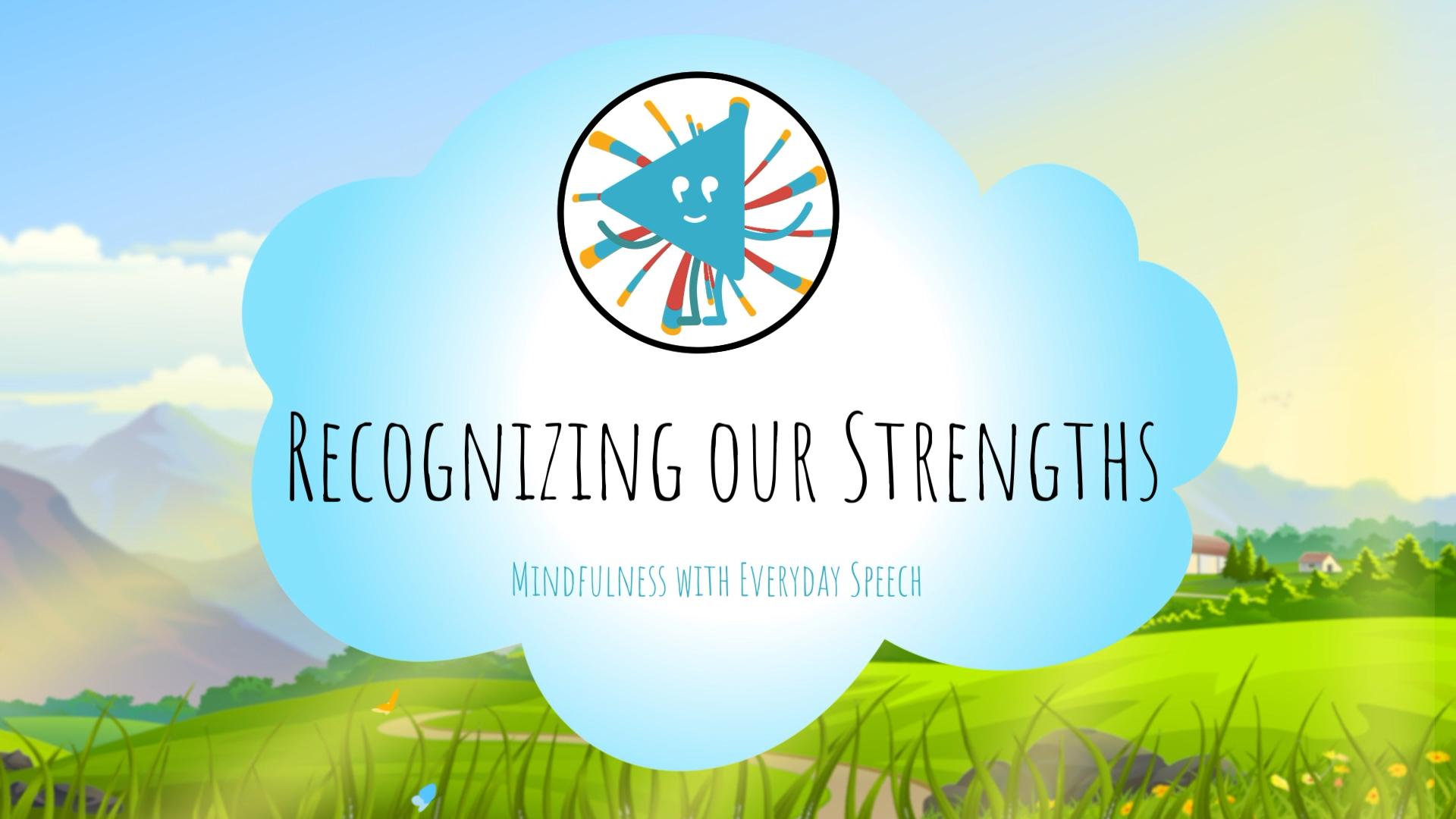
Introduction
For students in special education, developing a growth mindset can be a game-changer. With a growth mindset, they believe that their abilities can improve over time, turning weaknesses into strengths. This belief in personal growth can lead to increased motivation, perseverance, and ultimately, success. In this blog post, we’ll explore an easy no-prep activity, discussion questions, and related skills to help educators promote a growth mindset in their students.
No-Prep Activity: The Power of ‘Yet’
This simple activity requires no preparation or materials and helps students understand the importance of adding the word ‘yet’ to their self-assessments. Here’s how it works:
- Ask students to think of a skill they want to improve or something they struggle with.
- Have them create a sentence describing their current ability, such as “I’m not good at math.”
- Now, ask them to add the word ‘yet’ to the end of their sentence, transforming it into “I’m not good at math, yet.”
By adding ‘yet,’ students shift their perspective from a fixed mindset to a growth mindset, opening the door for improvement and development. Encourage students to practice this exercise regularly, both in and out of the classroom.
Discussion Questions
Use these questions to stimulate further discussions about growth mindset among your students:
- Can you think of a time when you believed you couldn’t do something but eventually succeeded? How did your mindset change?
- Why do you think it’s important to have a growth mindset, especially in special education?
- How can you apply the concept of ‘yet’ to other areas of your life, such as personal relationships or hobbies?
- What strategies can you use to remind yourself to maintain a growth mindset when faced with challenges?
- How can we support each other in developing and maintaining a growth mindset?
Related Skills
Developing a growth mindset is just one aspect of Social-Emotional Learning. Here are some other relevant skills that can help students in special education:
- Goal-setting: Encourage students to set realistic, achievable goals for themselves and track their progress.
- Self-awareness: Help students identify their strengths, weaknesses, and areas for improvement.
- Resilience: Teach students how to bounce back from setbacks and develop coping strategies to overcome challenges.
- Empathy: Foster a supportive classroom environment where students learn to understand and appreciate the feelings and perspectives of others.
Ready to incorporate growth mindset principles and other Social-Emotional Learning skills into your special education classroom? Sign up for free sample materials at Everyday Speech and explore a wide range of resources designed to support your students’ growth and development. By incorporating these skills into your teaching, you can empower your students to believe in their abilities and reach their full potential.

Related Blog Posts:
Changing the channel on big emotions: a guide for educators.
Introduction Emotions and feelings are an inherent part of our daily experiences, and they can be both positive and negative. Sometimes, we encounter big, negative emotions like anger, frustration, or sadness, which can dominate our thoughts and impact our...
Teaching Conflict Resolution and Problem Solving Skills to Special Education Students
Introduction Conflicts are a normal part of life, and learning how to navigate them is an essential skill for students in Special Education. In this blog post, we will discuss the importance of teaching students to handle conflicts with friends using the Problem...
5 Golden Rules of Play for Elementary Students: A Guide for Educators
Introduction Playing with others is an essential part of children's development, and establishing a set of guidelines can help ensure that everyone has a positive experience. The Five Golden Rules of Play are designed to help elementary students learn how to interact...

FREE MATERIALS
Better doesn’t have to be harder, social skills lessons students actually enjoy.
Be the best educator you can be with no extra prep time needed. Sign up to get access to free samples from the best Social Skills and Social-Emotional educational platform.
Get Started Instantly for Free
Complete guided therapy.
The subscription associated with this email has been cancelled and is no longer active. To reactivate your subscription, please log in.
If you would like to make changes to your account, please log in using the button below and navigate to the settings page. If you’ve forgotten your password, you can reset it using the button below.
Unfortunately it looks like we’re not able to create your subscription at this time. Please contact support to have the issue resolved. We apologize for the inconvenience. Error: Web signup - customer email already exists
Welcome back! The subscription associated with this email was previously cancelled, but don’t fret! We make it easy to reactivate your subscription and pick up right where you left off. Note that subscription reactivations aren't eligible for free trials, but your purchase is protected by a 30 day money back guarantee. Let us know anytime within 30 days if you aren’t satisfied and we'll send you a full refund, no questions asked. Please press ‘Continue’ to enter your payment details and reactivate your subscription
Notice About Our SEL Curriculum
Our SEL Curriculum is currently in a soft product launch stage and is only available by Site License. A Site License is currently defined as a school-building minimum or a minimum cost of $3,000 for the first year of use. Individual SEL Curriculum licenses are not currently available based on the current version of this product.
By clicking continue below, you understand that access to our SEL curriculum is currently limited to the terms above.
- IEP Goal Tracking
- IEP Data Collection
- IEP Compliance
Easily Track IEP Goals and Monitor IEP Progress

Progress Monitoring for Individualized Education Program (IEP) Goals is a critical process in special education that tracks and evaluates the progress of students with disabilities toward their customized educational goals. It involves collecting and analyzing data on specific skills and behaviors outlined in the student's IEP.
Progress monitoring helps determine if instructional strategies and interventions are effective, identifies areas that need additional support or modifications, and facilitates collaboration among the IEP team. It aims to ensure students with disabilities make meaningful progress and achieve their educational objectives.
This commitment to student progress aligns with the provisions of the Individuals with Disabilities Education Act (IDEA) . This federal law ensures that students with disabilities in the United States receive a free and appropriate public education. It also provides personalized education plans, accommodations, and related services based on individual needs.
For example , a student with autism named Emma receives an Individualized Education Program (IEP) that includes specific goals, accommodations, and therapy services to support her academic and social development. In addition, IDEA promotes parental involvement and progress monitoring to ensure students with disabilities have equal access to education and the opportunity to reach their full potential.
Let’s go through the following steps that outline how to monitor a student’s progress-
1. Measurable IEP Goals-
Measurable IEP goals are specific, attainable objectives in a legally binding document for students with special education needs. They provide clear criteria to assess progress and allow growth tracking over time. These goals are essential for determining meaningful progress and adjusting instruction or interventions.
For instance, a measurable goal could be "By the end of the school year, Sophia will increase her reading fluency from 50 to 80 words per minute as measured by weekly timed reading assessments." This goal is specific, indicating the targeted area (reading fluency), the desired improvement (from 50 to 80 words per minute), the timeframe (by the end of the school year), and the measurement tool (weekly timed reading assessments). It provides a clear benchmark for evaluating Sophia’s progress.
On the other hand, a non-measurable goal might be "James will do his best in math class." While this goal expresses good intentions, it needs more specificity and objectivity. It needs to provide a clear standard or measurement criteria to assess James's progress.
2. Collect Baseline Data -
Collecting baseline data in special education involves gathering information about a student's current skills, abilities, and performance levels related to specific goals or objectives outlined in their Individualized Education Program (IEP).
For example, a special educator may administer a reading assessment to determine a student's baseline performance in reading fluency. The assessment involves measuring the number of words read correctly per minute. The baseline data could show that the student reads 60 words per minute.
With this baseline data, the educator can set measurable student progress goals. For instance, the goal might be to increase the student's reading fluency to 100 words per minute by the end of the school year. By regularly monitoring the student's progress and comparing it to the baseline data, the educator can assess whether the student is making meaningful progress toward the goal.
3. Collect Data on IEP Goals-
Educators , special education teachers , and related service providers like paraprofessionals and therapists who directly engage with students in special education take charge of collecting data for progress monitoring purposes.
To ensure effective progress monitoring, educators should regularly collect data on each IEP goal, following a predetermined schedule. As mandated by IDEA regulations, this schedule should be documented by the IEP team, specifying the frequency of monitoring (e.g. every two weeks, monthly).
For example, a student named Alex with an IEP goal focused on improving their reading comprehension skills. The IEP team determines that progress monitoring for this goal will occur every two weeks. Following the established schedule, the educator administers a reading comprehension assessment to Alex every two weeks to gather data on their progress.
During each assessment, the educator may use reading passages or comprehension questions to evaluate Alex's understanding and retention of the text. Then, they carefully record and analyze the results, noting the specific area of improvement and any challenges Alex faces.
When faced with challenges in collecting data on Individualized Education Program (IEP) goals, adopting a digital platform like AbleSpace can address challenges in collecting data on IEP goals.
It offers streamlined data collection, increased efficiency, and improved accuracy, benefiting educators and professionals by supporting progress monitoring and enhancing the reliability of the data.
4. Create a Graph-
Creating a graph of progress monitoring IEP goals is a valuable tool in special education to represent a student's progress over time visually. Educators can track and measure students' growth by graphing data points, identifying trends, and making data-informed decisions to support their educational needs.
Example: a student named Jack with an IEP Goal related to reading fluency. The goal states, "Jack will read 80 words per minute with 90% accuracy by the end of the school year."
The educator collects data on Jack's reading fluency throughout the year using weekly assessments. The data is recorded and plotted on a graph with time on the x-axis and words per minute on the y-axis. As the week progresses, the graph's data points represent Jack's reading fluency scores.
By analyzing the graph, the educator can observe the trend of Jack's progress. They can identify if Jack is consistently improving, plateauing, or facing challenges in reaching the goal. This information can guide instructional decisions, interventions, and support to help Jack achieve the desired reading fluency level.
If you need help creating a graph for progress monitoring of Individualized Education Program (IEP) goals, utilizing a digital platform like AbleSpace can be invaluable. AbleSpace provides a user-friendly interface and tools specifically designed to assist in creating visually appealing and informative graphs.
5. Review Data
Reviewing data is crucial in special education to assess students' progress toward their individualized education program (IEP) goals. By regularly reviewing and analyzing the collected data, educators can gain valuable insights into a student's growth, identify areas of strength and improvement, and make informed decisions to support their educational needs effectively.
Example: a student named Emily with an IEP goal related to writing skills. The goal states, "Emily will independently write a coherent paragraph with proper grammar and punctuation."
The educator collects data on Emily's writing skills by reviewing her written assignments throughout the school year. First, they assess each paragraph's coherence, grammar, and punctuation and record the data. Then, they compare the data points to the baseline data and previous assessments to track Emily's progress.
During the data review, the educator notices that Emily's writing skills have improved in coherence and grammar, but there are still areas for punctuation improvement. Based on this analysis, the educator can plan targeted interventions and provide specific feedback to Emily to address the punctuation challenges.
If you encounter challenges when reviewing data related to the progress monitoring of Individualized Education Program (IEP) goals, AbleSpace, enables educators and professionals to access and review data conveniently.
6. Progress Report-
The process of creating a progress report entails the following steps-
- Begin by reviewing the student's individualized education program (IEP) goals to gain a clear understanding of the specific objectives.
- Gather student progress data using assessments, observations, and work samples.
- Analyze the data to identify patterns, strengths, and improvement areas.
- Assess the student's progress about each goal, comparing it to baseline data or previous reports.
- Finally, provide detailed feedback and evaluate the level of achievement for each goal.
Determining the Frequency of Monitoring IEP Progress-
Monitoring IEP progress should occur regularly and continuously throughout the academic year.
The frequency of monitoring may vary depending on factors such as the student's needs and goals. However, it is important to adhere to the timeline specified in the IEP and maintain open communication with parents and the IEP team.
Regular monitoring allows for tracking progress and identifying areas needing adjustment or intervention and ensures that the educational program remains responsive to the student's needs.
Engaging Parents in Progress Updates
Communicating progress to parents is vital to progress monitoring in special education. Regular and effective communication ensures that parents are well-informed about their child's development, achievements, and areas needing improvement.
By effectively communicating progress to parents, special education professionals can build trust, strengthen partnerships, and work together to provide the best possible support for the student's educational journey.
Members of the IEP Progress Monitoring Team-
1. Special Education Teacher
2. Parents/Guardians
3. School Administrators
4. School Psychologist
5. Speech-Language Pathologist
6. General Education Teacher
7. Occupational Therapist
8. Other specialists
Effortless IEP Goal Tracking and Progress Monitoring-
If you're looking for a convenient solution to track IEP Goals and monitor the progress that allows IEP teams to reprint goals easily and provide space for teachers and service providers to document data, the IEP goal-tracking website AbleSpace is designed to simplify progress monitoring and ensure clear and accessible data tracking for your convenience.
Team AbleSpace
Recommended for you.

IEP Data Collection Sheets Vs Special Ed Software: What’s Better
How to Involve Students in Special Education IEPs

Special Ed Process Under IDEA: A Comprehensive Guide
No results for your search, please try with something else.
NASET.org Home Page
Exceptional teachers teaching exceptional children.
- Overview of NASET
- NASET Leadership
- Directors' Message
- Books by the Executive Directors
- Mission Statement
- NASET Apps for iPhone and iPad
- NASET Store
- NASET Sponsors
- Marketing Opportunities
- Contact NASET
- Renew Your Membership
- Membership Benefits
- Frequently Asked Questions
- Membership Categories
- School / District Membership Information
- Gift Membership
- Membership Benefit for Professors Only
- NASET's Privacy Policy
- Forgot Your User Name or Password?
- Contact Membership Department
- Resources for Special Education Teachers
- Advocacy (Board Certification for Advocacy in Special Education) BCASE
- Board Certification in Special Education
- Inclusion - Board Certification in Inclusion in Special Education (BCISE) Program
- Paraprofessional Skills Preparation Program - PSPP
- Professional Development Program (PDP) Free to NASET Members
- Courses - Professional Development Courses (Free With Membership)
- Forms, Tables, Checklists, and Procedures for Special Education Teachers
- Video and Power Point Library
- IEP Development
- Exceptional Students and Disability Information
- Special Education and the Law
- Transition Services
- Literacy - Teaching Literacy in English to K-5 English Learners
- Facebook - Special Education Teacher Group
- NASET Sponsor's Products and Services
- ADHD Series
- Assessment in Special Education Series
- Autism Spectrum Disorders Series
- Back to School - Special Review
- Bullying of Children
- Classroom Management Series
- Diagnosis of Students with Disabilities and Disorders Series
- Treatment of Disabilities and Disorders for Students Receiving Special Education and Related Services
- Discipline of Students in Special Education Series
- Early Intervention Series
- Genetics in Special Education Series
- How To Series
- Inclusion Series
- IEP Components
- JAASEP - Research Based Journal in Special Education
- Lesser Known Disorders
- NASET NEWS ALERTS
- NASET Q & A Corner
- Parent Teacher Conference Handouts
- The Practical Teacher
- Resolving Disputes with Parents Series
- RTI Roundtable
- Severe Disabilities Series
- Special Educator e-Journal - Latest and Archived Issues
- Week in Review
- Working with Paraprofessionals in Your School
- Author Guidelines for Submission of Manuscripts & Articles to NASET
- SCHOOLS of EXCELLENCE
- Exceptional Charter School in Special Education
- Outstanding Special Education Teacher Award
- Board Certification Programs
- Employers - Job Posting Information
- Latest Job Listings
- Professional Development Program (PDP)
- Employers-Post a Job on NASET
- PDP - Professional Development Courses
- Board Certification in Special Education (BCSE)
- Board Certification in IEP Development (BCIEP)
- NASET Continuing Education/Professional Development Courses
- HONOR SOCIETY - Omega Gamma Chi
- Other Resources for Special Education Teaching Positions
- Highly Qualified Teachers
- Special Education Career Advice
- Special Education Career Fact Sheets
- FAQs for Special Education Teachers
- Special Education Teacher Salaries by State
- State Licensure for Special Education Teachers
- Determining Measurable Annual Goals in an IEP
National Association of
Special Education Teachers
THE PRACTICAL TEACHER
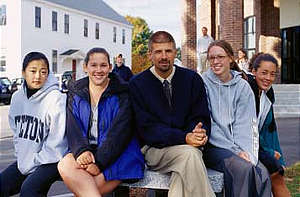
This Weeks Topic:
How to Determine Measurable Annual
Goals in an IEP
(Including Academic and Functional Goals)
The term `individualized education program' or `IEP' means a written statement for each child with a disability that is developed, reviewed, and revised in accordance with this section and that includes
(II) a statement of measurable annual goals, including academic and functional goals, designed to-- (aa) meet the child's needs that result from the child's disability to enable the child to be involved in and make progress in the general education curriculum; and (bb) meet each of the child's other educational needs that result from the child's disability
Annual goals are statements that identify what knowledge, skills and/or behaviors a student is expected to be able to demonstrate within the period of time beginning with the time the IEP is implemented until the next scheduled review. Annual goals must be identified that meet the student s needs, as identified in the present levels of performance.
A goal is a measurable statement that describes what a child is reasonably expected to accomplish from the specialized educational program during the school year.
Explanation
The academic and functional goals should focus on the learning and behavioral problems resulting from the child's disability and be aligned with state and district performance standards. They should address the needs that are summarized in the statement of the child's present levels of academic achievement and functional performance. For those students taking alternate assessment, there should be at least one goal, with corresponding objectives or benchmarks, for each area of need.
The goals and objectives or benchmarks provide a mechanism for determining whether the child is progressing in the special education program and the general education curriculum, and whether the placement and services are appropriate to meet the child's identified educational needs (20 USC 1414 d 1 A i II).
Individual need determinations (i.e., present levels of performance and individual needs) must provide the basis for written annual goals. The IEP must list measurable annual goals, consistent with the student s needs and abilities to be followed during the period beginning with placement and ending with the next scheduled review by the Committee (effective dates of the IEP).
For each annual goal, the IEP must indicate the benchmarks and/or short-term instructional objectives and evaluative criteria, evaluation procedures and schedules to be used to measure progress toward the annual goal. The benchmarks or short-term instructional objectives must be measurable, intermediate steps between present levels of educational performance and the annual goals that are established for a student with a disability.
The measurable annual goals, including benchmarks or short-term objectives, must be related to:
- meeting the student s needs that result from the student s disability to enable the student to be involved in and progress in the general curriculum (or for preschool students, in appropriate activities); and
- meeting each of the student s other educational needs that result from the student s disability.
Measurable annual goals set the general direction for instruction and assist in determining specific courses, experiences, and skills a student will need to reach his or her vision. There must be a direct relationship between the goal and the needs identified in the PLEP. Goals also are descriptions of what a student can reasonably be expected to accomplish within one school year.
A goal must be meaningful, measurable, able to be monitored, and useful in decision making. The annual goal is meaningful if it specifies a level of performance and an expectation that is reasonable; the skill or knowledge the goal represents is necessary for success in school and post-school activities; and the family believes the accomplishment of the goal is important. The goal is measurable if it reflects performance or behavior that can be measured or observed.
A goal is able to be monitored it there are multiple increments in performance between the present levels of performance and the criteria stated in the goal. The goal should be written so that it can be monitored frequently. Finally, the goal is useful in making decision regarding the student s education and the effectiveness of the student s IEP.
To meet the requirements of this part, the IEP team reviews and analyzes the present levels of educational performance and then writes an applicable annual goal for each area of need described. Goals must be written to enable the student to be involved in and progress in the general curriculum and to advance in other areas of educational need.
The IEP team writes annual goals that:
- show a direct relationship to the present levels of educational performance;
- describe only what the student can reasonably be expected to accomplish within one school year or the 12-month term of the IEP;
- are written in measurable terms;
- prepare the student for his or her desired post-school activities, when planning for the school-to-adult life transition; and
- The goal must include at least three parts:
1. expected change in performance-specifies the anticipated change in performance from a baseline and usually reflects an action or can be directly observed; 2. proposed area of change- identifies skill, knowledge, understanding or behavior; and 3. proposed criteria specify the amount of growth, how much and how frequent, or to what standard or level of proficiency.
Principles of Formulating Goals for a
Students IEP
When formulating goal statements, use the
following guidelines:
- Goals should be general statements that focus on deficit skill areas.
- Goals should be designed to address the needs identified in the statement of the child's present level of academic achievement of functional performance.
- Goals should be challenging and describe what a child can reasonably be expected to accomplish during the school year.
- All members of the IEP Team should easily understand the language of the goals.
- Goals should be written to increase the child's successful participation in the general education curriculum and allow for inclusion in the general education environment to the maximum extent appropriate, or for preschool children, to participate in appropriate activities with non-disabled peers.
- Goals should be stated so they are meaningful. Helpful questions to ask include:
Is accomplishment of the goal necessary for success in current and future environments? Does the family believe the accomplishment of the goal is important? Does the goal specify a level of performance and expectation that is reasonable? Goals should be measurable; they must reflect behavior that can be measured. Goals should be written so they can be monitored frequently and repeatedly. Goals should be written to enhance decision-making. Monitoring the goal provides data that can be used to determine the effectiveness of the child's educational program. Goals should reflect transition needs, if appropriate.
Step-by-Step procedures for
determining Measurable Annual Goals
Step A: Determine the Skills the Student
Requires to Master the Content of the
Annual goals should focus on the knowledge, skills, behaviors and strategies to address the student s needs. A student s needs generally relate to domains such as, but not limited to, reading, writing, listening, organization, study skills, communication, physical development, motor skills, cognitive processing, problem-solving, social skills, play skills, memory, visual perception, auditory perception, attention, behavior, and career and community living skills. The goals on a student s IEP should relate to the student s need for specially designed instruction to address the student s disability needs and those needs that interfere with the student s ability to participate and progress in the general curriculum.
Goals should not be a restatement of the general education curriculum (i.e., the same curriculum as for students without disabilities), or a list of everything the student is expected to learn in every curricular content area during the course of the school year or other areas not affected by the student s disability. In developing the IEP goals, the Committee needs to select goals to answer the question: "What skills does the student require to master the content of the curriculum?" rather than "What curriculum content does the student need to master?"
For example, a student may be performing very poorly on written tests in global studies that require written expression. The IEP goal for this student should focus on developing written expressive skills (e.g., using outlines or other strategies to organize sentences in paragraphs) rather than the curriculum goal that the student will write an essay about the economy of a particular country. Generally, goals should address a student s unique needs across the content areas and should link to the standards so that a student has the foundation or precursor skills and strategies needed to access and progress in the curriculum.
Step B: How Far By When?
From information in the present levels of performance, the Committee has identified which need areas must be addressed and where the student is currently functioning in each of those areas. The next step is to identify what the focus of special education instruction will be over the course of the upcoming year. The annual goals will guide instruction, serve as the basis to measure progress and report to parents and serve as the guideposts to determine if the supports and services being provided to the student are appropriate and effective.
An annual goal indicates what the student is expected to be able to do by the end of year in which the IEP is in effect (i.e., the period beginning with placement and ending with the next scheduled review by the Committee). The annual goal takes the student from his/her present level of performance to a level of performance expected by the end of the year.
To be measurable, an annual goal should, in language parents and educators can understand, describe the skill, behavior or knowledge the student will demonstrate and the extent to which it will be demonstrated.
Examples: One year from now, Jim will write 10 sentences with correct punctuation. Terry will ask questions about the instructions or materials presented to ensure comprehension. Tom will use a datebook for appointments and assignments. Terry will solve multi-step word problems. Brianna will stand at least two feet away from the other person while conversing. Lisa will walk 10 feet independently. Mackenzie will speak in complete sentences. Ron will point independently to pictures described. Jose will use word prediction software to write essays.
Terms such as "will improve ," "will increase ." and "will decrease ." are not specific enough to describe what it is the student is expected to be able to do in one year. To be measurable, a behavior must be observable or able to be counted. In general, it is recommended that goals describe what the student will do, as opposed to what the student will not do.
Example: The student will ask for a break from work versus The student will not walk out of the classroom without permission.
Step C: Determine Short-term
instructional objectives
For each annual goal, the IEP must include short-term instructional objectives or benchmarks. The instructional objectives or benchmarks must include evaluative criteria, evaluation procedures and schedules to be used to measure progress toward the annual goal. Short-term objectives and benchmarks should be general indicators of progress, not detailed instructional plans, that provide the basis to determine how well the student is progressing toward his or her annual goal and which serve as the basis for reporting to parents.
Generally, one annual goal would not include both short-term objectives and benchmarks. Whether short-term objectives or benchmarks are used for a particular annual goal is at the discretion of the Committee.
Short-term objectives are the intermediate knowledge and skills that must be learned in order for the student to reach the annual goal. Short-term objectives break down the skills or steps necessary to accomplish a goal into discrete components.
For example, the sequential steps that one student must demonstrate in order for him to reach the annual goal to "remain in his reading class for the entire period and ask for help when the reading work is difficult for him" are as follows:
Grant will be able to identify what upset him after a behavioral disruption. Grant will be able to state the physical signs he is feeling when reading work gets difficult and leads to a behavioral disruption. Grant will raise his hand for assistance when he begins to experience those physical signs.
Step D: Determine Benchmarks
Benchmarks are the major milestones that the student will demonstrate that will lead to the annual goal. Benchmarks usually designate a target time period for a behavior to occur (i.e., the amount of progress the student is expected to make within specified segments of the year).
Generally, benchmarks establish expected performance levels that allow for regular checks of progress that coincide with the reporting periods for informing parents of their child s progress toward the annual goals. For example, benchmarks may be used for this same student for this annual goal as follows:
By November, Grant will remain in his reading class for 15 minutes without disruptions. By February, Grant will remain in class for 25 minutes without disruptions. By April, Grant will remain in his reading class for 35 minutes without disruption. By June, Grant will remain in his reading class for 45 minutes without disruption.
Writing short-term instructional objectives
and benchmarks
The following template may assist in the writing of short-term objectives or benchmarks:
Student will (do what) (to what extent) - (over what period of time) or (by when) as evaluated through ______________ on the following schedule: ___________________.
S. will wait his turn in group games for 3/5 turn-taking activities over three consecutive days as evaluated through teacher charting of the targeted behavior every 4 weeks.
K. will highlight and/or underline important concepts in reading materials on 4 out of 5 trials over a two-week period as evaluated through corrected work in class every 2 months.
By December, J. will initiate his class work when prompted by the teacher within 3 minutes over 10 consecutive trials as evaluated by structured observations of the targeted behavior once a month.
L. will use appropriate phrases to request toys or activities during free play on 5 trials over a 2-week period as evaluated by structured observations every 8 weeks.
D. will wait until all directions are received before beginning activities or assignments as evaluated through teacher charting of the targeted behavior every 4 weeks.
By January, M. will independently remove himself from the situation on all occasions when he is teased by peers during recess as evaluated quarterly by daily self-monitoring checklists.
Short-term objectives or benchmarks: The short-term objectives or benchmarks derive from the annual goals but represent smaller, more manageable learning tasks a child must master on the way to achieving the goals. The purpose of short-term objectives and benchmarks is to enable families, children, and teachers to monitor progress during the year and, if appropriate, revise the IEP consistent with the child's instructional needs. They describe how far the child is expected to progress toward the annual goal and by when. In most cases, at least two objectives or benchmarks should be written for each annual goal. Progress on each short-term objective or benchmark should be documented.
Short-term objectives generally break the skills described in the annual goal into discrete components. Benchmarks describe the amount of progress the child is expected to make in a specified segment of the year. Benchmarks establish expected performance levels that allow for regular checks of progress that coincide with the reporting periods for informing parents of their child's progress toward achieving the annual goals.
Objectives and benchmarks must be measurable; they must use language that will allow a count of what a child does (i.e., The child will write, The child will read). Do not use phrases such as: "The child will understand," or "The child will appreciate").
Step E: Determine the Evaluative
Evaluative criteria identify how well and over what period of time the student must perform a behavior in order to consider it met. How well a student does could be measured in terms such as:
- frequency (e.g., 9 out of 10 trials)
- duration (e.g., for 20 minutes)
- distance (e.g., 20 feet)
- accuracy (90% accuracy)
The period of time a skill or behavior must occur could be measured in terms such as:
- number of days (e.g., over three consecutive days)
- number of weeks (e.g., over a four week period)
- occasions (e.g., during Math and English classes, on six consecutive occasions)
Step F: Determine Evaluation
Procedures to Measure the Student's
Evaluation procedures identify the method that will be used to measure progress and determine if the student has met the objective or benchmark. An evaluation procedure must provide an objective method in which the student s behavior will be measured or observed.
Examples: structured observations of targeted behavior in class; student self-monitoring checklist; written tests; audio-visual recordings; behavior charting; work samples.
Step G: Determine the Evaluation
Schedules to Measure the Student's
Evaluation schedules state the date or intervals of time by which evaluation procedures will be used to measure the student s progress toward the objective or benchmark. It is not a date by which the student must demonstrate mastery of the objective.
Examples: by March 2003, in three months, every four weeks, at the end of the term, quarterly
Short-term objectives and benchmarks should include the following three components to ensure that they can be evaluated:
Objective Criteria that enable progress to be monitored and allow for determination of the point at which the objective has been accomplished, such as: 95% accurate fewer than 5 times per day 50 correct responses in one minute 4 out of 5 trials correct on three consecutive days
Evaluation Procedures to be used, such as: teacher observation written performance oral performance criterion referenced tests parent report observation time sample teacher-made tests
Schedules to determine how often the objective will be measured, such as: one-two weeks twice a week once a month six weeks nine weeks each semester annually
Some examples of possible short-term objectives are listed below. Each objective has numbers corresponding to the three components: (1) objective criteria, (2) evaluation procedure and (3) schedules.
To read a 300 word article in the newspaper (1) in two minutes with 95% accuracy (2) as observed and recorded by the resource teacher (3) once a week.
To create (1) fewer than 5 disruptions per day for three consecutive days (2) as observed and recorded by the teacher's paraprofessional (3) each day.
To achieve (1) 95% accuracy (2) on a teacher made spelling test of seventh grade words as checked by the resource teacher (3) on a weekly basis.
To compose three-paragraph themes comprised of fifteen or more sentences using a word processing program with a spell checker (1) with 80% or better accuracy in the use of spelling, punctuation and grammar over 5 consecutive trials (2) as recorded by the resource teacher (3) weekly.
Step H: Determine How Progress
Toward Annual Goals will be
In accordance with the procedures, methods and schedules to measure a student s progress toward the annual goals, school personnel need to establish a reporting and recording system that ensures that a student s progress is objectively assessed. This information is necessary for reporting progress to parents and for the Committee to review the student s IEP. While reporting progress to parents may require more than a data recording form, Attachment 3 provides a supplemental form, as shown below, for school personnel to use to track each student s progress toward meeting the annual goals.
Questions and Answers about
Annual Goals
Q: For each identified present level of
performance, must there be annual goals?
A: Yes--For each identified present level of performance, there must be at least one annual goal specified. These goals and subsequent objectives form the basis for the curriculum and specially designed instruction provided to the student. They are, therefore, written in terms of what the student will achieve. They should not be written in terms of what a parent or service provider will provide to the student.
Annual goals state the anticipated achievement expected within a 12 month period of time, although they can be written for a shorter period. In developing annual goals the present level of educational performance must be considered. Annual goals must not be a restatement of the present levels of performance. Yet anyone reviewing the IEP should be able to clearly determine the direct relationship between the two.
Measurable annual goals, including benchmarks or short-term objectives, are critical to the strategic planning process used to develop and implement the IEP for each child with a disability. Once the IEP team has developed measurable annual goals for a child, the team (1) can develop strategies that will be most effective in realizing those goals and (2) must develop either measurable, intermediate steps (short term objectives) or major milestones (benchmarks) that will enable parents, students, and educators to monitor progress during the year, and if appropriate, to revise the IEP consistent with the student s instructional needs.
The strong emphasis on linking the educational program of children with disabilities to the general curriculum is reflected in 300.347(a)(2), which requires that the IEP include: a statement of measurable annual goals, including benchmarks or short term objectives, related to (i) meeting the child s needs that result from the child s disability to enable the child to be involved in and progress in the general curriculum; and (ii) meeting each of the child s other educational needs that result from the child s disability. (Federal Register, Friday, March 12, 1999, Question 1, p. p. 12471).
Q: Must the measurable annual goals
address all areas of the general curriculum
or only those areas in which the student's
involvement and progress are affected by
his/her disability?
A: Areas of the general curriculum that are not affected by the student s disability do not need to be specifically addressed in the IEP. Annual goals should address areas of the general curriculum that are directly affected by the students disability. Accommodations and modifications may be needed for the student to participate in other areas of the general curriculum.
The school district.... is not required to include in an IEP annual goals that relate to areas of the general curriculum in which the student s disability does not affect the child s ability to be involved in and progress in the general curriculum. If a child with a disability needs only modifications or accommodations in order to progress in an area of the general curriculum, the IEP does not need to include a goal for that area; however, the IEP would need to specify those modifications or accommodations. School districts often require all children, including children with disabilities, to demonstrate mastery in a given area of the general curriculum before allowing them to progress to the next level or grade in that area. Thus, in order to ensure that each child with a disability can effectively demonstrate competencies in an applicable area of the general curriculum, it is important for the IEP team to consider the accommodations and modifications that the child needs to assist him or her in demonstrating progress in that area. (Federal Register, Friday, March 12, 1999, Question 4, p.12472)
Q: What are short term objectives or
benchmarks?
A: Short term objectives or benchmarks are measurable, intermediate steps between an individual s present level of performance and the annual goal. Objectives should be based on a logical breakdown of the annual goal and reflect advancement toward that goal. They therefore must be provided for each area in which present levels of performance and annual goals have been stated..... each annual goal must include either short-term objectives or benchmarks. The purpose of both is to enable a child s teacher(s), parents and others involved in developing and implementing the child s IEP, to gauge, at intermediate times during the year, how well the child is progressing toward achievement of the annual goal. IEP teams may continue to develop shortterm instructional objectives, that generally break the skills described in the annual goal down into discrete components. The revised statute and regulations also provide that, as an alternative, IEP teams may develop benchmarks, which can be thought of as describing the amount of progress the child is expected to make within specified segments of the year. Generally, benchmarks establish expected performance levels that allow for regular checks of progress that coincide with the reporting periods for informing parents of their child s progress toward achieving the annual goals.
An IEP team may use either short term objectives or benchmarks or a combination of the two depending on the nature of the annual goals and needs of the child. (Federal Register, Friday, March 12, 1999, Question 1, p. 12476).
Q: Can short term objectives or benchmarks
be changed without initiating another IEP
A: No. If either a parent or the school district believes that a required component of the student s IEP should be changed, the school district must conduct an IEP meeting if it believes that a change in the IEP may be necessary . (Federal Register, Friday, March 12, 1999, Question 20, p. 12471).
Since short term objectives, benchmarks, and annual goals are required components of the IEP, a meeting must be held with all required team members if any of these are going to be changed. The team will then make the needed changes in the IEP and thus a new IEP will have been developed. There is no such thing as an addendum to an IEP allowed under IDEA.
Measurable Annual Goals and Short-
Term Instructional
Objectives/Benchmarks
Annual Goal: Kevin will accurately interpret graphs and charts to solve grade-level mathematical problems.
Evaluation Instructional Objectives or Benchmarks:
Criteria: Kevin will use manipulatives to reproduce graphs and charts to solve math problems. 4/5 times over 2 weeks Procedures: Classroom assignments, Tests Schedule: Every 4 weeks
Criteria: Kevin will highlight the large print graphs and charts to increase the contrast between the various parts of the graph, in order to solve math problems. 4/5 times over 2 weeks Procedures: Classroom assignments, Tests Schedule: Every 4 weeks Criteria: Kevin will verbally describe the material presented on graphs and charts to the teacher, in order to solve the problem. 4/ 5 times over 2 weeks Procedures: Classroom assignments, Tests Schedule: Every 4 weeks
Annual Goal: Kevin will use graphic organizers to write a three-paragraph essay using correct sequencing of sentences including topic sentence, supporting sentences and conclusion.
Criteria: Kevin will use graphic organizers to write a three sentence paragraph using correct sequencing of sentences including topic sentence, supporting sentences and conclusion with assistance by November. 5/5 times over 2 weeks Procedures: Writing sample, Tests, Classroom assignments Schedule: Every 6 weeks Criteria: Kevin will use graphic organizers to write a five sentence paragraph using correct sequencing of sentences including topic sentence, supporting sentences and conclusion with assistance by January. 4/ 5 times over 2 weeks Procedures: Writing sample, Teacher observation, Classroom assignments Schedule: Every 6 weeks Criteria: Kevin will use graphic organizers to write a two paragraph essay using correct sequencing of sentences including topic sentence, supporting sentences and conclusion without assistance by March. 4/5 times over 2 weeks Procedures: Writing sample, Teacher observation Schedule: Every 6 weeks Criteria: Kevin will use graphic organizers to write a threeparagraph essay using correct sequencing of sentences including topic sentence, supporting sentences and conclusion without assistance by June. 4/ 5 times over 2 weeks Procedures: Writing sample, Tests, Classroom assignments Schedule: Every 6 weeks
NASET Members: As always, we are interested in meeting your needs for information. If you have a topic suggestion for the Practical Teacher email us at [email protected] with the subject :Practical Teacher Topic Suggestion.
Publications
- Utilizing the Token Economy in a Special Education Classroom
- What Happens When Children Who Do Not Respond to or Struggle Greatly with Phonics, More of the Same?
- Combining Phonics and Whole Language for Reading Instruction
- Utilizing the Math Routine, “Would You Rather,” to Support Meaningful Classroom Interaction for ALL Students
- Teaching Self-Advocacy Skills to Students with Autism and Other Disabilities
- How Rhyming and Rappin’ Can Improve Reading and Writing: Improving Poetic Intelligence
- U.S. Department of Education Releases New Resource on Supporting Child and Student Social, Emotional, Behavioral and Mental Health during COVID-19 Era
- How Spelling Can Help Reading Learning Common Core Words Quickly and Easily
- Special Advice for Special Educators
- An Alignment of Interactive Notebooks with the Principles of Universal Design
- Comparing and Contrasting Research-to-Teaching Practices: A Critical Analysis of Highly Restrictive Special Education Placements for Students with Low-Incidence Disabilities
- Parental Involvement within Culturally and Linguistically Diverse Families: Misconceptions, Barriers, and Implications
- The Effects of Parent Therapy for Disruptive Behaviors: A Review of the Literature
- Children’s Literature + DI + UDL + Mathematics = Success for Students with Disabilities
- Positive Student-Teacher Relationships: An In-Depth Look into a Behavior Program and its Implications for Teachers of Students with EBD
- A Classroom Without Walls: A New Method for Teaching Life Skills
- 7 Things Secondary Special Education Teachers Need to Know Concerning Career Technical Education
- Understanding and Achieving Collaboration in Special Education*
- Intervention for Struggling Writers in Elementary School: A Review of the Literature
- Fire Safety: How to Teach An Essential Life Skill
- Reciprocal Peer Tutoring: A Review of the Literature
- A Collaborative Approach to Managing Challenging Behaviors of Students with Disabilities: A Review of Literature
- Students with Disabilities in Postsecondary Institutions: What Higher Education Should Be Doing to Support Them
- Hospitality in an Inclusive Classroom
- UDL and Art Education for Students with Disabilities and Physical Impairments
- Truly Experiencing Teaching and Learning for the First Time: Snails are Introduced to a Community of Learners Patricia Mason, Ed.D.
- Disproportionate Representation of English Language Learners (ELLs) in Special Education Programs
- 1+1= iPad Math Apps for Teachers
- Using Music to Teach Reading to Kindergarten Students
- Creating a Classroom for Diverse Learners
- The Challenges of Special Education for Parents and Students: A Literature Review By Reshma Mulchan
- Transitioning From School to the Workplace for Students with Disabilities By: Dr. Faye J. Jones
- Practical Social Skills for Special Education Students
- Effective Communication for Students with Hearing, Vision, or Speech Disabilities in Public Elementary and Secondary Schools
- Educational Services for Immigrant Children and Those Recently Arrived to the United States
- Resources within the Medical and Health Care Community
- Inquiry - Based Learning: Special Education Applications By Jillian F. Swanson
- Intensifying Intervention By Peter Dragula, M.Ed., Doctoral Candidate Capella University
- Special Education Research: Where to Start?
- Intellectual Disabilities in Your Classroom: 9 Tips for Teachers
- Common Core State Standards - Overview
- Multiple Disabilities in Your Classroom: 10 Tips for Teachers
- Supports, Modifications, and Accommodations for Students with Disabilities
- The Five Secrets to Being a Special Education Teacher and Still Loving Your Job
- Bridging the Great Divide: Best Practice Ideas for the Resource/Inclusion Teacher
- Enjoying Favorite Books with Struggling Readers: Part 2
- Trauma Informed Teaching in Special Education By: Joshua A. Del Viscovo, M.S., B.C.S.E.
- Enjoying Favorite Books with Struggling Readers: Part I
- A Proper Fraction Museum
- A Review of Financial Literacy Programs for K-12 Students with Intellectual Disabilities: Utilizing the Principles of Universal Design for Learning
- Winnowing the Internet: Websites for Teachers of Students with Moderate to Severe Disabilities
- Students Who Have Difficulty Learning to Read with Phonics
- Positive Communication Strategies for Collaborating with Parents of Students with Disabilities
- Five Aspects of Teacher influence on Student Behavior
- Teaching Students with Emotional and Behavioral Disabilities (EBD)
- A Primer on Behavior Management
- Is There Only One Way to Teach Reading? Learning to Read in a Different Way
- Anxiety Disorders by Robin Naope Student at Chaminade University Hawaii
- Schedule A Hiring Authority: Tips for Youth and Young Adults with Disabilties Interested in Starting a Career with the Federal Government
- Trusting Information Resources
- College Planning for the Child with Special Needs: A Parent and Teacher Collaboration
- Latin and Greek Word Root Study to Accelerate Spelling, Vocabulary, and Reading Proficiency for All Students
- Dignity, Function, & Choice: Ethical and Practical Considerations on Best Practices for Education Learners with Developmental Delays
- Peer Tutoring: A Strategy to Help Students with Learning Disabilities
- Henrietta's Workshop
- Mental Health Resources
- Centers for Literacy in a Multi-Level Special Education Classroom
- Rapid Reading Cards
- Science Brain Efficient Word Lists
- Brain Efficient Word Lists for Word Sorts, Puzzles, and More
- Plain Language Writing
- Teaching to the Students' Abilities
- World History Brain Efficient Word Lists for Word Sorts, Puzzles, and More
- Tips for Calling on Students in Class
- Tips for Building a Course Website
- The Fourth Grade Slump
- The Brain, Prosody, and Reading Fluency
- Games, Contests & Puzzles: Entertaining Ideas for Educating Students
- A Reading Strategy for Content-Area Teachers
- Using Pen Pal Writing to Improve Writing Skills and Classroom Behavior
- Trouble-Shooting Reward Programs: A Teacher's Guide
- Transforming Schools from Bully-Havens to Safe Havens
- Best Practices in Mathematics
- School-Wide Strategies for Managing Reading
- Applied Math Problems
- Breaking the Attention-Seeking Habit: The Power of Random Positive Teacher Attention
- The Good Behavior Game
- Victims: Preventing Students From Becoming 'Bully-Targets'
- Math Problem-Solving: Combining Cognitive & Metacognitive Strategies in a 7-Step Process
- Bullies: Turning Around Negative Behaviors
- Creating Reward Menus That Motivate
- Points for Grumpy
- Bystanders: Turning Onlookers into Bully-Prevention Agents
- Finding the Spark: More Tips for Building Student Motivation
- Encouraging Student Academic Motivation
- Teacher Behavioral Strategies: A Menu
- Establishing a Positive Classroom Climate: Teacher Advice
- Talk Ticket
- Positive Peer Reports
- Preventing Graffiti and Vandalism
- School-Wide Strategies for Managing Mathematics
- What Every Teacher Should Know About Punishment Techniques and Student Behavior Plans
- Strategies for Working With Emotionally Unpredictable Students
- Integrated Writing Instruction
- Managing Test Anxiety
- Entertaining Ideas for Educating Students
- Working With Defiant Kids
- Breaking the Attention-Seeking Habit
- Guided Notes
- Reducing Problem Behaviors Through Good Academic Management
- Creating Safe Playgrounds: A Whole-School Approach
- Paired Reading
- Strategies for Managing Defiance and Non-Compliance
- Extending Learning Across Time & Space
- Forced-Choice Reinforcer Assessment: Guidelines
- Response Effort
- Smooth Classroom Traffic
- Strategies to Prepare Classrooms for Substitute Teachers
- Effective Teacher Commands
- Respectful Classroom
- Establishing a Positive Classroom Climate
- What Teachers Need to Know About Annual & Triennial Reviews
- Training and Working with your Assistant Teachers and Paraprofessionals
- Error Correction & Word Drill Techniques
- Tools to Build Student Text and Lecture Comprehension
- Study Skills Package
- Homework Contracts
- Classwork & Homework
- Finding the Spark: Tips for Building Student Motivation
- Dodging the Power-Struggle Trap
- Introducing Academic Strategies to Students
- Group-Response Techniques
- School-Wide Strategies for Managing - HYPERACTIVITY
- School-Wide Strategies for Managing.......BUS CONDUCT
- Behavioral Contracts
- Parent Teacher Conference - 10 Strategies
- Behavioral Interventions - ADHD Students
- Understanding Extended School Year Services
- Accommodating All Students: 'Classic' Ideas That Teachers Can Use to Diversify Classroom Instruction
- School-Wide Strategies for Managing OFF-TASK / INATTENTION
©2024 National Association of Special Education Teachers. All rights reserved

Professional Goals for Special Education Teachers

Teachers play an important role in the lives of their students, and they also have an impact on society as a whole. As such, it is essential that teachers be prepared to meet the challenges of their profession head-on. The best practice is to set professional goals for special education teachers for instruction and interventions.
Here are four examples of general goals that special education teachers should strive for when working with special needs students:
1. To develop positive relationships with students and families.
2. To foster academic success for every student.
3. To ensure social and emotional growth for every student.
4. To advocate for individualized education for all students with disabilities.
DEVELOP RELATIONSHIPS WITH SPECIAL EDUCATION STUDENTS AND FAMILIES
Building positive relationships with the students and families in your classroom is key to a successful learning environment. It is important to take the time to get to know your students and their families. This includes finding out what their interests are, what they like to do for fun, and what their goals are for the future. When you have a good relationship with your students and their families, they will be more likely to trust you and feel comfortable coming to you for help.
PROFESSIONAL GOALS FOR SPECIAL EDUCATION TEACHERS – FOSTER ACADEMIC SUCCESS FOR EVERY STUDENT
No two students are the same, so it is important to be flexible in your teaching methods. As a special education teacher, it is your job to help every student in your classroom achieve academic success. This may mean adapting your teaching style and using different resources to meet the needs of each student.
Take the time to learn and focus on each student’s strengths.
ENSURE SOCIAL AND EMOTIONAL GROWTH FOR EVERY STUDENT
All students need to feel socially and emotionally supported in order to learn and grow. As a special education teacher, it is your responsibility to help every student in your classroom feel accepted and valued. This may mean providing social and emotional support through classroom activities, or by referring students to counseling services if needed.

Social Emotional Skills Checklist
Advocate for individualized education for all students with disabilities.
It is important for special education teachers to be advocates for their students. This means fighting for the right of every student to receive an individualized education that meets their specific needs. As a teacher, you know your students best and are in the best position to make decisions about what is best for them.
This can be done by writing letters to school administrators or by talking to other teachers about how they can help improve a student’s education. By advocating for individualized education, a teacher can help ensure that all students have the opportunity to succeed.
PROFESSIONAL GOALS FOR SPECIAL EDUCATION TEACHERS – USE RESOURCES TO TRACK A STUDENT’S PROGRESS
A special education teacher’s goal should be to help every student succeed. One way to do this is by tracking a student’s progress. This can be done with resources such as a learning management system (LMS) or an individualized education program (IEP). An LMS can help track a student’s academic performance, while an IEP can track a student’s physical and emotional progress. By tracking a student’s progress, a teacher can adjust their teaching methods to help the student succeed.
Another example of professional goals for special education teachers, is to help teach their students to set their own goals and track their own progress. This is a lifelong skill that is very beneficial for students.

Positive Goal Setting
Use classroom resources to teach students life skills.
A special education teacher’s goal should also be to teach students life skills. This can be done by using resources in the classroom. For example, a teacher can use worksheets to teach students how to budget their money or use flashcards to teach students about different types of jobs . By teaching students life skills, a teacher can help them prepare for adulthood.
WORK WITH OTHER TEACHERS TO HELP STUDENTS SUCCEED
A special education teacher’s goal should also be to work with other teachers to help students succeed. This can be done by collaborating with other teachers in the classroom or by sending reports about a student’s progress to other teachers. By working with other teachers, a teacher can help ensure that all of the students in their class are able to succeed.
TO ADVOCATE FOR INDIVIDUALIZED EDUCATION FOR ALL STUDENTS WITH DISABILITIES
A special education teacher’s goal should always be to advocate for individualized education for all students with disabilities. Teaching your students to advocate for themselves as they get older is critical as well.

Self-Advocacy for Students
Maintain the appropriate paperwork for a learner’s iep.
A special education teacher’s goal should be to maintain the appropriate paperwork for a learner’s IEP. This can be done by keeping track of when the paperwork is due and by making sure all of the information in the paperwork is accurate. By maintaining the appropriate paperwork, a teacher can help ensure that a student’s IEP is always up-to-date.
When setting professional goals for special education teachers, it is important to keep these four general goals in mind. But, don’t feel limited by them! Be creative and come up with goals that are specific to you and your classroom. Here are a few ideas to get you started:
-To develop a classroom policy that respects the diversity of all students.
-To create a positive learning environment where students feel safe to take risks.
-To develop a curriculum that is tailored to the needs of each student.
-To become a certified autism specialist.
-To learn a new technology that can help me better serve my students.
-To attend a conference on special education law.
-To read 10 new books on inclusionary practices.
Professional goals for a special education teacher can vary, but should always include helping students succeed and advocating for individualized education for all students with disabilities. By using resources in the classroom and collaborating with other teachers, a special education teacher can help every student in their class reach their potential.
Get inspired – watch this great interview with an experienced special education teacher.

Your Therapy Source
Email: [email protected] Phone: (800) 507-4958 Fax: (518) 308-0290


10 Main Examples Of Special Education Teacher Goals
Last Updated on October 4, 2023 by Editorial Team
REVIEWED BY NUMBERDYSLEXIA’S EXPERT PANEL ON AUGUST 31, 2022
Teachers play a crucial role in the lives of all students. Children spend half of their day for years in school and are highly influenced by their educators. In the case of special education , in order to meet the individualistic needs of the students, it is essential for teachers to consciously set goals that help them with fulfilling their responsibilities with utmost care.
Not just for individual sessions, but also in inclusive classrooms where special students are placed with their other peers, it becomes quite crucial to follow and maintain the development path as required.

Being accountable for the learning progress of special students, special education teachers must set goals as these goals will give both the teacher and student a sense of direction as well as a track to follow in their journey of learning.
Below in this post, there are some examples of the goals to help special educators in designing their own considering the different requirements and needs of the child.
Special education teacher goals
Special education teacher goals are basically targets set for the teacher and child to reach a certain point, resolve a certain issue, or cater to a certain challenge being faced by the child. These are also centered around the child’s learning and growth based on academic, behavioral, technical, social, and functional aspects and so on. Some examples of goals for special education teachers are given below.
1. Meeting Individual Needs and challenges
The teacher aims to meet the individual and specific needs of a child facing difficulties in learning. For instance, for a child with deficits in speech, the goal is to deliver speech and language therapy sessions once a week to reach a point where the child shows improvement in the same.
2. Enhance functional skills
Often children with special needs struggle with most basic functional skills. The goal here focuses on working to make the child independent to perform their daily chores. These could include letting the child walk up to their classroom themselves and identifying it, or buttoning their own shirt.
3. Facilitating and providing Accommodations
Special education teachers aim to ensure that students with special needs are provided enough and appropriate accommodations in classrooms such as modified work and assignments, allowance of needed devices, extra time on tests, and so on.
4. Foster Relationships
Building a warm and wholesome relationship with the child is necessary as it helps students find confidence, support, and comfort. It also motivates students to try their best to work on themselves and seek help with minimum hesitation. Special education teachers also build good working relationships with parents as they contribute as well. For instance, goals to engage in fun activities once a month outside the work environment with the child can be included.
5. Track Progress
The progress of students with special needs should be tracked on a regular basis. Students and their skills developed during providing special services should be assessed and feedback about the student’s performance shall be laid out. This is important for knowing whether or not the interventions work and what should be modified in the same. Checks every third week, roadmaps, and review cycles can be examples of these.

6. Improve classroom adjustment
For children with special needs placed in a general or inclusive classroom, it can be challenging to adjust to the environment and cope with other students. For this, special educators must develop adjustment and coping mechanisms for the students to adapt to their classroom environment.
7. Enhance social skills
Due to challenges faced by students in learning, their confidence may take a toll and restrict them from reaching out or making friends in their classrooms. Inability to learn and certain things may also bring down their mood significantly leading to avoidance of any social relationships.
8. Focus on emotion regulation
Emotion regulation is as important as making interventions in academics and other challenges faced because they are affected significantly by other factors. Special Educators should include emotion regulation works such as self-esteem building, coping mechanisms, life skills, decision-making, and so on.
9. Collaborate with General Educator
It is important for the special educator and general educator to collaborate and work closely for the beneficial development of the student, contributing to their growth. Here, the goal is to meet, plan, and come up with strategies together every now and then. A cycle can be maintained for the same.
10. Maintain Paperwork
Maintaining legal work and formalities is another goal of special educators to ensure that their education is hassle-free and even the transition is smooth.

The Purpose
To reach any desirable target, goal setting is the first step. Setting goals by special education teachers is a vital step for providing students with the special services and resources they need to prosper and grow with their difficulties. Goals are helpful in many ways, for one, they provide direction. Setting goals specific to the difficulties faced by the student paves the way for catering to those particular challenges and eventually helping them improve. If there is no set idea of where to reach, and how to reach, then it would lead to challenges in fulfilling and meeting the requirements of parents, students, and other school authorities.
These goals are also important as they help the teacher track the progress and improvement of students. By setting a goal and reviewing the journey taken to accomplish it, teachers can understand the shortcomings or challenges faced and work on the same in a better manner. Monitoring the progress of students becomes easier if a particular goal is set.
It has also been found that participation in goal setting improves self-efficacy and also promotes motivation. When there is a goal, teachers and students are both motivated to achieve it and are inspired by what they see and imagine as having accomplished it.
Teacher goals vs. special education teacher goals: What’s the difference?
General education teachers and special education teachers often collaborate and work on parallel aspects and share similar duties. Children with identified special needs spend a significant amount of their time in a general classroom and so, the teamwork of both educators is what makes their learning process fruitful. One goal that stands to be the same for the general teacher and special education teacher is the growth, wellness, and success of each child. However, specific goals can be different for them.
A general education teacher’s goal can center around the completion of a lesson plan around a particular time in the month, enhancing class engagement and participation, setting assignments and tests, delivering comprehensive material, and maximizing knowledge and skill for the students in class.
On the other hand, the goals of special education teachers center around catering to the individual’s special needs of the child facing learning difficulties. These may look like working on functional, behavioral, and social skills, emotional regulation, specific speech therapy, accommodations, class adjustment, and so on. These goals only focus on the holistic development of the child, interventions to target the specific challenges being faced and not merely its academic success.
Special education teachers and general education teachers, both play an important role in special and inclusive education. They influence not only academics and education but also their crucial and initial years of development. It is important for special education teachers to formulate their goals appropriately and specific to the individual needs of the students. These goals help teachers and students to follow a directed path of learning and growth for developing skills, knowledge, and interventions for the challenges faced by the students.
An engineer, Maths expert, Online Tutor and animal rights activist. In more than 5+ years of my online teaching experience, I closely worked with many students struggling with dyscalculia and dyslexia. With the years passing, I learned that not much effort being put into the awareness of this learning disorder. Students with dyscalculia often misunderstood for having just a simple math fear. This is still an underresearched and understudied subject. I am also the founder of Smartynote -‘The notepad app for dyslexia’,
Leave a Comment Cancel reply
You must be logged in to post a comment.

- Student Growth
- Contact Information
Student growth is the change in student achievement between two points in time ( RCW 28A.405.100 ). Student growth refers to the learning progress made by students through instructional experiences.
The student growth process includes: setting goals for students, planning instruction and assessment, and reflecting on student progress. Student growth is a substantial factor in evaluating educators.
Student Growth Rubrics
Per Bulletin 020-24 , the final, revised Student Growth Goals are required for use in all teachers' evaluations in the 2024-25 school year. Only the revised Student Growth Goals will appear on our website and in eVAL starting August 2024.
- Final Revised Student Growth Rubrics
- Instructional Student Growth Rubrics
- Leadership Student Growth Rubrics
More than one measure of student growth must be used in scoring the student growth rubrics and it must be determined by an analysis of evidence.
- Student Growth Goal Guidance
- Student Growth Goals: 2021 Vignettes
- Student Growth Goal Vignette - Elementary Perspective
- Final Revised Student Growth Goals: A modeled elementary conference
- Student Growth Goal Vignette - Central Office Perspective
- Revised Student Growth Goal Overview
- Student Growth Goal Setting #1 - Background
- Student Growth Goal Setting #2 - The Inputs
- Student Growth Goal Setting #3 - The Outputs
- Tom White, National Board Certified and fourth grade teacher in Lynnwood, WA, gives his take on "Cheaching" in the classroom.
- Revised Student Growth Goal Modules
- Student Growth Goal Question Stems
- Student Growth Goal Template
- Comparative Analysis of Student Growth Goals
- Student Growth Goal Teacher Reflection Tool 2.0
- Fireside Chat
- Video 1: Shift from SMART goal
- Video 2: Process not Quantitative Data
- Video 3: Natural Harvest
- Video 1-3 Notes
- OSPI sponsored a project with CSTP on Student Perception Surveys. To access the tools, resources and examples, please visit CSTP's website on their Student Perception Project .
Student growth is the change in student achievement between two points in time. Student growth data must be a substantial factor in evaluating the summative performance for at least three of the evaluation criteria for both teachers and principals.
For teachers, there are five components of student growth embedded across criteria three, six, and eight. They are the same state components for each of the approved instructional frameworks.
- SG 3.1-Establish Student Growth Goals Refers to individual or subgroups of students (achievement/opportunity gap)
- SG 3.2-Achievement of Student Growth Goals Refers to individual or subgroups of students (achievement/opportunity gap)
- SG 6.1-Establish Student Growth Goals using Multiple Student Data Elements Refers to the whole class based on appropriate standards and aligned to school goals
- SG 6.2-Achievement of Student Growth Goals Refers to the whole class based on appropriate standards and aligned to school goals
- SG 8.1-Establish Team Student Growth Goals Refers to the teacher as part of a grade-level, content area, or other school or district team
For school leaders, there are three components of student growth embedded in criteria three, five, and eight. They are also identical across both of the approved leadership frameworks. The components are:
- SG 3-Provides evidence of student growth that results from the school improvement planning process.
- SG 5-Provides evidence of student growth of selected teachers.
- SG 8-Provides evidence of growth in student learning.
Upon completion of the overall summative scoring process, the evaluator will combine only the student growth rubric scores to assess the certificated classroom teacher, principal or assistant principal's student growth impact rating. The student growth impact rating will be determined by the superintendent of public instruction's student impact rating scoring band.
A student growth score of "1" in any of the rubric rows will result in an overall low student growth impact rating. Evaluators must analyze the student growth score in light of the overall summative score and determine outcomes.
View our comprehensive and focused diagrams, which provide some detail on the student growth impact rating.
- CEL 5D+ Comprehensive Scoring Diagram
- CEL 5D+ Focused Scoring Diagram
- Danielson Comprehensive Scoring Diagram
- Danielson Focused Scoring Diagram
- Marzano Comprehensive Scoring Diagram
- Marzano Focused Scoring Diagram
- AWSP Comprehensive Scoring Diagram
- AWSP Focused Scoring Diagram
Student Growth Frequently Asked Questions
Yes, the RCW for TPEP is very clear and specific about measuring student growth (How much learning progress did students make over a period of time?) vs achievement (Did students reach the grade-level benchmark or cut score or proficiency level in this period of time?). There are two reasons for this:
- Looking at growth is fairer for purposes of evaluation. It gives the teacher who begins the year with many students performing below grade-level the same chance of showing student progress as the teacher whose students begin the year already at or close to grade-level performance.
- Looking at growth is fairer to students. When focusing on achievement, there’s a tendency to concentrate on the students who are “on the bubble” because it won’t take as much to get them to standard. When the stakes are high (as they are with evaluation), this tendency is exacerbated.
This focus on growth rather than achievement has not changed in the new SGGs. Since the process of setting a learning goal, monitoring progress toward the learning goal and adjusting instruction is central to teaching, student growth should be embedded in that regular flow. To do so effectively, we recommend that the two points in time to measure student growth be contained within a single unit of study. The process is intended to provide opportunities to reflect on the impact of intentional instruction and embedding the growth goals into a unit of study allows the student growth process to be part of the natural process of instruction instead of an add-on.
No, you can still be proficient if you don’t hear back from the families of the students you are focusing on for 3.1. The proficient and distinguished rubrics include the language, “when provided.” So, if you have reached out in several different ways – perhaps email, phone, and a note home with your student – and have not received any response, this alone would not prevent you from receiving a proficient or distinguished score on 3.1. It is encouraged that teachers also find opportunities to connect with families in ways that the school may already provide, such as an open-house, back to school event or conferences.
The intention is to reinforce the supportive and growth-focused mindset we think is key to the new SGGs. OSPI is not checking to see that teachers and principals are conversing in real time. However, we believe these new rubrics to be rich enough that it would be very difficult to have a meaningful and growth-supportive conversation about them in an asynchronous fashion. Teachers will have questions and explanations; principals will have questions and suggestions. It’s unlikely it would be faster to try to ask questions, explain contexts, and offer suggestions about the complex work of teaching and learning via a long string of emails! The focus should be on encouraging a rich and meaningful, growth centered conversation.
If you consider the role of “teacher leader” at its most expansive – a teacher who effects changes in practice or facilitates learning of colleagues beyond their own classroom - it allows for many potential activities. These might include, but would not be limited to:
- mentoring an early-career colleague around the SGG process;
- leading a group of colleagues in developing a student perception survey;
- bringing together a group of staff members to discuss ways to engage parents in sharing how their students learn best;
- leading a study group on project-based learning or other forms of performance assessment, or on ways to link content goals with habits of mind; or
- your idea here.
The Critical Attribute of Essential Standard is reliant upon the goal being a part of the WA State Learning Standards or national standards for a teacher’s content area(s) and grade level(s). We believe that in general, SEL learning best happens in the context of academic content and the processes being used to learn it. We also know from the research of Mary Helen Immordino-Yang and Lisa Feldman Barrett that it is impossible for students to learn new things absent any emotions about them, which is why we include cognitive and emotional engagement in the rubric.
Additionally, in the description of the Critical Attribute of “Essential Standards” is the provision that an essential standard may include a learning-supportive standard in addition to a content standard. Therefore, a stand-alone SEL goal would not meet the description of an essential standard but could be paired for the student growth goal.
The bullets in the guidance are not intended to be a checklist, but rather to provide clarity about the critical attribute. The descriptors of performance in the rubrics are what should be considered for scoring. Keep in mind that because the focus for the new SGGs is now a unit of study, if not all are met in the first unit, they can be addressed in a future unit. It’s a growth-focused process, not a “one and done” as it may have been in the past, when it covered a full year.
There are several ways to learn about the revised Student Growth Goals:
- WEA offers workshops through their Student Growth Goal Cadre. For more information, please contact Maren Johnson and see this year’s WEA TPEP professional learning schedule
- AWSP will be offering online workshops for evaluators during the 23/24 school year. These trainings are expected to be available January 2024. For more information visit their website .
- ESDs will be offering workshops and networks to learn about the revised Student Growth Goals, please check PdEnroller or your ESD’s schedule of upcoming offerings.
While there is no specific requirement for learning about the revised Student Growth Goals, we expect that all districts will use some of their TPEP 664 funding to provide professional learning on the new SGGs in the 2022-23 and/or 2023-24 school years to be prepared for full implementation in 2024-25. When and how that is done is a local decision. Since the change in the rubrics is significant, we strongly recommend that schools and districts engage in professional learning.
With the original student growth goals, district leaders and teachers were encouraged both to “nest” their goals (have one goal that is explored at the team, classroom, and “students not reaching potential” level) and to tie them to the School Improvement Plan (SIP). This led in some cases to district or school leadership mandating a common SGG for all teachers, no matter their students, grade level, or content area.
Central to the new SGGs is starting with the students in a teacher’s class, and using their assets, cultural funds of knowledge, interests, and academic needs to determine an appropriate goal and the learning experiences and assessments that will best serve to get them there. Does this mean that a school’s teachers can’t have a common SGG that is tied to an overall school improvement goal? No, but if this does happen, it should do so organically – rising out of what teachers are seeing in their students rather than what the district office or school leader is seeing in standardized assessment scores.
Educators who wish to pilot the new SGGs are encouraged to work with their district leaders and association representatives to figure out a plan for piloting. The TPEP office always loves to hear stories and suggestions from teachers and principals who are giving this a try, and you are welcome to share your stories by emailing us at [email protected] .
Supporting and sustaining an inclusive school environment is directly aligned with the acknowledgment of student belonging and knowledge of individual students . Knowledge of Individual Students includes but is not limited to cultural identity, academic, and social/emotional assets which directly connect to belonging and the belief that each and every student is known, and their voice is heard.
Knowing that different systems use different language to describe standards, we opted to use the terminology “essential standard” to allow for the variety of vocabulary used to describe the standards that promote rich and rigorous learning experiences for students. The notion of essential standard derives from the work of Dr. Adeyemi Stembridge in his book Culturally Responsive Education in the Classroom and is most correlated with his planning question one, “What do I want students to understand?” More information about what is meant by “essential standards” can be found under the first page of the revised Student Growth Goal rubrics where each of the Critical Attributes in the rubric are further defined. Support for learning more about the Critical Attribute of “Essential Standard” is Module 3 of the Student Growth Goal Modules, found on the TPEP Professional Learning Modules page .
The purpose of the revised student growth goals is to promote instructional practice that is culturally responsive, socially, and emotionally literate and inclusive of each and every student. To that end, this purpose statement aligns with the foundational principles of diversity, equity and inclusion. Individual districts are encouraged to utilize the SSG rubrics as a resource supporting DEI initiatives at the local level.
The intent of having the goal live in a unit of study is for the work of goal setting, planning instruction, designing assessment and monitoring student learning to be a natural harvest of the teaching and learning in that unit. While this affords the opportunity for teachers to have multiple attempts in multiple units, it does not require it and the decision to repeat the process should come from discussion between the evaluator and the teacher.
In the past, OSPI provided numerous examples of student growth goals. The shift in practices that the revised rubrics emphasize is that the goals should reflect learning goals that are appropriate for a specific group of students, in a specific context at a particular time. A goal that might be appropriate for one group of students in one school in one region in the month of October would not necessarily be appropriate for another group of students of similar age and content in another school in another region in the month of November. The concern in holding up example goal statements is that they are devoid of context and knowledge of students which are essential in the formulation of student growth goals in the revised process.
OSPI does not recommend or endorse local creation of example goals. This can further perpetuate focus on a ‘goal statement’ rather than honoring the totality of the learning design. Focusing on a ‘goal statement’ takes the focus away from the culturally responsive practices on which the revised Student Growth Goals are founded. To help inform what this new process can look like, we offer a variety of tools and resources above. Additionally, there are activities in the Student Growth Goal Module 2b “What does this mean for teachers” (found on our TPEP Professional Learning Modules page ) that are more useful in creating a deep understanding of the revised Student Growth Goals than examples would provide.
The changes to the original .2 rubrics came at the request of educators during the pandemic as we were learning that our certain ways of determining if students were learning were unavailable to educators. Conversations with educators from across the state and in the TPEP Steering Committee led to the revision of the Student Growth Goals. For more information on what has changed, why the changes were made and what specifically the changes entail, please consult the Student Growth Goal Guidance , the Student Growth Goal videos on the Background , the .1 rubrics , and the .2 rubrics , the “ Video 1: Shift from SMART goal ” and the “ Comparative Analysis of Student Growth Goals ” tool which are available under the “Student Growth Tools and Resources” tab.
There is no change to the impact that Student Growth has previously had on the overall summative process in evaluation. As before, the student growth impact rating will be determined by the superintendent of public instruction’s student impact rating scoring band, which is available in each instructional framework and can be found in the scoring diagrams available on the Framework and Rubric pages of the TPEP website.
A student growth goal score of “1” in any of the rubric rows will result in an overall low student growth impact rating. Evaluators must analyze the student growth score in light of the overall summative score and determine outcomes.
As with the previous student growth goal rubrics, the process of setting a learning goal, monitoring student growth and adjusting instruction is critical to the very act of teaching. The intent is for student growth to be embedded in that regular flow of teaching and learning. District leaders continue to have opportunities to suggest or build upon common goals developed by school or teacher teams, but care must be taken to ensure that the goals make sense for the students a teacher is currently teaching. The student growth process for each and every teacher should empower the teacher to answer, “Why this goal for your students at this time?” with authenticity and sincerity.
Evidence collection decisions are determined at a local level through bargaining. The intent is for the student growth process to be a natural harvest of the work of a teacher and the evaluator so we caution against creating extensive expectations for evidence that would necessitate extra work for teachers or evaluators. For more on this topic, please view these videotaped conversations between an educator and an administrator “ Video 2: Process not Quantitative Data ” and “ Video 3: Natural Harvest ” under the tab “Student Growth Tools and Resources”.
- Artificial Intelligence (AI)
- Learning Standards
- Performance Assessments
- Resources and Laws
- K-12 Learning Standards
- Computer Science Grants
- Learning Standards and Best Practices for Instruction
- Comprehensive Literacy Plan (CLP)
- Strengthening Student Educational Outcomes (SSEO)
- Washington Reading Corps
- OSPI Contacts
- Regional ELA Coordinators
- Assessments
- Environmental and Sustainability Literacy Plan
- Resources and Research
- About FEPPP
- Trainings and Events
- Committees, Meetings, and Rosters
- Partnership
- Resources and Links
- Legislation and Policy
- Laws & Resources
- ASB Frequently Asked Questions
- Comprehensive Sexual Health Education Implementation
- Sexual Health Education Standards Comparison
- 2023 Sexual Health Education Curriculum Review
- Sexual Health Curriculum Review Tools
- Training/Staff Development
- Math Graduation Requirements
- Family Resources
- Modeling Our World with Mathematics
- Modern Algebra 2
- Outdoor Education for All Program
- Grants, Resources, and Supports
- Professional Learning Network
- SEL Online Education Module
- Academic Learning is Social and Emotional: Integration Tools
- Washington-Developed SEL Resources
- Learning Standards & Graduation Requirements
- OSPI-Developed Social Studies Assessments
- Resources for K-12 Social Studies
- Civic Education
- Holocaust Education
- History Day Program Components
- Washington History Day and Partners
- Temperance and Good Citizenship Day
- Social Studies Grant Opportunities
- Social Studies Laws and Regulations
- Social Studies Cadre of Educators
- Social Studies Showcase
- Early Learning Curriculum
- Elementary Curriculum
- Middle School Unit 1C Washington State History—Medicine Creek Treaty of 1854
- High School Unit 1 Contemporary World Problems
- High School Unit 1 US History
- High School Unit 2 Contemporary World Problems
- High School Unit 2 US History
- High School Unit 3 Contemporary World Problems
- High School Unit 3 US History
- High School Unit 4 Contemporary World Problems
- High School Unit 4 US History
- High School Unit 5 US History
- High School Unit 6 US History
- Tribes within Washington State
- Implementation and Training
- Indigenous Historical Conceptual Framework
- Regional Learning Project Videos
- Language Proficiency Custom Testing
- Proficiency Assessment Options
- Credits & Testing for Students
- Testing Process For Districts
- Laws/Regulations
- Washington State Seal of Biliteracy
- Talking to Young People About Race, Racism, & Equity
- Open Educational Resources
- Course Design & Instructional Materials
- Reporting Instruction and Assessment
- Washington State Learning Standards Review
- High School and Beyond Plan
- Waivers and CIA
- Career Guidance Washington Lessons
- High School Transcripts
- Graduation Pathways
- Credit Requirements
- Career and College Readiness
- Family Connection
- Whole-child Assessment
- Early Learning Collaboration
- Training and Webinars
- WaKIDS Contacts
- Professional Development
- Calculator Policy
- ELA Assessment
- Smarter Balanced Tools for Teachers
- 1% Alternate Assessment Threshold
- Access Point Frameworks and Performance Tasks
- Frequently Asked Questions
- Scoring and Reporting
- INSIGHT Portal
- State Testing Frequently Asked Questions
- Achievement Level Descriptors
- Technical Reports
- Testing Statistics (Frequency Distribution)
- Scale Scores State Assessments
- Sample Score Reports
- Request to View Your Student’s Test
- ELP Annual Assessments
- English Language Proficiency Screeners
- Alternate ACCESS
- WIDA Consortium
- Trainings, Modules, and Presentations
- Assessment Resources
- Monitoring of State Assessments
- Principal Letter Templates
- NAEP State Results
- NAEP Publications
- Timelines & Calendar
- Approval Process
- Carl D. Perkins Act
- Program of Study and Career Clusters
- 21st Century Skills
- Career Connect Washington
- Methods of Administration (MOA)
- Statewide Course Equivalencies
- Work-Based Learning
- Skill Centers
- Federal Data Collection Forms
- Special Education Data Collection Summaries
- File a Community Complaint
- Special Education Due Process Hearing Decisions
- Request Mediation (Special Education)
- Request a Due Process Hearing
- Special Education Request Facilitation
- Early Childhood Outcomes (Indicator 7)
- Transition from Part C to Part B (Indicator 12)
- Preschool Least Restrictive Environment (LRE) - Indicator 6
- Behavior and Discipline
- Disagreements and Complaints about Special Education
- Eligibility for Special Education
- Evaluations
- How Special Education Works
- Individualized Education Program (IEP)
- Making a Referral for Special Education
- Need Assistance?
- Parent and Student Rights (Procedural Safeguards)
- Placement Decisions and the Least Restrictive Environment (LRE)
- Prior Written Notice
- Transition Services (Ages 16–21)
- What Is Special Education?
- Current Nonpublic Agencies
- Rulemaking and Public Comment
- Special Education WAC and Federal IDEA
- Personnel Qualifications Guidance
- Annual Determinations
- Model Forms for Services to Students in Special Education
- Self-Study and System Analysis
- Significant Disproportionality
- Washington Integrated System of Monitoring
- Technical Assistance
- Special Education Community Complaint Decisions
- State Needs Projects
- Mental Health Related Absences
- Attendance Awareness Materials
- Improving Attendance for Schools
- Attendance Resources
- Policies, Guidance, and Data Reporting
- District Truancy Liaison
- Building Bridges Grant Program
- GATE Equity Webinar Series
- Contact Us - CISL
- Course-Based Dual Credit
- Exam-Based Dual Credit
- Transitional Kindergarten
- Early Learning Resources
- Early Learning District Liaisons
- Early Learning Fellows Lead Contact List
- How the IPTN Works
- Menus of Best Practices & Strategies
- MTSS Events
- Integrated Student Support
- MTSS Components and Resources
- Ninth Grade Success
- Equity in Student Discipline
- Student Discipline Training
- Student Transfers
- Whole Child Initiative
- Continuous School Improvement Resources
- Migrant Education Health Program
- Migrant Education Parent Advisory Council
- Migrant Education Workshops and Webinars
- Migrant Education Student Resources
- TBIP Program Guidance
- WIDA Resources
- Dual Language Education and Resources
- Title III Services
- Family Communication Templates
- Webinars and Newsletters
- Migrant & Multilingual Education Program Directory
- Tribal Languages
- Types of Tribal Schools
- State-Tribal Education Compact Schools (STECs)
- Support for Indian Education and Culture
- Curriculum Support Materials
- Rules and Regulations
- Title VI Indian Education Programs — By District
- Native Educator Cultivation Program
- Tribal Consultation
- McKinney-Vento Act
- Liaison Training Update Webform
- Homeless Student Data and Legislative Reports
- Homeless Education Posters and Brochures for Outreach
- Resources for Homeless Children and Youth
- Interstate Compact for Military Children
- Foster Care Liaison Update
- Building Point of Contact Update Form
- State and Federal Requirements
- Foster Care Resources and Training
- Postsecondary Education for Foster Care
- Children and Families of Incarcerated Parents
- Project AWARE
- Youth Suicide Prevention, Intervention, & Postvention
- Best Practices & Resources
- Prevention/Intervention SAPISP Coordinators
- Behavioral Health Resources
- Continuity of Operations Plan (COOP)
- Digital/Internet Safety
- HIB Compliance Officers Contact List
- Student Threat Assessment
- School Safety and Security Staff
- Active Shooter
- Bomb Threat & Swatting
- Gangs in Schools
- School Drills
- Terrorism and Schools
- Weapons and Schools
- Youth-Centered Environmental Shift Program
- Erin's Law 2018 Curriculum Review
- Erin’s Law – House Bill 1539
- Allergies and Anaphylaxis
- Health Services Resources
- Immunizations
- School Nurse Corps
- Workforce Secondary Traumatic Stress
- 2021 COVID-19 Student Survey Results
- Healthy Youth Survey
- School Health Profiles
- Alternative Learning Experience
- Continuous Learning
- Graduation, Reality And Dual-Role Skills (GRADS)
- Guidance and Resources for Educators and Families
- HiCapPLUS Professional Learning Modules for Educators
- Home-Based Instruction
- Home/Hospital Instruction
- For Applicants
- For Schools & Districts
- Course Catalog
- Online Learning Approval Application
- Approved Online Schools and School Programs
- Approved Online Course Providers
- Getting Started Toolkit
- Open Doors Reports
- Washington's Education Options
- The Superintendent's High School Art Show
- Daniel J. Evans Civic Education Award for Students
- Washington State Honors Award
- Pre-Residency Clearance In-State Applicant
- Teacher College Recommendation
- Conditional Teacher Certificate - In-State
- Intern Substitute Certification In-State Applicants
- Emergency Substitute Certification In-State Applicants
- First Peoples' Language, Culture and Oral Traditions Certification
- Pre-Residency Clearance Out-of-State Applicant
- Residency Teacher Out-of-State
- Professional Teacher Out-of-State
- Substitute Teaching Out-of-State
- Conditional Teacher Out-of-State
- Intern Substitute Teacher Certificate Out-of-State
- Emergency Substitute Teacher Certification Out-of-State
- Foreign Trained Applicants Teacher Certification
- Residency Teacher Renewal
- Professional Teacher
- Transitional Teaching Certificate
- Conditional Teacher Certification
- Emergency Substitute Certificate
- First Peoples' Language, Culture and Oral Traditions Renewal
- Initial Teaching Certificate
- Standard/Continuing Teaching Certificate
- Provisional Teaching Certificate
- Upgrading Initial to Continuing
- Upgrade from Residency to Professional
- Converting Initial to Residency Teaching Certificate
- STEM Renewal Requirement for Teacher Certification
- Adding a CTE Certification Vocational Code (V-Code)
- Renewal of a Career and Technical Educator (CTE) Initial Certificate
- Renewal of a Career and Technical Educator (CTE) Continuing Certificate
- Career and Technical Educator Conditional Certificate
- Initial/Continuing CTE Career Guidance Specialist Certificate
- Career and Technical Educator (CTE) Director Certificate
- Washington State Certification - Frequently Asked Questions
- General Paraeducator
- English Language Learner Subject Matter
- Special Education Subject Matter
- Paraeducator First Time Applicant - Advanced Paraeducator
- English Language Learner Subject Matter Renewal
- Special Education Subject Matter Renewal
- Advanced Paraeducator Renewal
- Administrator College Recommendation
- Substitute Administrator Certificate In-State
- Conditional Administrator (Principals Only)
- Superintendent College Recommendation
- Residency Principal or Program Administrator
- Substitute Administrator Out-of-State
- Professional Principal or Program Administrator
- Initial Superintendent
- Professional Principal or Program Administrator Renewal
- Initial (Superintendent, Program Administrator, or Principal)
- Continuing (Superintendent, Program Administrator, Principal)
- Standard/Continuing Administrator Certificate
- Transitional Administrator Certificate
- Residency Principal and Program Administrator Upgrade to Professional
- Initial Upgrading to Continuing
- Initial Converting to Residency Administrator
- School Orientation and Mobility Specialist
- School Counselor First Time Applicant
- School Psychologist First Time
- School Nurse
- School Social Worker First Time
- School Occupational Therapist First Time
- School Physical Therapist First Time
- Speech Language Pathologist/Audiologist First Time
- School Behavior Analyst
- Substitute ESA
- School Behavior Analyst Renewal
- School Orientation and Mobility Specialist Renewal
- School Counselor Reissue and Renewal
- School Psychologist Reissue and Renewal Applicant
- School Nurse Renewal
- School Social Worker Renewal Applicant
- School Occupational Therapist Renewal
- School Physical Therapist Renewal Applicant
- Speech Language Pathologist/Audiologist Renewal Applicant
- Conditional ESA
- Transitional ESA Renewal
- Upgrade from Residency to Professional ESA
- Upgrade from Initial to Continuing ESA
- Converting Initial to Residency ESA
- Military-Affiliated Educator Certification Applicants
- Professional Certification Webinars and Presentations
- Regulations and Reports
- National Board Candidate FAQ
- OSPI National Board Conditional Loan
- Support National Board Candidates
- National Board Certification and Washington State Teaching Certificate
- National Board Candidate and NBCT Clock Hours
- Washington State National Board Certified Teacher Bonus
- National Board Cohort Facilitator
- National Board Certification Regional Coordinators
- Washington State National Board Certification - NBCT Spotlight
- Helpful Links
- Certification-Forms
- Professional Certification Fee Schedule
- Fingerprint Office Locations
- Fingerprint Records Forms and Resources
- Fingerprint Records Alternatives for Applicants
- Fingerprint Records Private School Applicants
- Fingerprint Records Frequently Asked Questions
- International Education
- Washington State Recommended Core Competencies for Paraeducators
- Standards for Beginning Educator Induction
- Washington State Standards for Mentoring
- Mentor Foundational Opportunities
- Mentor Specialty Opportunities
- Mentor On-going Opportunities
- Induction Leader Opportunities
- Educator Clock Hour Information
- STEM Clock Hours
- Approved Providers
- Become an Approved Provider
- Department of Health License Hours as Clock Hours Information
- Comprehensive School Counseling Programs
- School Psychology
- School Social Work
- Laws, Regulations & Guidance
- Support & Training
- Teacher-Librarians
- School Library Programs - Standards and LIT Framework
- School Library Research and Reports
- Research and Reports
- Training Modules
- AWSP Leadership Framework
- CEL 5D+ Instructional Framework
- Danielson Instructional Framework
- Marzano Instructional Framework
- CEL 5D+ Teacher Evaluation Rubric 3.0
- Charlotte Danielson’s Framework for Teaching
- Marzano’s Teacher Evaluation Model
- Washington State Fellows' Network
- NBCT Leadership Opportunities
- Teacher of the Year and Regional Winners
- History Teacher of the Year
- Winners' Gallery
- Presidential Awards for Excellence in Mathematics and Science Teaching (PAEMST)
- From Seed to Apple
- ESEA Distinguished Schools Award Program
- U.S. Department of Education Green Ribbon Schools
- Blue Ribbon Schools Program
- Disciplinary Action Notices
- Investigation Forms
- Investigations FAQ
- OSPI Reports to the Legislature
- Asset Preservation Program
- High-Performance School Buildings Program
- School District Organization
- School Facilities Construction Projects Funding
- Building Condition Assessment (BCA)
- Information and Condition of Schools (ICOS)
- Forms and Applications
- Small District Energy Assessment Grant
- Emergency Repair Pool Grant
- CTE Equipment Grant Program
- Health and Safety ADA Access Grants
- Healthy Kids-Healthy Schools Grants
- Skill Centers Capital Funding
- Lead in Water Remediation Grant
- Small School District Modernization Grant
- Urgent Repair Grant
- Regulations and Guidance
- Special Education Funding In Washington State
- Applying for Safety Net Funding
- Apportionment, Enrollment, and Fiscal Reports
- Apportionment Attachments
- Budget Preparations
- District Allocation of State Resources Portal
- Election Results for School Financing
- ESD Reports and Resources
- Tools and Forms
- ABFR Guidelines
- Accounting Manual
- EHB 2242 Accounting Changes
- EHB 2242 Guidance
- Enrollment Reporting
- Federal Allocations
- Indirect Cost Rates
- Personnel Reporting
- School Apportionment Staff
- 1801 Personnel Reports
- Financial Reporting Summary
- Organization and Financing of Washington Public Schools
- Personnel Summary Reports
- Property Tax Levies
- Training and Presentations
- Legislative Budget Requests
- 2023 Proviso Reports
- Washington State Innovates
- Washington State Common School Manual
- EGMS Resources & Guides
- OER Project Grants
- Nita M. Lowey Grant Competition
- Program Guidance
- Balanced Calendar
- Beginning Educator Support Team Grants
- Ask a Question about the Citizen Complaint Process
- Professional Learning Opportunities for Title I, Part A and LAP
- Fiscal Guidance
- Digital Equity and Inclusion Grant
- Private School Participation in Federal Programs
- Public Notices & Waiver Requests to the U.S. Department of Education
- State Applications and Reports Submitted to U.S. Department of Education
- Washington School Improvement Framework
- Homeless Education Grants
- Allowable Costs
- Educator Equity Data Collection
- LifeSkills Training (LST) Substance Abuse Prevention Grants
- Rural Education Initiative
- Student Support and Academic Enrichment (Title IV, Part A)
- Washington School Climate Transformation Grant (SCTG)
- Federal Funding Contact Information
- CGA Contacts
- Meals for Washington Students
- Washington School Meals Application Finder
- At-Risk Afterschool Meals
- Family Day Care Home Providers/Sponsors
- Meal Patterns and Menu Planning
- CACFP Requirements and Materials
- Child and Adult Care Food Program Training
- Menu Planning and Meal Patterns
- Bulletins and Updates
- Summer Food Service Program Training
- Food Distribution
- Procurement
- Local Food for Schools
- Food Service Management Companies
- Claims, Fiscal Information and Resources
- Washington Integrated Nutrition System (WINS)
- Child Nutrition Program Reports
- Child Nutrition Grants
- EdTech Plan for K-12 Public Schools in Washington State
- IP Address Assignment
- School Technology Technical Support
- E-rate Program
- Computers 4 Kids (C4K)
- Digital Equity and Inclusion
- Legislation & Policies
- Media Literacy & Digital Citizenship Grants
- Best Practices
- State Technology Survey
- 2023-24 State Quote Specifications
- Student Transportation Allocation (STARS) Reports
- Instructor Training Programs
- CWU Training Program
- Publications and Bulletins
- Online School Bus Information System
- Online Bus Driver Certification
- Complaints and Concerns About Discrimination
- Information for Families: Civil Rights in Washington Schools
- Resources for School Districts
- Nondiscrimination Law & Policy
- Language Access
- Report Card
- Data Portal
- Data Administration
- Education Data System Administration (EDS)
- EDS Application User Guides
- Training and Materials
- District and School Resources
- Student Growth Percentiles FAQ
- Student Data Sharing
- Educator Data Sharing
- Protecting Student Privacy
- Discipline COVID-19 Data Display
- Monthly Enrollment and Absences Display
- Substitute Teachers Data
- K-12 Education Vision & McCleary Framework
- Use of the OSPI Logo
- Nondiscrimination Policy & Procedure
- Agency Leadership
- News Releases and Stories
- Special Projects
- Job Opportunities
- OSPI Interlocal Agreements
- Competitive Procurements
- Sole Source Contracts
- Accounting Manual Committee
- Children & Families of Incarcerated Parents Advisory Committee
- Committee of Practitioners (COP), Title I, Part A
- Publications and Reports
- Family Engagement Framework Workgroup
- GATE Partnership Advisory Committee
- Institutional Education Structure and Accountability Advisory Group
- K-12 Data Governance
- Language Access Advisory Committee
- Multilingual Education Advisory Committee
- Online Learning Advisory Committee
- Reopening Washington Schools 2020-21 Workgroup
- School Facilities Advisory Groups
- School Safety and Student Well-Being Advisory Committee Meetings
- Social Emotional Learning Advisory Committee
- Special Education Advisory Council (SEAC)
- Teacher Residency Technical Advisory Workgroup
- About Dyslexia
- Screening Tools and Best Practices
- Washington State Native American Education Advisory Committee (WSNAEAC)
- Work-Integrated Learning Advisory Committee
- African American Studies Workgroup
- Compensation Technical Working Group
- Ethnic Studies Advisory Committee
- Expanded Learning Opportunities Council
- K–12 Basic Education Compensation Advisory Committee
- Language Access Workgroup
- Race and Ethnicity Student Data Task Force
- Past Meeting Materials
- School Day Task Force
- Sexual Health Education Workgroup
- Staffing Enrichment Workgroup
- Student Discipline Task Force
- Transitional Bilingual Instruction Program (TBIP) Accountability Task Force
- OSPI Public Records Request
- How to File a Complaint
- Directions to OSPI
- Social Media Terms of Use
- 2023-24 School Breaks
- 180-Day School Year Waivers
- ESD Contact Info
- Maps & Applications
- Websites and Contact Info
- Web Accessibility Request Form
- Emergency Relief Funding Priorities
- State & Federal Funding
- School Employee Vaccination Data
- Washington’s Education Stimulus Funds
- Special Education Guidance for COVID-19
- Academic and Student Well-being Responses
- School Reopening Data
Special Education Teacher Professional Goals
Getting started as a special education teacher.
- What is a Special Education Teacher
- How to Become a Special Education Teacher
- Certifications
- Tools & Software
- LinkedIn Guide
- Interview Questions
- Similar Job Titles
- Work-Life Balance
- Professional Goals
- Special Education Teacher Resume Examples
- Special Education Teacher Cover Letter Examples
Track Your Goals with Teal
Log your goals and career aspirations on an ongoing basis to keep career groth front of mind with Teal.
Why Every Special Education Teacher Should Have Goals
Different types of career goals for special education teachers, educational and certification goals, student-centered achievement goals, professional leadership and advocacy goals, collaborative and interdisciplinary goals, personal development and well-being goals, what makes a good career goal for a special education teacher , career goal criteria for special education teachers, student-centered impact.
- Develop Individualized Learning Plans
- Measure Progress with Tailored Tools
- Enhance Inclusive Classroom Strategies
Measurable Progress in Inclusive Practices
- Set IEP Improvement Targets
- Expand Use of Adaptive Tech
- Track Inclusion Milestones
Continuous Professional Development
- Pursue Special Ed Certifications
- Engage in Inclusive Ed Workshops
- Earn Advanced Degrees in Ed
Advocacy and Leadership
- Initiate Inclusive Policy Reforms
- Develop Peer Training Programs
- Contribute to SpecEd Research
Log Your Wins Every Week with Teal
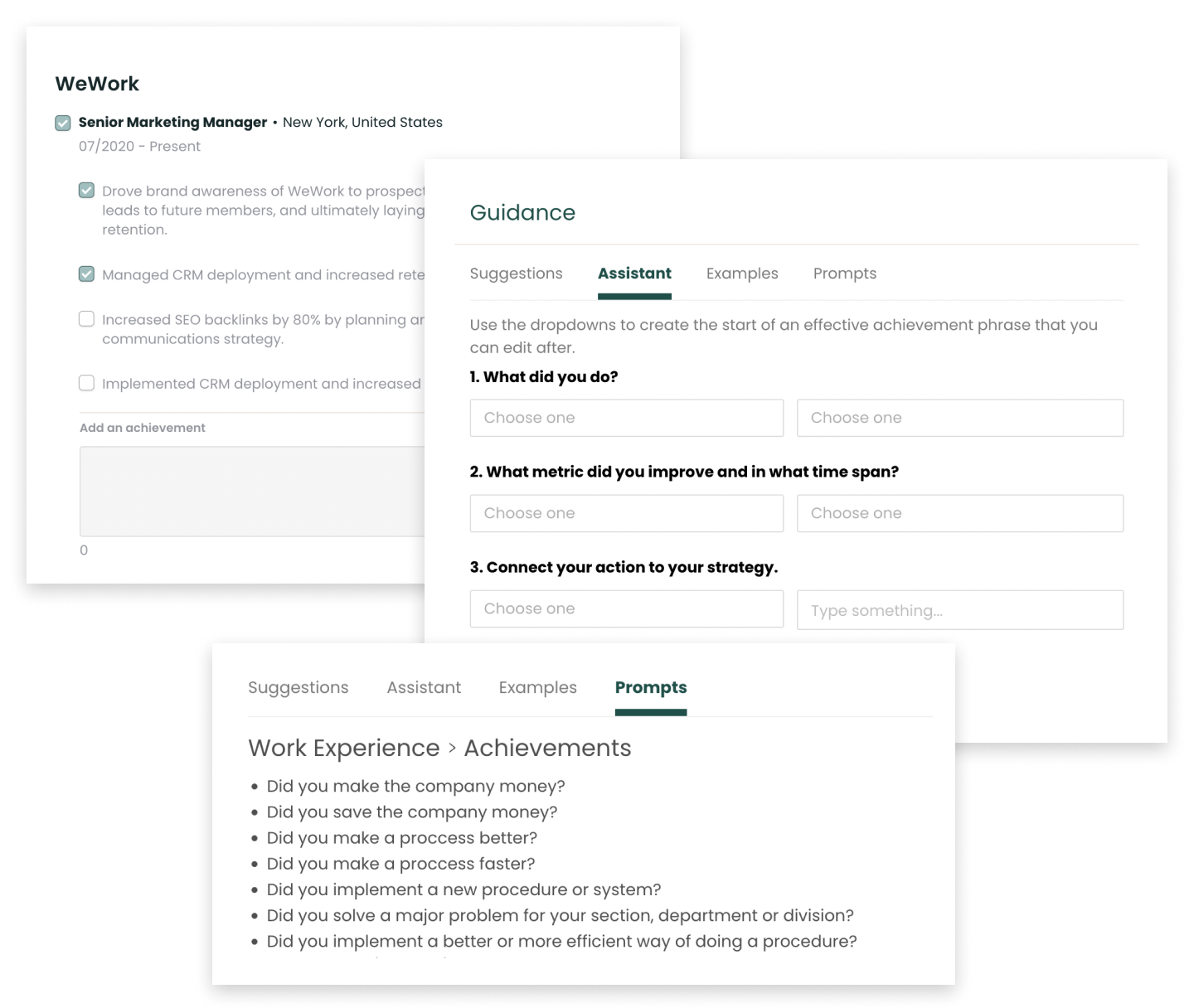
12 Professional Goal Examples for Special Education Teachers
Develop individualized education program (iep) expertise, enhance behavioral management techniques, cultivate inclusive classroom practices, pursue professional development in assistive technology, build collaborative networks with other professionals, advance your understanding of special education law, obtain additional certifications or endorsements, implement data-driven instructional strategies, foster parental involvement and communication, lead professional learning communities, advocate for policy changes and resources, master differentiated instruction techniques, career goals for special education teachers at difference levels, setting career goals as an entry-level special education teacher, setting career goals as a mid-level special education teacher, setting career goals as a senior-level special education teacher, leverage feedback to refine your professional goals, utilizing constructive criticism to enhance educational strategies, incorporating parent and student feedback to drive instructional excellence, leveraging performance reviews to shape professional development, goal faqs for special education teachers, how frequently should special education teachers revisit and adjust their professional goals, can professional goals for special education teachers include soft skill development, how do special education teachers balance long-term career goals with immediate project deadlines, how can special education teachers ensure their goals align with their company's vision and objectives.
What is a Special Education Teacher?

More Professional Goals for Related Roles
Shaping young minds, fostering growth and curiosity in early learning stages
Shaping young minds, fostering creativity and curiosity in the foundation years
Shaping young minds, fostering creativity and curiosity in early education stages
Supporting educational growth, fostering student engagement in a dynamic learning environment
Empowering students' academic growth through personalized learning and mentorship
Shaping young minds, stepping in to ensure seamless learning during teacher absences
What Is the Goal of a Special Education Teacher?
Educators who work with special needs students play a crucial role in our society. They put in countless hours to ensure that students with special needs have the help they need to excel in the classroom. But what, exactly, does a teacher of special education hope to accomplish? In this article, we’ll discuss what it means to be a special education teacher , what obstacles they confront, and the success they hope their pupils will attain. So, keep reading this post about “What Is the Goal of a Special Education Teacher?”
The role of a special education teacher is complex, from facilitating the growth of students’ talents and confidence to fostering an accepting and welcoming classroom climate. If you have a child with special needs, are enrolled in a special education program, or are simply interested in learning more about the topic, this post is for you!
Let’s look at the special education field and discover the fantastic contributions special education teachers make to their pupils and the educational system.
What Is a Special Education Teacher?
A qualified educator with additional training to work with pupils with unique requirements is referred to as a special education teacher. These educators work in various settings, including hospitals, rehabilitation centers, and public and private educational institutions . They are accountable for developing individualized education programs , often known as IEPs, for their pupils, which are intended to assist those children in realizing their full potential and achieving that potential.
Teachers of students in special education work with a diverse group of pupils , including those who have cognitive and physical disabilities, as well as learning difficulties, behavioral and emotional issues, and so on. They tutor students in all academic areas, and in some cases, they also teach life skills and how to care for oneself. They may also work with other experts in the field of education, such as occupational therapists, speech therapists, and social workers, to deliver a complete and consistent educational strategy.
The work of a teacher of students with special needs might be difficult at times, but it can also be highly gratifying. Teachers who specialize in special education have the unique potential to significantly impact their pupils’ lives by assisting them in overcoming challenges and accomplishing their objectives. They have a genuine passion for teaching and are fully committed to giving their students the best education and support they can offer. Indeed, the demand for SPED teachers continues to grow due to their invaluable contributions.

- 『Quantity』: The pack includes 10 reward charts and 216 round stickers.
- 『Dimension』: Each kids chore chart measures 8 x 10 inches(W x L). The circles are large enough for placing stickers inside of them.
- 『Materials』: The reward charts are made of high-quality coated paper, which will allow you

How To Become a Special Education Teacher
To become a special education teacher, one must have education, certification, and experience .
- Education: A bachelor’s degree in special education or a similar discipline is required to become a special education teacher. Typical coursework in these programs includes child development, instructional strategies , and special education law.
- Certification : After earning your degree, you will be required to receive special education certification. Each state has its certification standards, but you must generally pass a certification exam and satisfy specific experience criteria.
- Experience: Some states may also require prospective special education teachers to complete a specified number of student teaching or practicum hours before licensure.
- Ongoing Professional Development: Special education teachers must be familiar with the most current rules and regulations to provide their kids with the finest education possible, as well as current innovative teaching tactics and learning methodologies.
As you gain experience as a special education teacher, you may have the opportunity to move into more specialized roles, such as department head, instructional coach, or administrator. If you’re interested in expanding your knowledge and experience, obtaining a master’s degree in special education could be an excellent next step.
It is also important to realize that certification and licensing requirements may differ based on your country or location. Check the relevant state or country’s standards and the local education board or government agency for further information.
What Does a Special Education Teacher Do on a Daily Basis?
Depending on the school or program, the age of the children, and the student’s individual needs, a special education teacher’s daily responsibilities might range widely. However, there are some recurring tasks, such as:
- Developing and implementing individualized education plans (IEPs): Special education instructors develop and implement individualized education programs (IEPs) in collaboration with other experts. These plans describe the student’s abilities and challenges, identify goals for improvement, and specify the adjustments that will be made to the curriculum.
- Delivering instruction: Special education teachers try to modify lessons for their students in the classroom. Teachers may use alternative materials, tools, and methods to engage further and assist these children.
- Assessing student progress: The law requires educators in special needs classrooms to conduct regular, formal, and informal assessments of their student’s progress toward the goals set in their Individualized Education Programs (IEPs). Data guides instruction and determines the best ways to help students.
- Collaborating with other professionals: Teachers of students with special needs frequently collaborate with other specialists in the field, including speech therapists, occupational therapists, and social workers. Working together can provide students with a consistent and thorough set of services.
- Supporting families: Special education teachers are also crucial in assisting families. They keep parents and guardians in the loop about their kid’s progress and help them locate community-based programs and resources that can supplement what their child is learning in the classroom.
- Maintaining records and documents: Educators in special education have the added responsibility of keeping track of student paperwork, such as individual education plans (IEPs), test scores, and report cards.
- Professional development and staying informed: Teachers in special education have several responsibilities, including continuing their professional development and keeping up with developments in the field’s legislation, regulations, and pedagogical approaches. To hone their craft, they participate in regular training and study.
Teachers in special education have an important role as guides and champions for their students, going above and beyond the call of duty to ensure their students’ health, success in school, and personal growth.
Examples of SMART Goals for Special Education Teachers
Special education teachers establish goals for their pupils to assist them in making development and achieving academic achievement. These objectives are often SMART, specific, measurable, attainable, relevant, and time-bound.
Here are some examples of SMART objectives for instructors of special education:
- Increase the reading fluency of a student with dyslexia by 20 percent over the next six months using a multimodal instructional method and additional help during reading instruction.
- Help a student with autism enhance social interactions by 25% at the end of the school year by giving training, practice, and positive reinforcement in social skills .
- Improve a student’s fine motor abilities by offering additional occupational therapy and adaptive equipment, such as a pencil grip, and ensuring that the student has access to play-based activities that improve fine motor skills regularly.
- Reduce by 50% over the following three months the number of outbursts a student with an emotional problem experiences per week by offering lessons in emotional regulation and using a token economy system to promote positive conduct.
- Over the next nine months, boost a student’s arithmetic results by 30 percent by offering extra assistance during math instruction, employing manipulatives, and providing one-on-one coaching.
- Assist a student with limited mobility to move independently inside the classroom through adaptive equipment and physical therapy. Set a daily objective to increase the number of times the student carries independently by fifty percent.
- Over the next semester, increase a student’s participation in class discussions by 30% by giving opportunities for the student to voice their opinions, responding positively to the student’s contributions, and providing accommodations to aid the student in communicating.
- Help a kid with speech difficulties improve their speech intelligibility by 50 percent over the next six months through speech therapy and visual aids such as graphics.
These are a few examples, but special education teachers should work closely with their students, families, and other professionals to establish goals suited to each student’s unique requirements. Remember that SMART goals should be Specific, Measurable, Attainable, Relevant, and Time-Bound and that they should be routinely evaluated and modified following the student’s progress. So, those are some of the goals of special education teachers.
T-Tess Goals for Special Education Teachers Examples
A teacher assessment system in Texas is known as T-TESS, which stands for the Texas Teacher Evaluation and Support System. Teachers in Texas, including those specializing in special education, are assessed using the T-TESS, which requires them to create learning objectives for themselves and their students. T-TESS objectives are a common name for these targets.
Goals that teachers of students with exceptional needs could set using T-TESS include the following:
- By the school year’s conclusion, you should have created and implemented at least two instructional techniques based on evidence to help children with learning disabilities improve their reading fluency and comprehension.
- By the end of the next nine months, we will have doubled the percentage of students with behavioral issues behaving appropriately in the classroom through a positive behavior support system.
- Involve parents in creating their child’s Individualized Education Program (IEP) and increase collaboration through regular contact and parent-teacher conferences.
- By making adjustments and modifying activities and equipment, we can encourage more physically-impaired students to participate in physical education classes.
- Educate your peers continuously about how they can use technology better to serve their children with special needs in the classroom, and at least two of them will eventually adopt such a practice.
- Creating and implementing a system for collecting and analyzing student development, and using the data to inform instruction and amend IEPs, will improve data-driven education and assessment.
- Set up a method to check in on the progress of children with special needs frequently, ensure everyone is making headway toward their IEP goals, and aid kids suffering when needed.
- Involving parents in their child’s education in meaningful ways, such as by providing regular updates on their child’s development, including them in goal-setting, and actively soliciting their advice on their child’s education, has been shown to increase parent satisfaction.
Remember that the examples mentioned above of T-Tess goals for Special Education Teachers only apply in Texas. Other states and countries may have different systems for defining goals and evaluating teachers. So, those are some of the teacher’s professional goals examples.

Professional Goals for Special Education Teachers
In addition to the T-TESS goals, special education instructors are encouraged to develop their professional goals to enhance their teaching abilities, move forward in their careers, and provide enhanced student support.
The following is a list of some examples of professional goals for teachers of special education:
- Read professional journals regularly, attend conferences and workshops, and take part in other opportunities for ongoing professional development to ensure that you are up to date on the most recent findings from research and the rules and regulations about special education.
- Develop your knowledge in a particular field of special education, such as autism, by attending classes, reading relevant material, and taking part in specialized training; as a result, you will be able to offer pupils help that is more targeted and effective.
- Implementing effective behavior management strategies, promoting positive student-teacher interactions, and cultivating a sense of community among students are great ways to improve classroom management skills and create a more positive and welcoming environment for all students.
- Increase the use of technology in the classroom by investigating and experimenting with various tools and resources to enhance the education of children with special needs. Some examples of these tools and resources are online learning platforms and assistive technology.
- Create a method for routinely tracking the development of kids with unique requirements, conducting data analysis, and using this information to guide classroom instruction and modify individualized education programs (IEPs).
- Enhance your ability to collaborate with other professionals by attending meetings, participating in case conferences, and actively seeking opportunities to work together on behalf of students with special needs.
- Reading different types of literature, attending additional training, and participating in various cultural exchange events are great ways to expand on cultural competency and deliver culturally responsive instruction to students from multiple backgrounds.
- You can advance your professional standing by earning additional certificates and degrees, such as a master’s degree in special education, to work up to the position of department head, instructional coach, or administrator.
It is essential to remember that those above are merely examples and that every special education instructor will have their own one-of-a-kind goals depending on the skills they possess, the areas in which they may improve, and the requirements of their pupils. Establishing and accomplishing professional goals can be difficult; however, it is imperative to remember that the pursuit of progress, and not perfection, is most important.
Is an Individualized Education for All Students?
When students receive an individualized education, they receive lessons specifically designed for them based on their strengths and weaknesses. This is a cornerstone of special education theory and practice, and it is crucial to ensure that all students are given the tools they need to succeed in the classroom.
An IEP is a document that details the exact goals, adjustments, and modifications to the curriculum that will be made to help a student with special needs succeed in school. The student’s special education teacher works with the student, parents/guardians, and other appropriate experts to create an Individualized Education Program (IEP). As a group, the individualized education program (IEP) members discuss the student’s progress and collaborate to determine their areas of strength and growth.
As every student has their own set of skills, interests, and requirements, the individualized education approach can be used with any group of kids, not just those with special needs. Individualizing learning allows students to progress at their own pace, grasp concepts in ways that resonate with them, and stay interested and motivated throughout the learning process.
Teachers should also use assessment results to determine their students’ strengths and weaknesses, offer pupils a range of options for how and what to study, and tailor their level of assistance to each student. They need to be willing to attempt new things to provide their pupils with the best possible individualized education experience.
In addition to being ready to work with other professionals, families, and students to create a student-centered approach, flexibility in modifying curriculum and techniques is essential when they aren’t working.
Overall, customized education is a method that gives every student a chance to thrive and develop to their fullest potential by catering to their specific needs and strengths.

What Is the Goal of a Special Education Teacher? How To Be Successful
Special education teachers play a crucial role in their student’s lives and are essential to the functioning of the unique education system. But what makes a teacher of special education genuinely successful?
Here are a few attributes that can help the success of a special education teacher:
- Patience and understanding: Special education kids often confront unique obstacles and require extra time, assistance, and patience. Successful special education teachers have a firm grasp of their student’s needs and are patient and empathetic in their interactions.
- Creativity and flexibility: Special education teachers must be creative and adaptable in their teaching approach to fulfill each student’s needs. They must be open to new techniques and ideas and willing to modify their lesson when impractical.
- Strong communication skills: Special education teachers must communicate effectively with various stakeholders, including children, families, and other professionals. They must convey complex concepts and procedures in a simple and intelligible manner.
- Strong organizational skills: Special education teachers generally have many paperwork, records, and assessments to keep track of. To monitor student progress and make informed judgments, they must be highly organized and able to maintain precise records and data.
- Strong assessment skills: Special education instructors must use various assessment tools and procedures to establish student strengths, weaknesses, and growth opportunities and use the findings to inform instruction and modify IEPs.
- Empathy and understanding: Teachers in special education must be sensitive and understand their student’s circumstances to provide advice and assistance in the academic, social, and emotional domains.
- Strong teamwork: Special education instructors typically work in partnership with other professions and must work well as a team. They should be able to communicate well and appreciate different opinions while also being strong advocates for their kids.
- Continuous improvement mindset: Competent special education teachers are dedicated to their professional development and stay abreast of the most recent research, policies, and best practices in the field. They are receptive to feedback, willing to grow from their mistakes, and continually seek to enhance their profession.
These are some of the attributes that can contribute to a special education teacher’s success. These attributes are a helpful beginning point for teachers and administrators to evaluate and support the performance of special education teachers.
Jennifer Hanson is a dedicated and seasoned writer specializing in the field of special education. With a passion for advocating for the rights and needs of children with diverse learning abilities, Jennifer uses her pen to educate, inspire, and empower both educators and parents alike.
Related Posts
The role of the special education teacher, special education certification texas.
- Grades 6-12
- School Leaders
NEW: Classroom Clean-Up/Set-Up Email Course! 🧽
What Is Special Education? A Guide for Educators and Families
It’s a service, not a place.
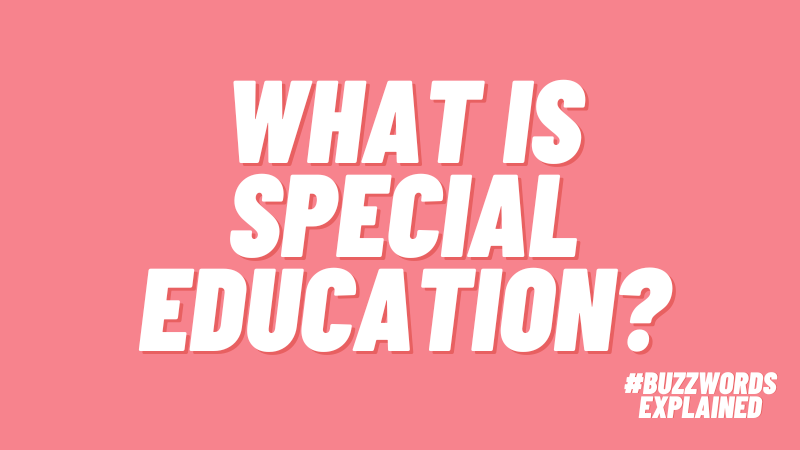
Students who are blind are provided with braille books. An autistic student uses a visual schedule. A student with a learning disability receives additional reading instruction. These students all receive special education services.
Special education provides services that meet the unique needs of each student. This means that special education can include:
- An individualized curriculum that is different than general education peers’
- A curriculum that is modified for a student
- A combination of both
Here’s a roundup of everything you need to know about special education, plus our best special education articles.
What laws are involved in special education?
The Individuals With Disabilities Education Act (IDEA) is the federal law that explains how states must address special education. The IDEA definition of special education is: specially designed instruction, at no cost to parents, to meet the unique needs of a child with a disability. It includes physical education, related services (e.g., speech therapy, occupational therapy), vocational education, and travel training. Essentially, special education is how students with disabilities have their needs met in the public education system.
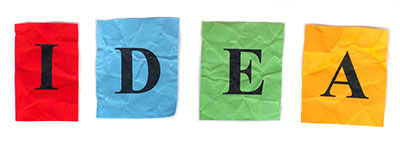
Read more: What Is IDEA?
What about state laws?
IDEA sets the standard at the federal level, but the process and system are set up at the state level. So what special education looks like varies from state to state.
Visit your state’s Department of Special Education website or check out the parent resource center (every state has one) for information related to special education aimed at parents.
Find your state’s parent resource center in this list from Center for Parent Information & Resources .
How is special education not a “place”?
Special education can occur in many different settings, from the general education classroom to a hospital or separate school. Where a child receives services depends on their needs as determined by the IEP team, which includes the parents.
What are the main components of special education? (What do the acronyms stand for?)
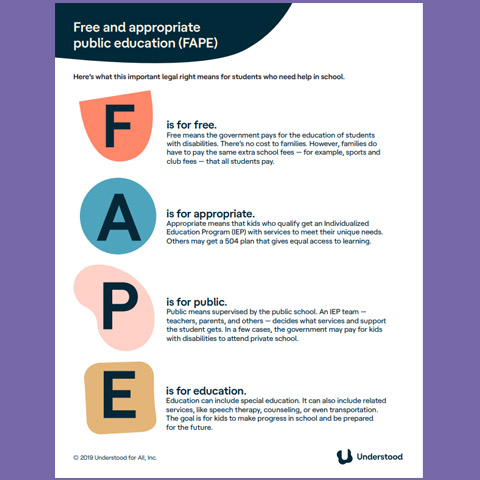
Image: Pathfinder Services of ND
FAPE is Free Appropriate Public Education. This essentially means that students with disabilities must be provided with their education at no cost to the parents, just like any other student.
Read more: What Is FAPE?

Image: Arizona Department of Education
LRE is Least Restrictive Environment. LRE is the setting where the child receives services and can vary from general education to a separate school or even the child’s home. The LRE is decided by the IEP team. According to IDEA, special education must be provided in the least restrictive environment, or the same environment as their nondisabled peers, “to the greatest extent possible.” This means that children should only be removed from general education when their disability is such that that they cannot make progress. So, all consideration of where a child will learn starts in general education and works back from there.
Read more: What Is Least Restrictive Environment?
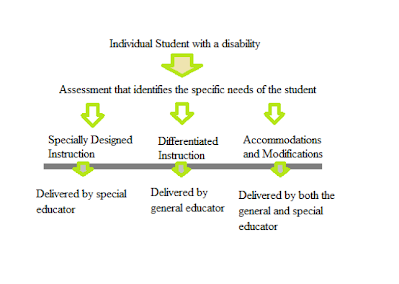
Image: Coastal Carolina University
SDI is specially designed instruction. This is the foundation of what special education is based on—that every child receives the instruction that they need to make progress and advance toward goals. SDI means adapting the content, delivery, or methodology of instruction to address the child’s needs, as determined by the needs related to their disability. The focus is on helping the child meet educational standards and ensuring access to the general curriculum. To help children access general education curriculum, SDI provides adaptations, accommodations, and modifications.
Read more: What Is Specially Designed Instruction?
IEP is the Individual Education Program. The IEP is the document that outlines everything that a child requires to receive FAPE and SDI.
Read more: What Is an IEP?
Accommodations and Modifications
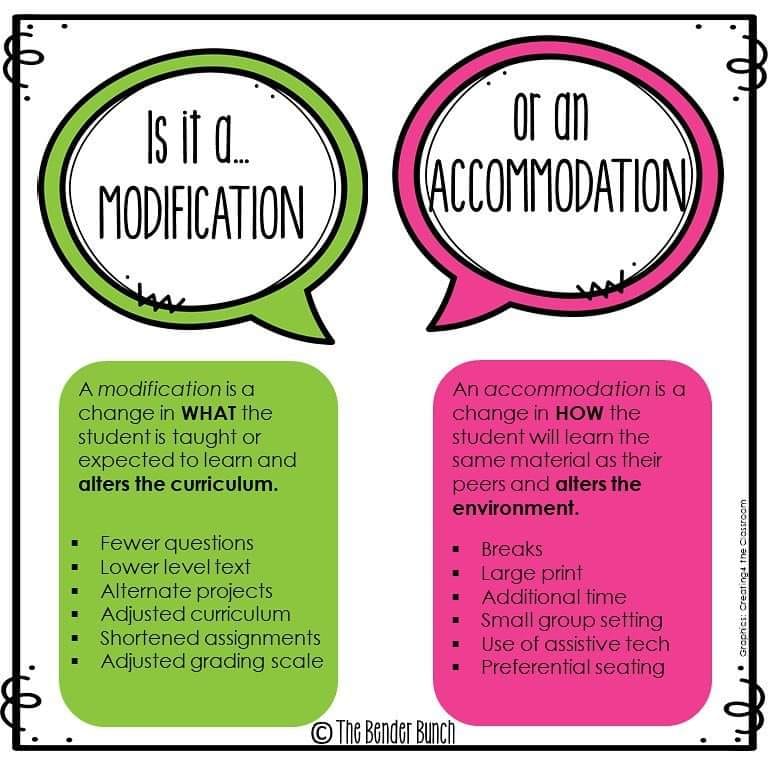
Image: The Bender Bunch
Accommodations and modifications are ways that SDI is delivered and how the curriculum is individualized for a child; ways that the child receives access to the general education curriculum. In short, accommodations change how the material is being presented in a way that helps the child overcome or access through the disability. Modifications change what a child is taught or how the child works at school. So, an accommodation would be: allowing a child to record rather than write their answers, or reading aloud a question rather than having them read it. A modification would be providing a child a text with visuals instead of the general education text, or providing a test with two answer choices instead of four.
Read more: Accommodations vs. Modifications: What’s the difference?
Bookmark: 80+ Accommodations Every Special Ed Teacher Should Bookmark
More IDEA terms are defined at Parent Center Hub .
Which students can receive special education and who decides?
Special education is provided to students who fall under one of 13 disability categories:
- Developmental delay
- Specific learning disability
- Speech impairment
- Other health impairment
- Traumatic brain injury
- Autism spectrum disorder
- Vision impairment
- Hearing impairment
- Deaf-blindness
- Emotional disability
- Orthopedic impairment
- Intellectual disability
- Multiple disabilities
In order to receive special education services, a student must be found eligible. This means that they have one of the 13 disabilities and that it impacts them in the school setting. If the child cannot make progress in the general curriculum without SDI, they are eligible for special education services. (If they can make progress but still have an outside diagnosis, they may have a 504 plan in place instead.)
Read more: What Is a 504 plan?
An evaluation is different for each disability category (for example, an evaluation for traumatic brain injury will include a medical evaluation, while an evaluation for speech impairment will not). These regulations vary from state to state so it’s important to know your state’s requirements and timeline.
What is in an IEP?
The IEP includes all the information that the team needs to educate a child with a disability. It only addresses the aspects of a child’s disability that impact them throughout the school day. The sections of an IEP are:
- Present levels: How the child is currently doing in school and how the disability impacts them in class.
- Annual goals: Goals that the child will work on through SDI.
- Objectives: Students who take alternate assessments will also have objectives towards their goals.
- Measuring and reporting progress: Ways that the child’s progress is going to be measured and how it will be reported to parents.
- Specially designed instruction: A statement about how special education and related services will be provided.
- Related services include any therapies (speech therapy, physical therapy, occupational therapy).
- Supplementary aids and services provide access to participation across academic, extracurricular, and nonacademic settings.
- Program modifications for school personnel, which include things that school personnel need to know in order to work with this student (for example, how to use an assisted communication device).
- Extent of nonparticipation is the explanation of how much, if any, the child will be outside of general education, and why the team made that decision.
- Accommodations that the student will be provided during classroom instruction.
- Accommodations that a student will receive during district and state testing.
- Service delivery includes when, where, and how long a child will receive SDI (for example, 30 minutes 1x/week in special education).
- Transition planning for life after secondary school starts no later than a child’s 16th birthday (and can start earlier).
- Age of majority: An IEP must include a statement about how the student understands their rights as they graduate from the IEP.
What happens in an IEP meeting?
There are many different reasons to come together around an IEP, but every year, each student who has an IEP will have an annual review. During an annual review meeting, the team (parent, teachers, a district representative, therapists) discuss the child, their progress, and next steps. Everything in the IEP should be based on data, so it’s important to bring information (e.g., work samples, test data) to review.
Any decision regarding an IEP is a team decision, and team members don’t always agree. If the meeting cannot resolve a concern, schools or parents can follow procedures to reach an agreement.
Read more: What Is an IEP meeting?
Read more: What Is a Manifestation Determination Meeting?
When does special education start and end?
A child can receive early intervention or special education services if they have a disability diagnosed before age 3 (such as Down syndrome) or if they are at risk of a delay.
Read more: What Is Early Intervention?
The end-date for a student who has an IEP depends on a few things. They may be reevaluated and found no longer eligible, in which case special education services would end at that point. Otherwise they are no long eligible when they graduate from high school or turn 22.
What is NOT special education?
There are misconceptions about special education. Some things that special education is not:
- A specific program, like Orton-Gillingham
- Differentiated instruction
- An inclusive classroom
What else should I know?
Here are more of our favorite special education resources:
What Is Inclusion in Education?
27+ Best Autism Resources for Educators
If you’re still using these five words for students with disabilities, it’s time to stop.
New Ways To Empower Students Who Have Learning Differences or Dyslexia
How Teachers Can Support Twice-Exceptional Students
The IEP From A to Z: How To Create Meaningful and Measurable Goals and Objectives by Diane Twachtman-Cullen and Jennifer Twachtman-Bassett
10 Critical Components for Success in the Special Education Classroom by Marcia Rohrer and Nannette Samson
Wrightslaw: All About IEPs by Peter Wright, Pamela Wright, and Sandra Webb O’Connor
Do you teach special education? Connect with other teachers on the WeAreTeachers HELPLINE group on Facebook .
For more articles like this one, subscribe to our newsletters..
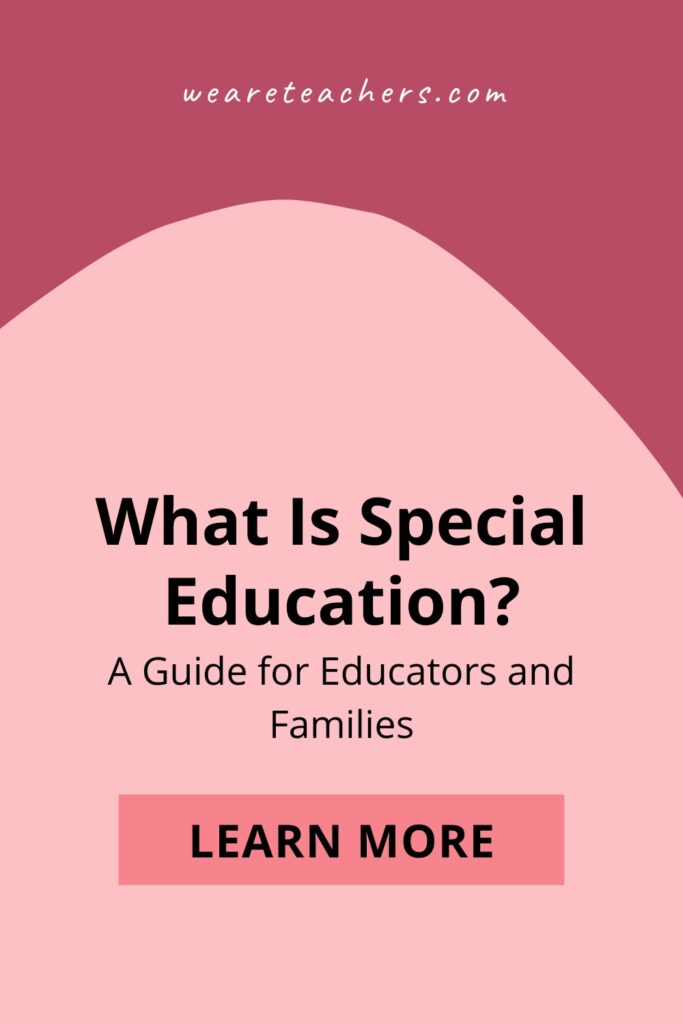
You Might Also Like
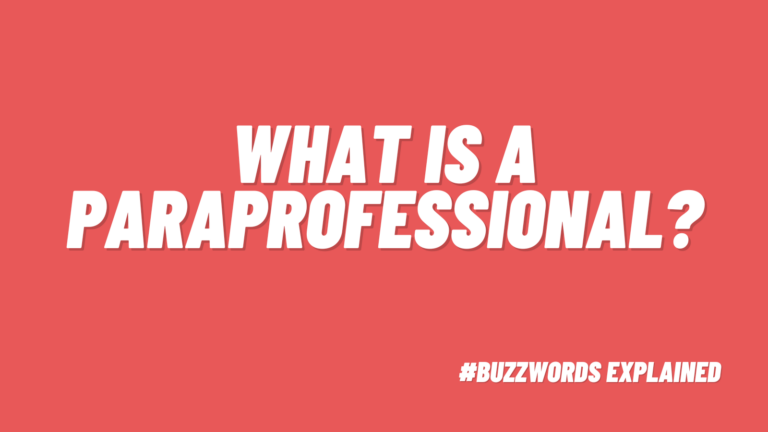
What Is a Paraprofessional?
They're often called the "backbone of the classroom." Continue Reading
Copyright © 2024. All rights reserved. 5335 Gate Parkway, Jacksonville, FL 32256
How One School Fosters Belonging for Students With Disabilities

- Share article
Fostering a sense of belonging in school takes a lot of intentional effort, especially when it comes to students with disabilities, who have traditionally been excluded from many mainstream classes and activities.
That’s according to a principal who has dedicated her career to that cause.
Cathi Davis, principal of Ruby Bridges Elementary School in Woodinville, Wash. , near Seattle which opened in 2020, runs a school that is designed so students with disabilities spend nearly all of their time in general education classes learning alongside their peers, rather than being pulled out for specialized instruction.

It’s one of 16 schools in Washington state that partner with the Haring Center for Inclusive Education at the University of Washington with the goal of demonstrating that all students benefit when schools are intentionally designed with the needs of students with disabilities at the forefront.
“We did a lot of planning to think about how we could really facilitate an opportunity for students to see themselves throughout the school, and to know that we thought of them in the design of the school,” Davis said during a webinar hosted by Education Week on May 23. “Really, that was less about architecture—that wasn’t about paint, that wasn’t about the parking lot. It was about our mindsets and our heart work that we were doing as a staff to think about how belonging could come off the page for each and every student.”
The approach diverges from the traditional K-12 education model through which students with Individualized Education Programs, or IEPs, are pulled out of classes with their peers into separate settings where they receive individualized or small-group instruction.
Ruby Bridges’ approach helps students with disabilities form relationships with their classmates and others in their school, and helps general education students build empathy and compassion. Several studies over the years examining these more inclusive practices have found either neutral or positive effects on all students’ performance in core subjects like math and reading.
“We know that all students benefit from that general education access,” Davis said. “We know learning’s not linear, and I think more and more we understand that our students are more engaged when learning is tailored to fit their needs and their strengths.”

In Ruby Bridges classrooms, all students have access to supports traditionally outlined in students’ IEPs or 504 plans, like the ability to take breaks when feeling overwhelmed, or the opportunity to learn in a small group with the teacher, while others might work independently on a tablet with headphones on.
During one recent phonics lesson she was observing, Davis recalled one student who was participating in a group lesson, but was bouncing on a trampoline at the same time to help regulate their senses.
“It’s that sense of truly being welcomed into a community, not like, ‘You get to be here, too, but over there,’” Davis said. "…But rather, we are all being together and kind of framing our identity around what that means for us.”
One of the keys to how Ruby Bridges works is its staffing model, which emphasizes collaboration.
For example, rather than having a designated paraprofessional assigned to each student who needs extra support, paraprofessionals work with different students all the time, meaning they could be providing math support in the morning and teaching phonics lessons to English learners in the afternoon.
In practice, the adults in the school are encouraged and required to work together to support students’ learning. “No one person is independently trying to support all of the learning of any one student,” Davis said.

“We’re looking at, what do kids need in this moment to be successful in their learning, and how do we support that best with the right person at this time?” Davis said. “How can we collectively share the load?”
For more on the discussion of creating communities of belonging for all students—including those with disabilities—and its academic and social benefits, check out the video above and Education Week’s recent special report about building strong student-school connections.
Sign Up for EdWeek Update
Edweek top school jobs.

Sign Up & Sign In


Virtual Tour
Experience University of Idaho with a virtual tour. Explore now
- Discover a Career
- Find a Major
- Experience U of I Life
More Resources
- Admitted Students
- International Students
Take Action
- Find Financial Aid
- View Deadlines
- Find Your Rep

Helping to ensure U of I is a safe and engaging place for students to learn and be successful. Read about Title IX.
Get Involved
- Clubs & Volunteer Opportunities
- Recreation and Wellbeing
- Student Government
- Student Sustainability Cooperative
- Academic Assistance
- Safety & Security
- Career Services
- Health & Wellness Services
- Register for Classes
- Dates & Deadlines
- Financial Aid
- Sustainable Solutions
- U of I Library

- Upcoming Events
Review the events calendar.
Stay Connected
- Vandal Family Newsletter
- Here We Have Idaho Magazine
- Living on Campus
- Campus Safety
- About Moscow

The largest Vandal Family reunion of the year. Check dates.
Benefits and Services
- Vandal Voyagers Program
- Vandal License Plate
- Submit Class Notes
- Make a Gift
- View Events
- Alumni Chapters
- University Magazine
- Alumni Newsletter

U of I's web-based retention and advising tool provides an efficient way to guide and support students on their road to graduation. Login to VandalStar.
Common Tools
- Administrative Procedures Manual (APM)
- Class Schedule
- OIT Tech Support
- Academic Dates & Deadlines
- U of I Retirees Association
- Faculty Senate
- Staff Council
Department of Curriculum and Instruction
Mailing Address: College of Education, Health and Human Sciences University of Idaho 875 Perimeter Drive Moscow, Idaho 83844-3082
Phone: 208-885-6587
Fax: 208-885-1071
Email: [email protected]
Special Education
The Special Education Master’s Degree and Certification-Only Program at the University of Idaho is designed to offer certified teachers a convenient pathway to obtain a master’s degree in special education, coupled with the option of special education certification. Our program stands out as a top choice for students seeking distance learning opportunities, allowing them to complete their degree and certification remotely. All courses are delivered through distance technologies, eliminating the need for on-campus attendance. The University of Idaho's Special Education Program holds national accreditation from the Council for the Accreditation of Educator Preparation (formerly known as the National Council for Accreditation of Teacher Education) and is a state-approved program in special education. To qualify for entry into the program, candidates should possess an undergraduate degree in education or a related field and meet the university's enrollment criteria for the College of Graduate Studies. For those pursuing certification options, a valid teaching certificate is a prerequisite. Join our program to advance your career and expertise in special education from the comfort of your own location.
- Special Education Program Handbook pdf
The coursework and practicum in the program will help prepare or further your knowledge of working with students with special needs.
Special education teachers design and teach appropriate curricula and assign work geared toward each student’s needs and abilities. This includes behavioral, social, and academic development as well as preparing special education students for daily life beyond school also is an important aspect of the job.
A degree in special education prepares you for a rewarding career providing services to those with special needs or training others to work with students with special needs.
Addressing the Special Education Teacher Shortage by Certifying Paraeducators
Paraeducators provide essential support to students with disabilities in special education settings and inclusive classrooms across the United States. The most recent data from the National Center for Education Statistics (NCES) indicate there were 883,071 instructional aids (i.e., paraeducators) in the United States. (NCES, 2021). Compared to teachers, the need for paraeducators is growing at an even faster rate. Since 2000, the annual growth rate for teachers is 0.46% compared to 1.98% for paraeducators (NCES, 2021). Preparing current paraeducators to become special education teachers could help address the special education teacher shortage. Paraeducators may be an especially good fit because:
Strong Community Connections: Many paraeducators have strong connections to the community in which they serve. These connections are especially important for to racially, linguistically, and ethnically diverse communities, as paraeducators across the United States are more racially and ethnically diverse than the teacher workforce (Bisht et al., 2021; Morrison & Lightner 2017)
Knowledge of Special Education: Through their work in schools, paraeducators also have first-hand understanding of school policy and procedures. As limited previous experiences in schools are associated with levels of special education teacher attrition (Billingsley & Bettini, 2019), paraeducators are especially well-suited for the transition to service as the teacher of record.
Career Interests and Job Benefits: Connally et al. (2017) described why paraeducators, especially those from culturally diverse backgrounds, may want to make the transition to become certified special education teachers. Primary reasons include enjoyment of working with children and youth, monetary benefits, and career status. Unfortunately, paraeducators face a variety of barriers in obtaining teacher certification, including a lack of specific academic credentials required to teach, licensure and student teaching rules, difficulty getting reliable information, low pay (students regularly work multiple jobs), and high tuition costs (Connally et al., 2017). The University of Idaho recently received federal funding (OSEP 325k) to develop Idaho’s Model Paraeducators Advancing to Certified Teacher (IMPACT). More information about the program can be found here , or by contacting Andrew Scheef .
Billingsley, B., & Bettini, E. (2019). Special education teacher attrition and retention: A review of the literature. Review of Educational Research, 89 (5), 697-744. Bisht, B., LeClair, Z., Loeb, S., & Sun, M. (2021). Paraeducators: Growth, Diversity and a Dearth of Professional Supports. EdWorkingPaper No. 21-490. Annenberg Institute for School Reform at Brown University. Connally, K., Garcia, A., Cook, S., & Williams, C. P. (2017). Teacher talent untapped: Multilingual paraprofessionals speak about the barriers to entering the profession . New America. https://na-production.s3.amazonaws.com/documents/Teacher-Talent-Untapped.pdf Morrison, J., & Lightner, L. (2017). Putting paraeducators on the path to teacher certification. Phi Delta Kappan , 98 (8), 43-47. National Center for Education Statistics. (2021). Digest of education statistics. https://nces.ed.gov/programs/digest/d21/tables/dt21_213.10.asp
Quality University Experiences to Support Transition for students with IDD
Many high school students with intellectual and developmental disabilities (IDD) learn in inclusive classrooms alongside their peers. However, when high school finishes and many peers transition to college or university, students with IDD may not have opportunities to follow this same path to higher education. Like their peers, students with IDD may need additional schooling to help achieve employment goals.
To address this inequity, many colleges and universities across the United States have developed inclusive postsecondary education programs to serve students with IDD. These are typically not degree-granting offerings, but provide students opportunities to develop employment and community skills while learning alongside their peers in college or university courses. Although the programming may look somewhat different, they are at college to pave a pathway to employment (much like their peers).
Those interested in learning more about inclusive post-secondary education should explore resources at Think College . They serve as the national coordinating center for inclusive postsecondary education programs and have resources for students, families, teachers, and those interested in promoting the idea that students with IDD can attend college.
Vandal QUEST (Quality University Experiences to Support Transition) is an inclusive postsecondary program at the University of Idaho. Students in QUEST enroll in university courses, participate in campus activities, develop individualized skills, and engage in a variety of work experiences. Another key component involves our partnership with Peer Mentors, who are traditionally-enrolled students at the University of Idaho. Our teacher education students have opportunities to engage with our Vandal QUEST students; it is an experience that benefits everyone.
To learn more about inclusive postsecondary education, watch these videos:
Think College: https://youtu.be/SV84JbNTKyI?si=2a2qooKNa7vR0aCd
Vandal QUEST : https://www.youtube.com/watch?v=oPE5CoTFeS0
- Atlas Elementary
- Borah Elementary
- Bryan Elementary
- Canfield Middle School
- CDA Early Learning Center
- Coeur d’Alene High School
- Dalton Elementary
- Fernan STEM Academy
- Hayden Meadows Elementary
- Lake City High School
- Lakes Middle School
- Northwest Expedition Academy
- Ramsey Magnet School of Science
- Skyway Elementary
- Sorensen Magnet School of the Arts and Humanities
- Venture Academy
- Winton Elementary
- Woodland Middle School

COEUR d’ALENE PUBLIC SCHOOLS
Special education, page navigation.
- I'm a Person First
- School-Based Medicaid
- Web Accessibility
- CDA Early Learning Center - Developmental Preschool
- 18-21 Programs
- Students Who Are Deaf and Hard of Hearing
- Visually Impaired Students
- Upcoming Events
- Parent Resources
- Surrogate Parents
- Restraint and Seclusion Form
- Coeur d‘Alene Public Schools
Welcome to the Special Education Department

Coeur d'Alene Public Schools commissioned a review of its support services for struggling learners. This educational services analysis was conducted in 2018 by Futures Education and presented to the district in November 2018. The full report is available here .
Welcome to the Coeur d'Alene Public Schools Special Education Department where all children are special and where we believe in the value and potential of every student. The Special Education Department seeks to improve the performance of students with disabilities by ensuring equal access to the general education curriculum and differentiated instruction within their Least Restrictive Environment (LRE). We provide and monitor the delivery of a comprehensive and seamless continuum of services for students with disabilities. We strive to provide an education where every student, regardless of disability, has the opportunity to grow and learn in a safe and secure environment in which individual needs are assessed and nurtured.
Children develop and learn at different rates. Some children have disabilities that interfere with their ability to make progress in their educational programs. Others learn more easily and require program enhancements or a more challenging curriculum. Coeur d'Alene Public Schools offers a wide variety of specially designed services to meet the unique needs of children determined to be eligible for special education services by meeting the eligibility criteria outlined in the Idaho Special Education Manual. There is not a "one size fits all" approach when it comes to special education services. Once a child has qualified for services, an Individualized Education Program (IEP) team determines appropriate goals, accommodations/modifications and LRE based on each student's individual needs.
All District schools are served by special education professionals and related service providers. Services will be provided at a student's home school to the extent that the student is progressing towards their goals. We are dedicated to providing the supplementary aids and services to support children to be educated alongside their neighborhood peers.
Contact Us:

Frank Maier
Director of Special Education
208-664-8241
Email: [email protected]

Administrative Assistant for Special Education
208-664-8241
Email: [email protected]

Jenny Jensen
Assistant Director of Special Education (Elementary)
Email: [email protected]

Samantha Minert
Coordinator of Special Education (Secondary)
Email: [email protected]
Special Education Consulting Teachers

Jonathan Beecher
Email: [email protected]

Email: [email protected]
- Questions or Feedback? |
- Web Community Manager Privacy Policy (Updated) |
Doctor of Education Leadership
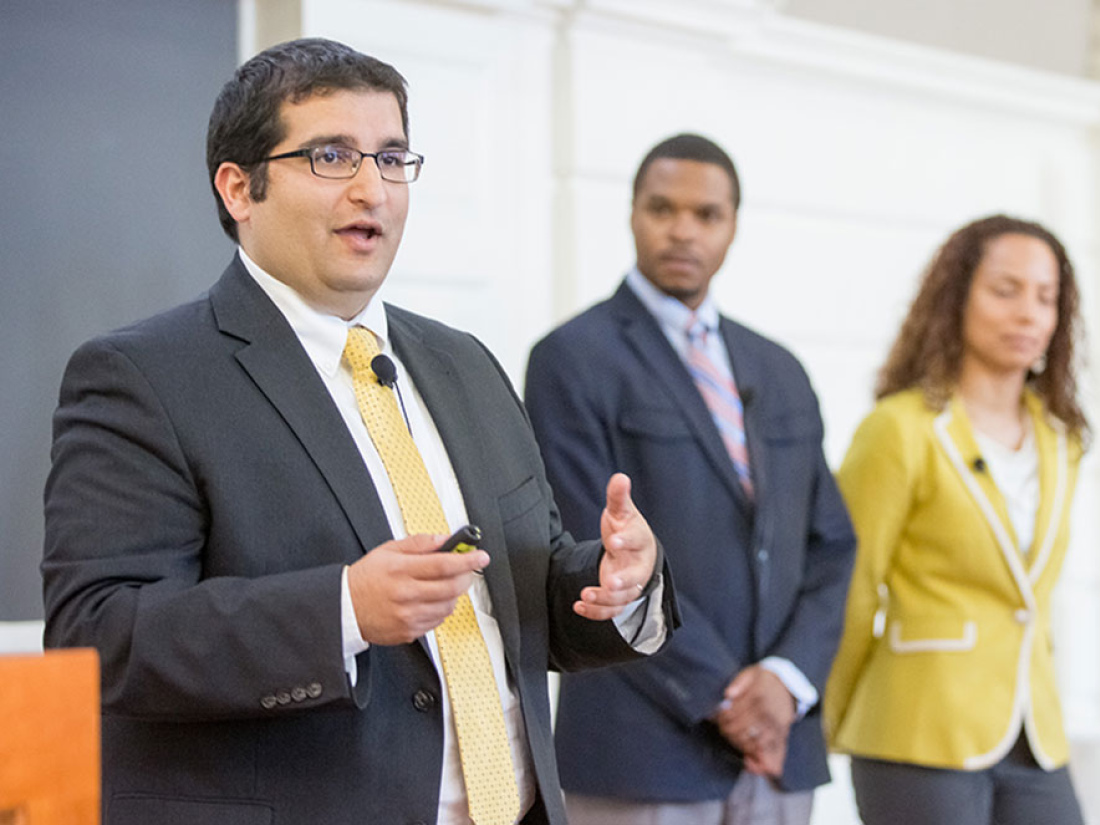
Additional Information
- Download the Doctoral Viewbook
- Admissions & Aid
America needs transformative leaders in preK–12 education whose passion for education quality and equity is matched by a knowledge of learning and development, the organizational management skills to translate visionary ideas into practical success, and a firm grasp of the role of context and politics in shaping leadership. Graduates of the three-year, multidisciplinary Doctor of Education Leadership (Ed.L.D.) Program at the Harvard Graduate School of Education will be prepared to become those leaders.
The Ed.L.D Program — taught by faculty from the Harvard Graduate School of Education, the Harvard Business School, and the Harvard Kennedy School — will train you for system-level leadership positions in school systems, state and federal departments of education, and national nonprofit organizations. Ed.L.D. is a full-time, three-year program built on a cohort learning model. Cohorts consist of up to 25 students from diverse professional backgrounds (including district/charter management leaders, nonprofit directors, principals, teachers, and policy researchers) who progress through the program together.
All Ed.L.D. students receive a full tuition funding package plus stipends, work opportunities, and a paid third-year residency at a partner organization.
The Ed.L.D. Program prepares graduates to do work for the public good in the American public education sector, whether that be at the system or state level. Specifically, the program is designed to accelerate the progress graduates make toward achieving meaningful impact in influential roles and/or crossing boundaries in the following spaces in the public education sector:
- PreK–12 district or CMO leadership roles : superintendent of schools, chief academic officer, and/or deputy superintendent
- Foundation/philanthropy roles: director, president and CEO, senior fellow
- Education nonprofit roles : president or executive director of backbone or collective impact organizations which support preK–12 schools. Ed.L.D. graduates will lead education nonprofits that explicitly focus on improving outcomes and opportunities for children, families, and communities.
- State or federal education leadership roles : commissioner or deputy commissioner roles. Could also include public education advocacy or education policy advisers to senior government officials.
- Social Entrepreneurship and Innovation roles: Founder, CEO, president
Curriculum Information
The Ed.L.D. curriculum is a balance of multidisciplinary coursework and practice-based learning. Core courses and electives are taught by recognized leaders from across Harvard’s graduate programs in fields like data-based education reform, organizational change and innovation, and effective leadership strategies for urban schools. You will develop and test your leadership skills through team projects and an immersive third-year residency.
All students in the cohort take the same classes in four foundational content areas: learning and teaching, leadership and organizational change, politics and policy, adult development, and leadership inside and out (including one-on-one executive coaching). Courses taken during the first-year focus on practice-based learning and serve as the framework of your first-year experience.
Sample HGSE Courses
- Leading Change
- How People Learn
- Ed.L.D. Proseminar
- Leadership, Entrepreneurship, and Learning
- Race, Equity, and Leadership
- Practicing Leadership Inside and Out
- Sector Change
- The Workplace Lab for System-Level Leaders
View all courses in the Academic Catalog.
Each cohort member works with program advisers to choose an individualized sequence of electives from any of the Harvard graduate schools. You will work closely with the program faculty and staff during your second year to determine the best match with a partner organization for your third-year residency. Matches are driven by mutual interest between the resident and the partner organization, and each student's career and learning goals and geographic preferences.
- Second Year Practicing Leadership Inside and Out
- Driving Change
- Education Sector Nonprofits
- Negotiation Workshop
- Coaching with Equity in Mind
- Ethnic Studies and Education
- Deeper Learning for All: Designing a 21st Century School System
- Institutional Change in School Organizations, Systems, and Sectors
You will take part in a 10-month paid residency at one of our partner organizations. There, you will work on a strategic project which synthesizes your experience and learning into a written Capstone project. You will stay connected to your Ed.L.D. cohort and HGSE through technology and by returning to Harvard periodically for intensive workshops.
Paid Residency
Our partner organizations include school systems and departments of education, as well as some of the nation's most influential and dynamic nonprofit, mission-based for-profit, and philanthropic organizations.
You will be intentionally pushed out of your comfort zones and asked to work systemically and make a significant contribution to the partner organization. In addition, the residency will provide you with the professional mentoring, practical experiences, and network of connections they need to position themselves as future leaders in the education sector.
Strategic Project
You will define (with supervisors from your partner organization) a strategic project on which to focus. You will have the opportunity to lead one or two major efforts on behalf of the organization, such as the creation or implementation of current initiatives. The project allows you to practice and improve leadership skills, add important value to the mission and strategy of the partner organization, work systemically, and hold high-level accountability.
During the residency period, you will produce a written Capstone. The Capstone is a descriptive, analytic, and reflective account of your third-year leadership contributions to a strategic project within an Ed.L.D. partner organization. It is a demonstration of your ability to engage others, develop strategy to successfully address and diagnose challenges, work toward a vision and goals, and learn from the results.
Sample Topics
- Accountability, Coherence, and Improvement: Leadership Reflection and Growth in the Los Angeles Unified School District
- Leadership Development for Entrepreneurial Education Leaders Working to Build Public & Private Sector Support
- Disrupting Teacher Preparation: Lessons in Collaboration and Innovation Across the Learning to Teach Community of Practice
- Pursuing Educational Equality for English Language Learners
Sample Summaries
- Breaking Down Silos in a School District: Findings from an Ed.L.D. Project in Montgomery County
- Expanding Students' Access to Meaningful STEM Learning Opportunities Through Strategic Community Partnerships
- Developing a New Teacher Leadership and Compensation System in Iowa: A Consensus-Based Process
- Finding Great Teachers for Blended-Learning Schools
GSE Theses and Dissertations from Digital Access to Scholarship at Harvard (DASH)
Program Faculty
Ed.L.D. students learn with renowned faculty from the Harvard Graduate School of Education, Harvard Business School, and Harvard Kennedy School. Faculty from the three schools share their individual expertise in the Ed.L.D. Program and work collaboratively to provide a challenging and coherent experience for students. Faculty who teach in the Ed.L.D. core curriculum and advise Ed.L.D. students include:
Faculty Director
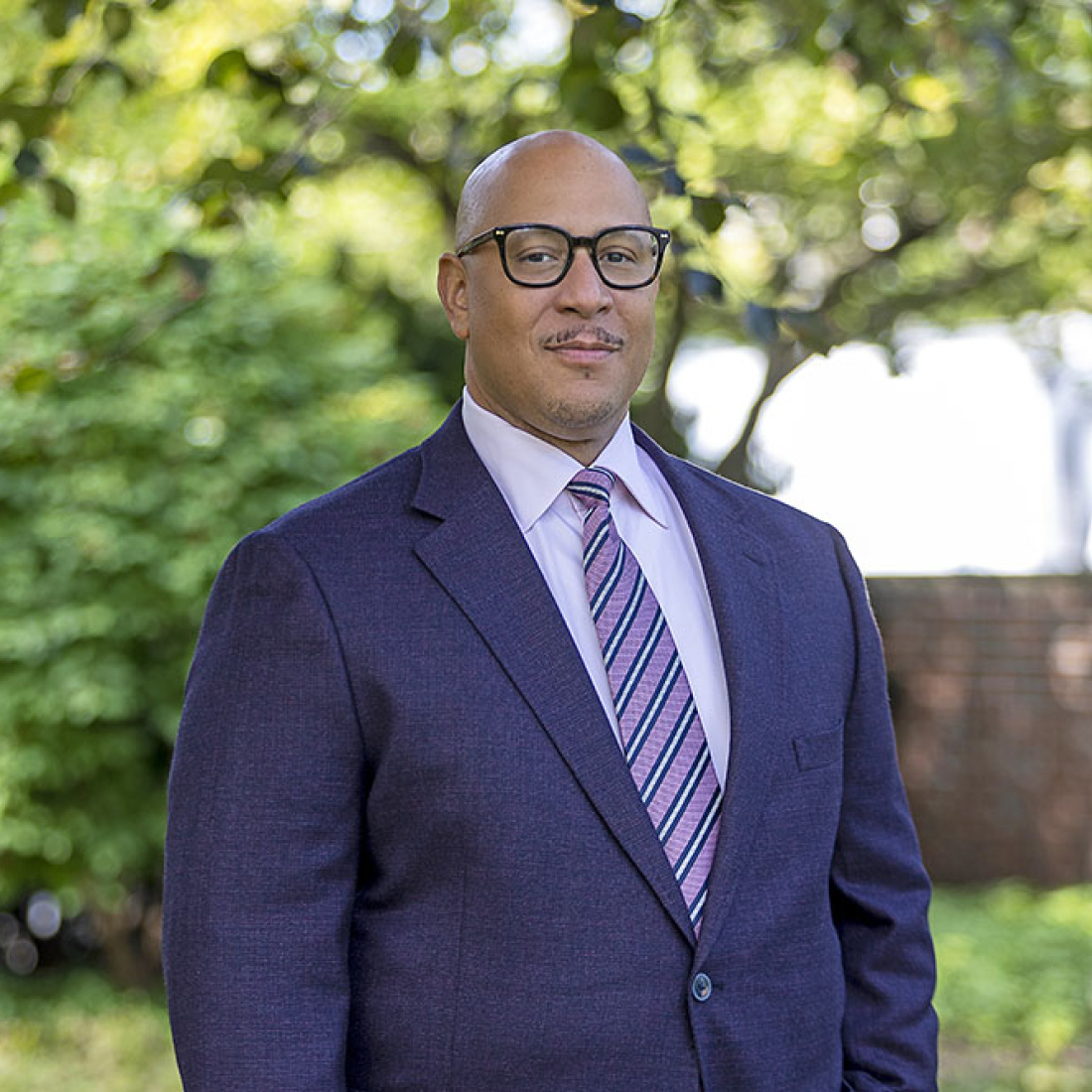
Frank D. Barnes
Frank Barnes is faculty director of the Doctor of Education Leadership Program. He has over 30 years experience as an educator, researcher, and organizer. As a chief accountability officer, he led turnaround efforts for large public school districts, including Boston Public Schools and Charlotte-Mecklenburg Schools.
Kathryn Parker Boudett
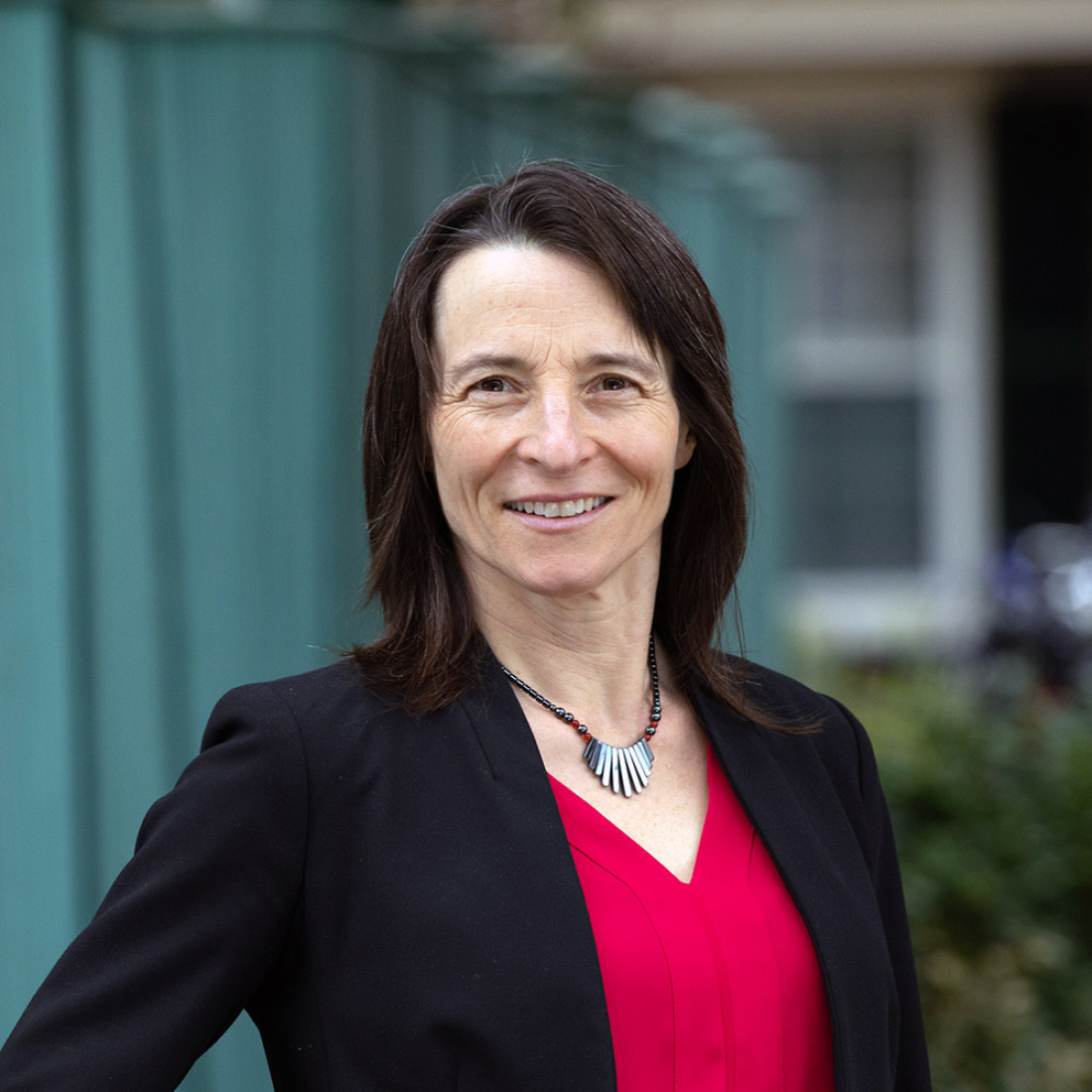
Ebony N. Bridwell-Mitchell
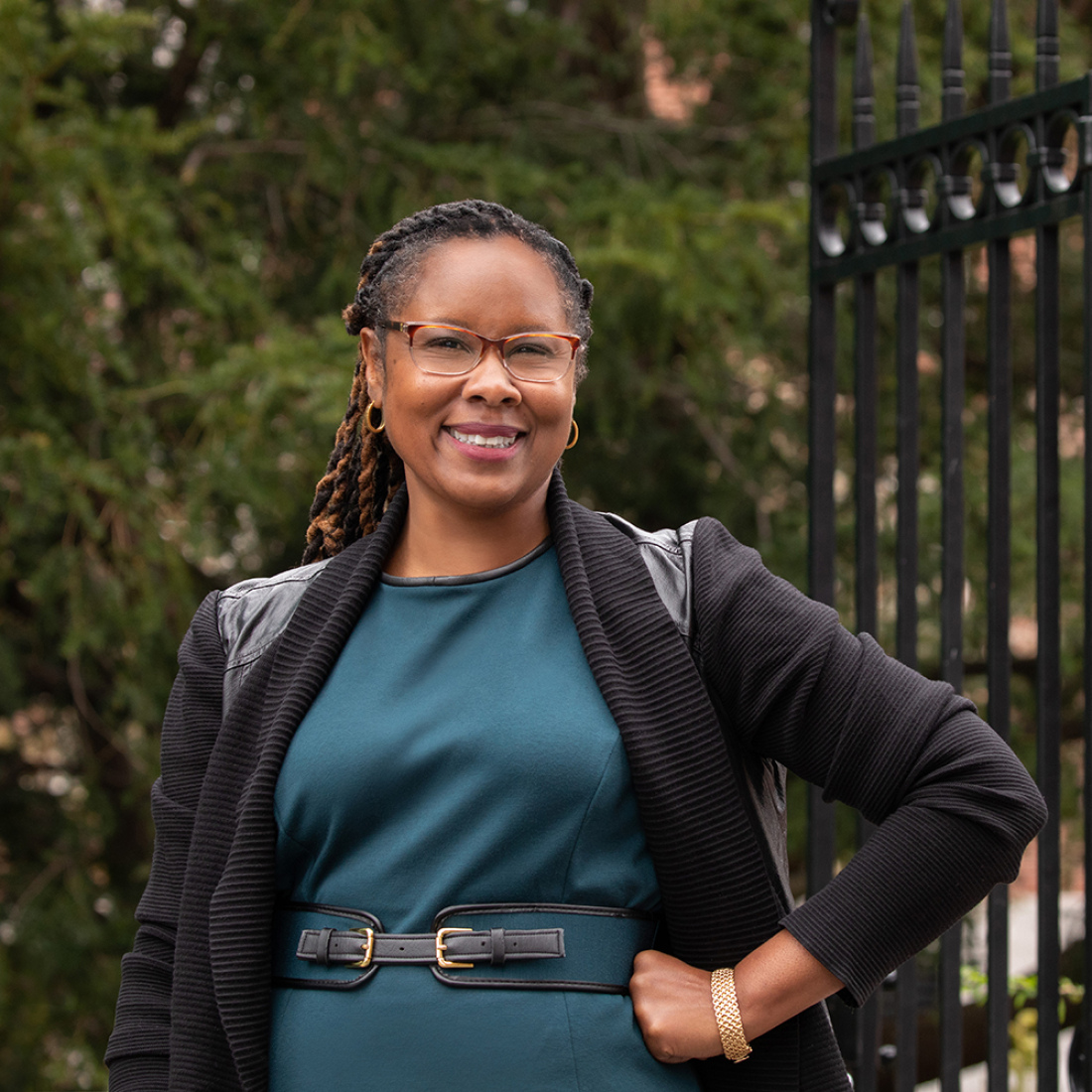
Jennifer Perry Cheatham
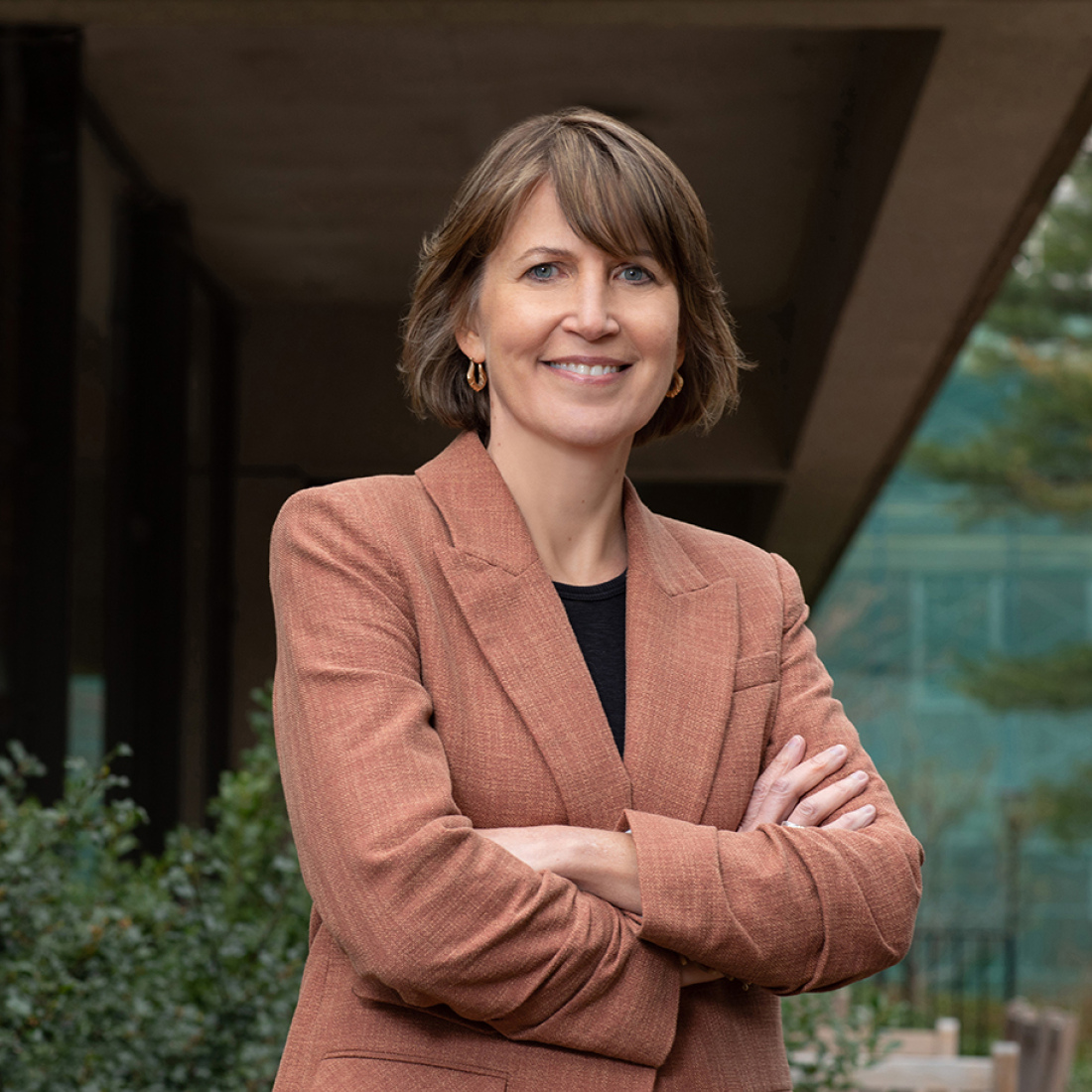
Elizabeth City
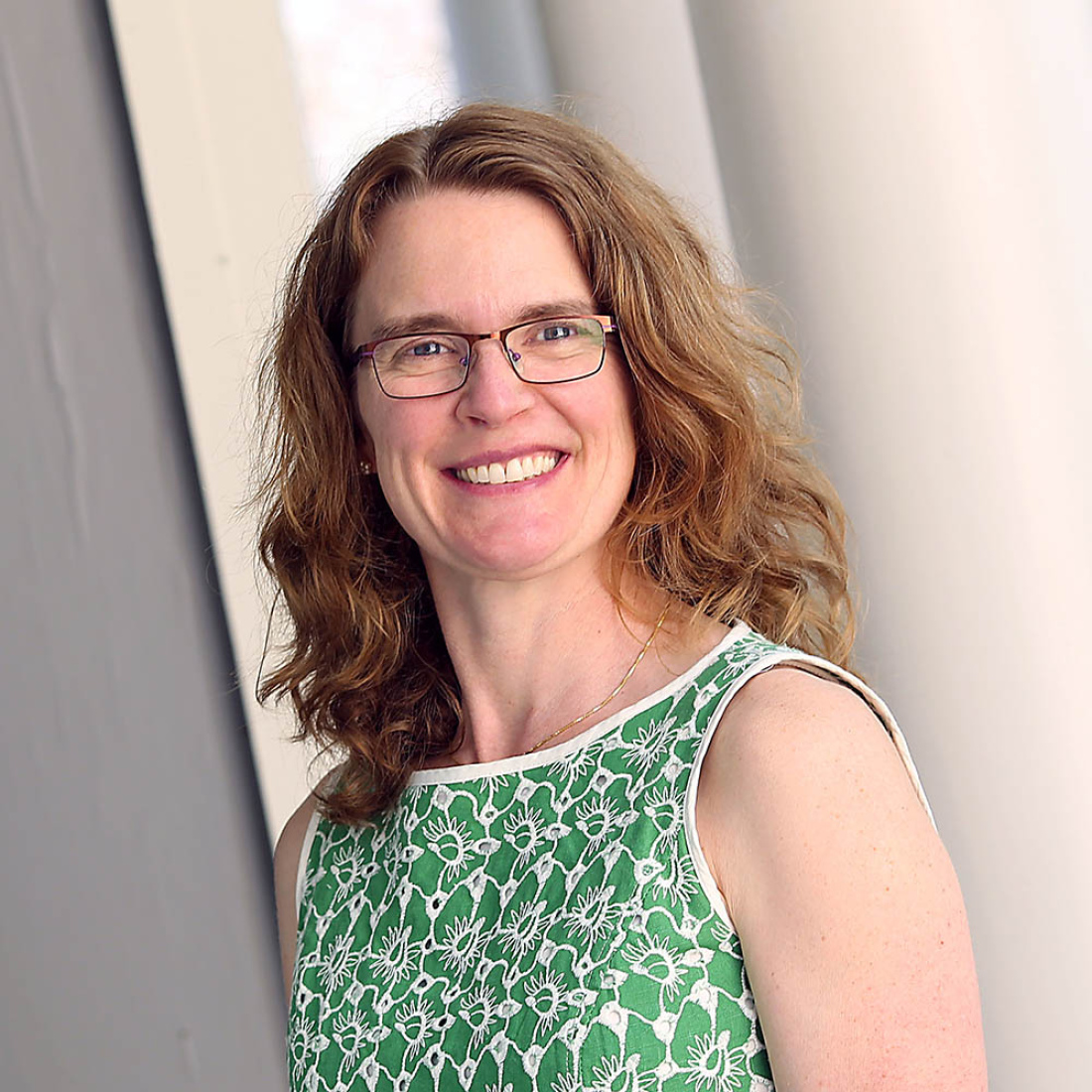
Candice Crawford-Zakian
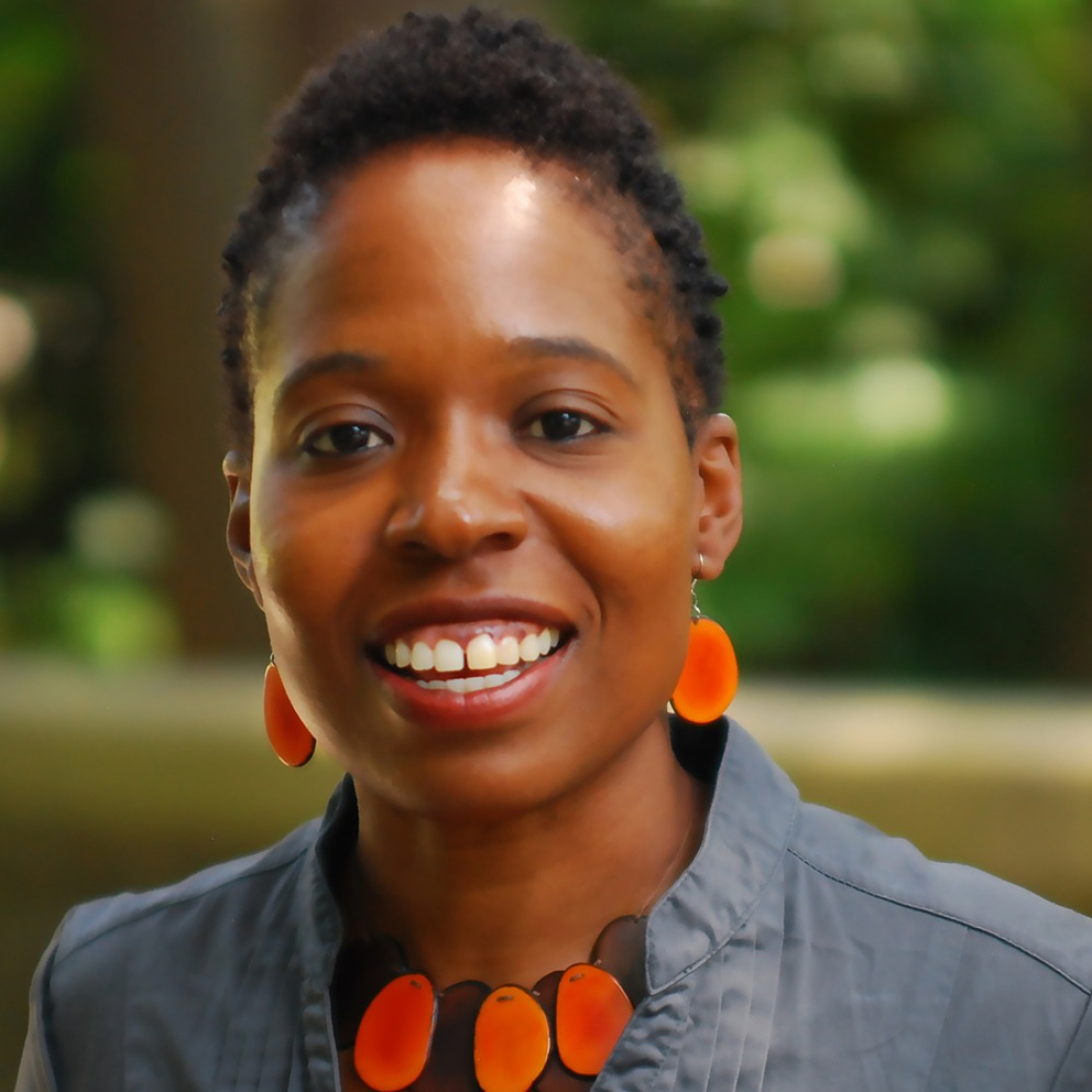
Marshall Ganz
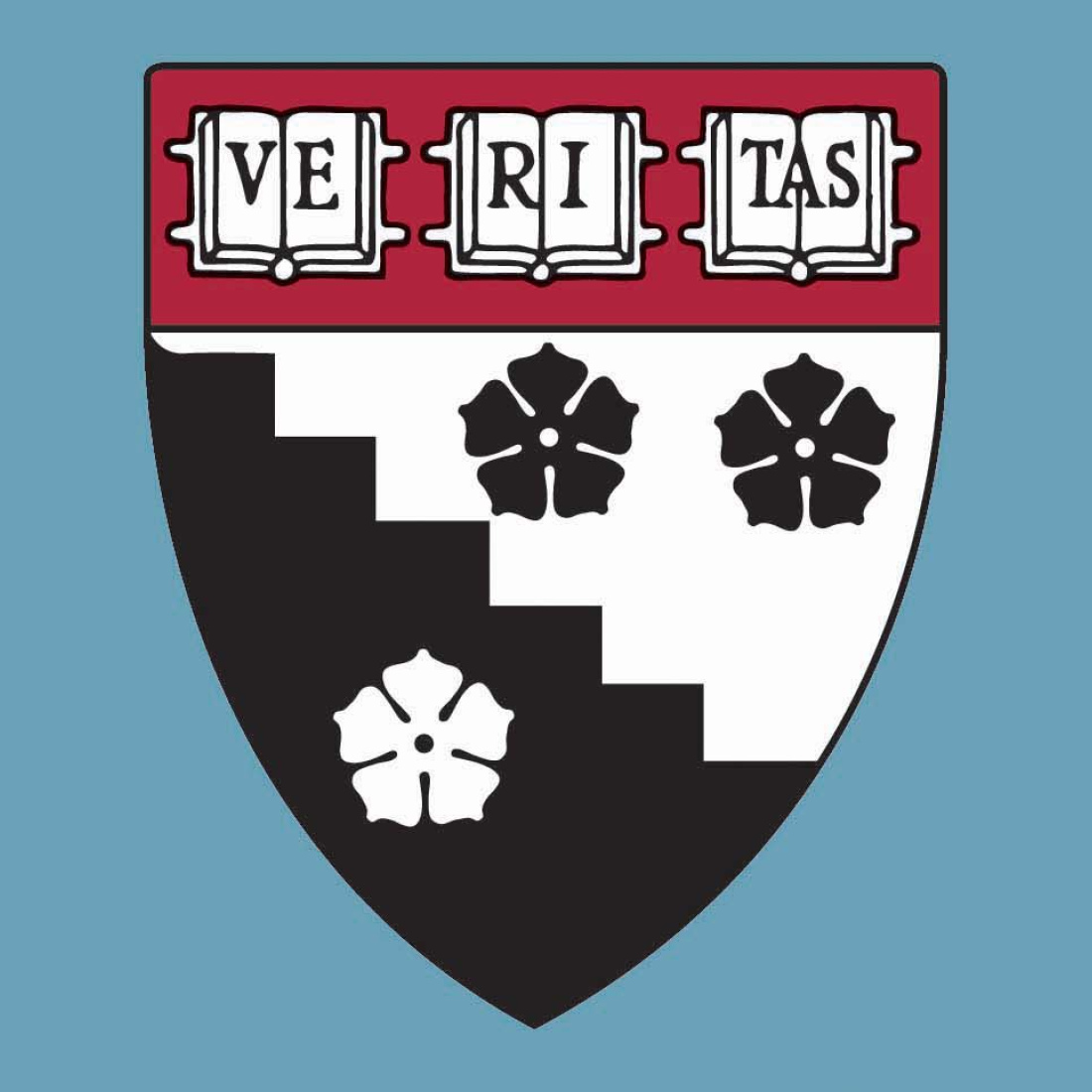
Adria D. Goodson
Deborah helsing.

Monica C. Higgins
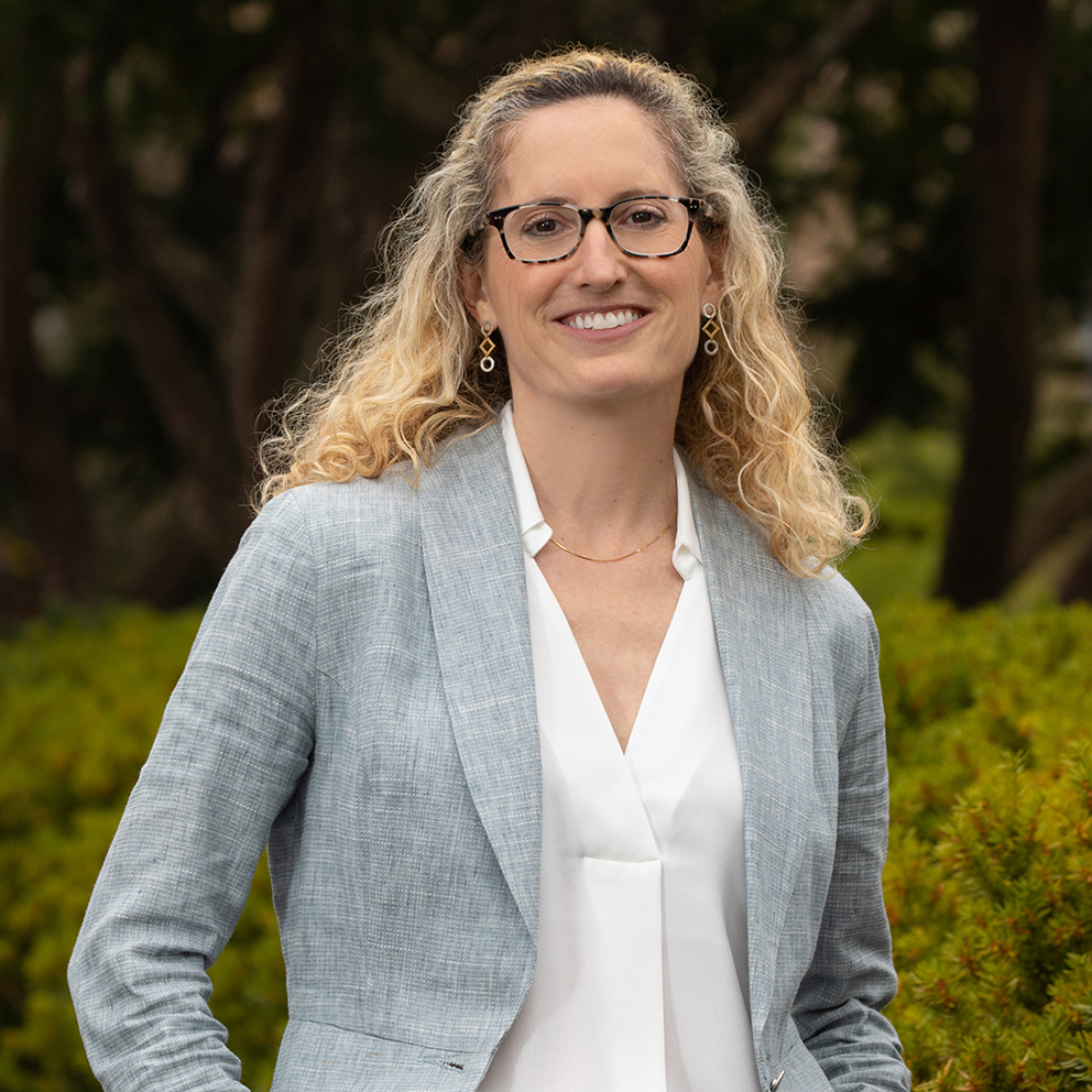
Deborah Jewell-Sherman
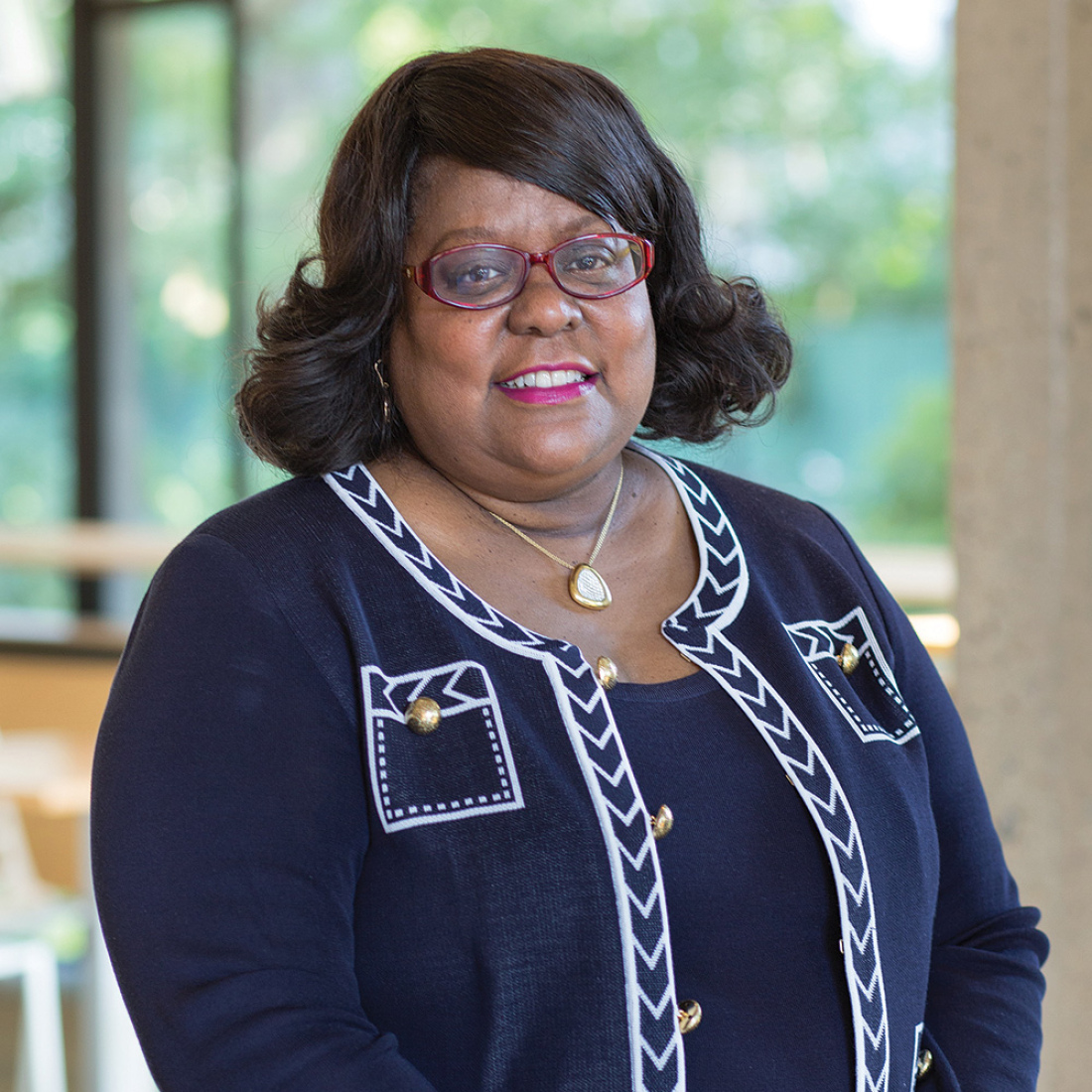
Lisa Laskow Lahey

Mary Grassa O'Neill
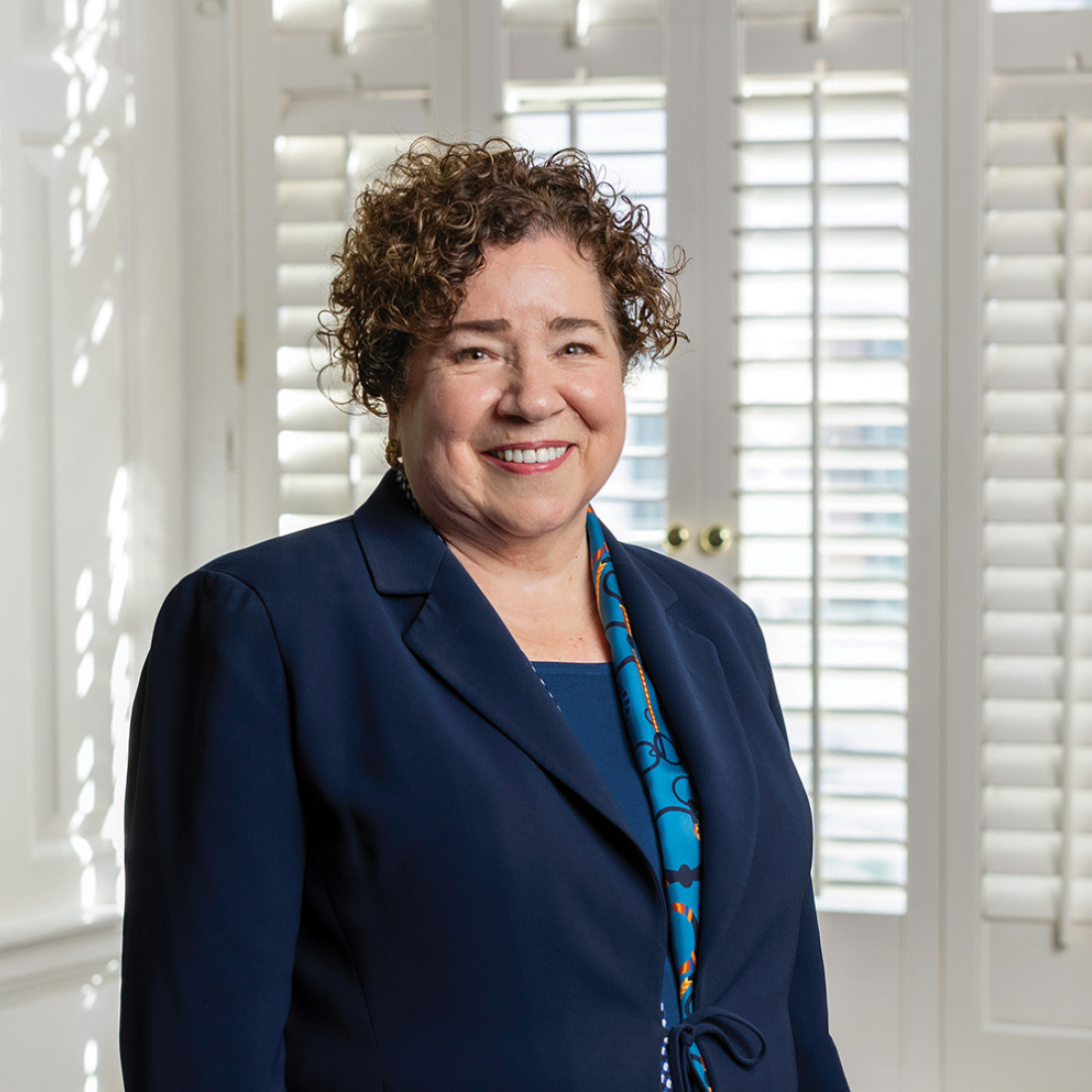
Irvin Leon Scott
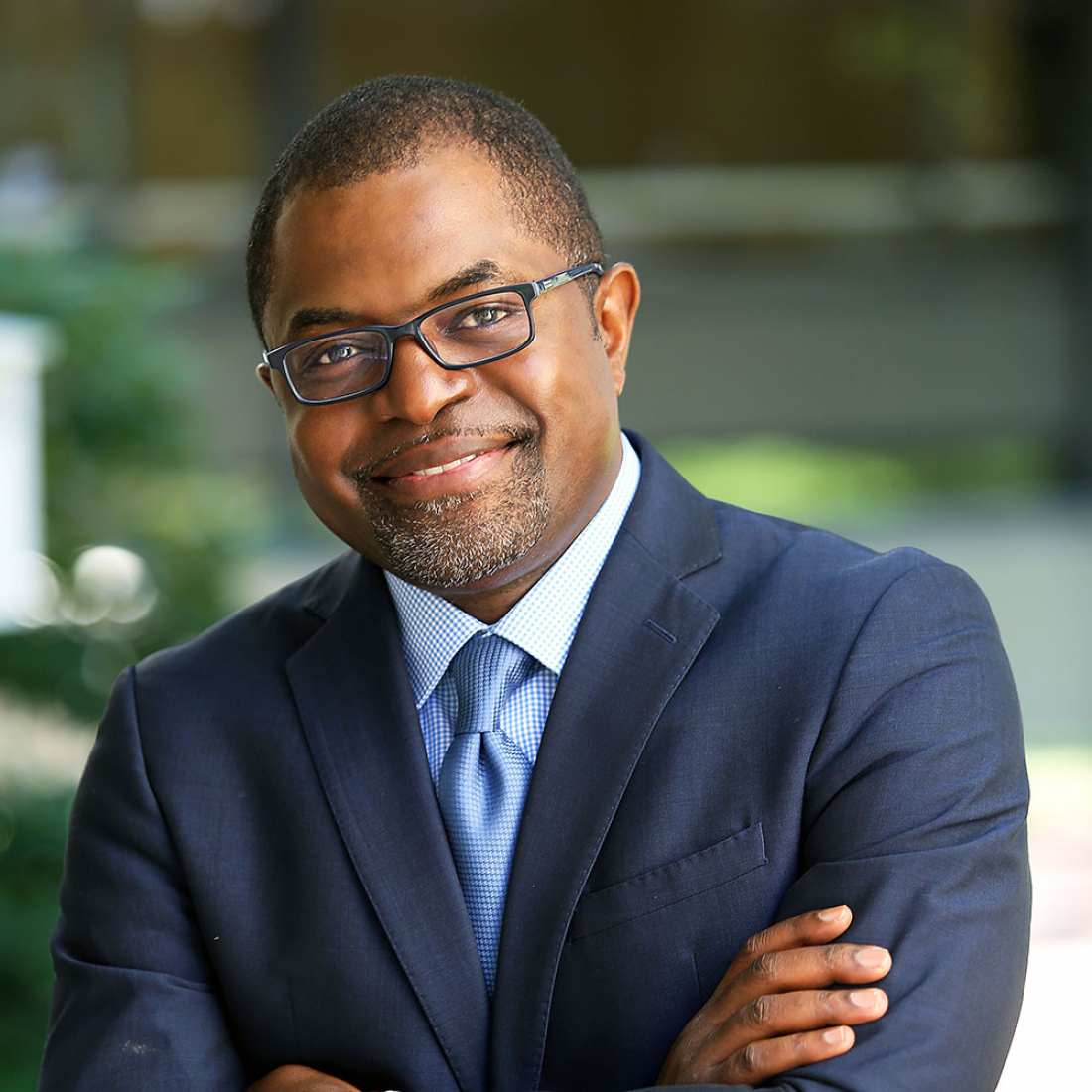
Catherine Snow

Michael L. Tushman
Martin west.

Introduce Yourself
Tell us about yourself so that we can tailor our communication to best fit your interests and provide you with relevant information about our programs, events, and other opportunities to connect with us.
Program Highlights
Explore examples of the Doctor of Education Leadership experience and the impact its community is making on the field:

Do We Need Happiness Teachers?
After a trip to meet with the Dalai Lama, an Ed.L.D. student says we do
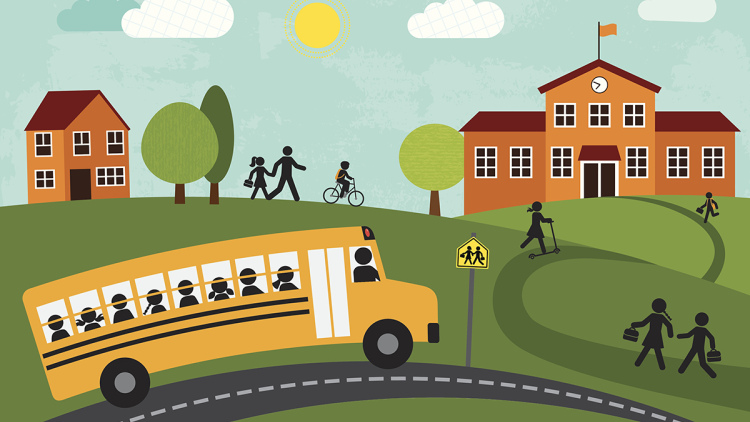
Combatting Chronic Absenteeism with Family Engagement
As post-COVID absenteeism rates continue unabated, a look at how strong family-school engagement can help

COMMENTS
8 components including • Content is focused, not Rationale everything taught. Minimum of 2 SLG goals each • Create cohorts of students year with the same need. Category 1 SLG goals for • Tier goals/targets where. teachers and principals using appropriate SGPs* in grades 4‐8 in ELA • Include the support and math educator needs for goal.
Below you'll find a list of over 100 IEP goals covering a variety of focus areas. Plus be sure to fill out the form on this page to get access to a free, editable Google Doc version of the goal bank along with a bundle of free editable goal-tracking sheets. The bundle includes daily and weekly goal-tracking sheets, as well as trial tracking ...
Attainable: This goal is doable if the teacher provides interventions to reduce stress levels. Relevant: The goal applies to a special education classroom environment because it focuses on improving student mental health. Time-based: There is a time limit of one month for meeting this certain goal. 10.
M - The measure for success is attendance rate. Teachers start by taking attendance daily. A - An increase of 10% is attainable and realistic. R - This smart goal is relevant to the special education classroom, as all students should be present and able to access the materials being taught.
This goal could involve researching best practices and then gathering the implementation tools. Explore new ideas to promote student independence and self-advocacy. Whether you're teaching at the elementary school, middle school, or high school level, student independence is every special education program's top goal.
Special Education: From Goals to Growth > Getting Started > Course Syllabus. • Evaluate the quality of the goals in an IEP. Module 4. • Distinguish between accommodations and modifications. • Select appropriate accommodations and modifications to support a student's outcome/ goals. Module 5. • Describe the interdisciplinary process of ...
Given this link, educators should strive to create goals that align with a student's level and actual time in the classroom. Some digital platforms automate this process, screening and predicting student growth so that teachers can select goals that are attainable. Students with learning disabilities need ample time to reach proficiency.
As a special education teacher, it is mandatory to set appropriate goals on your Individualized Education Program (IEP) annually. Appropriately setting well-thought-out goals on the IEP allows students, with any disability, to achieve success, growth, and increase positive behaviors.
The Individualized Student Growth Model is often utilized in special education classes where the teacher is with a student the majority of the instructional day and has spent extensive time developing their students Individualized Education Program (IEP). The students IEP goals are usually aligned with the Individualized Student Growth Model to ...
Developing a growth mindset is just one aspect of Social-Emotional Learning. Here are some other relevant skills that can help students in special education: Goal-setting: Encourage students to set realistic, achievable goals for themselves and track their progress. Self-awareness: Help students identify their strengths, weaknesses, and areas ...
Measurable academic and functional goals. IEP goals should enable the child to learn the basic skills that are necessary for thechild to be independent and self-sufficient. These basic skills include: Communication skills. Social skills and the ability to interact with others. Reading skills.
Creating a graph of progress monitoring IEP goals is a valuable tool in special education to represent a student's progress over time visually. Educators can track and measure students' growth by graphing data points, identifying trends, and making data-informed decisions to support their educational needs.
The term `individualized education program' or `IEP' means a written statement for each child with a disability that is developed, reviewed, and revised in accordance with this section and that includes. (II) a statement of measurable annual goals, including academic and functional goals, designed to--. (aa) meet the child's needs that result ...
Here are four examples of general goals that special education teachers should strive for when working with special needs students: 1. To develop positive relationships with students and families. 2. To foster academic success for every student. 3. To ensure social and emotional growth for every student. 4.
growth, evaluations should not use a student's progress on their goals, objectives, or benchmarks on the individualized education program (IEP) as a measure of a special education teacher's contribution to student ... student growth and the special education teacher's contribution to that growth, progress monitoring and assessment,
The teacher aims to meet the individual and specific needs of a child facing difficulties in learning. For instance, for a child with deficits in speech, the goal is to deliver speech and language therapy sessions once a week to reach a point where the child shows improvement in the same. 2. Enhance functional skills.
Student growth is the change in student achievement between two points in time (RCW 28A.405.100). Student growth refers to the learning progress made by students through instructional experiences. The student growth process includes: setting goals for students, planning instruction and assessment, and reflecting on student progress. Student growth is a substantial factor in evaluating educators.
For Special Education Teachers, soft skills such as patience, adaptability, and effective communication are essential. Cultivating these skills can significantly improve classroom management, foster deeper student connections, and enhance collaboration with parents and other educators.
Examples of SMART Goals for Special Education Teachers. Special education teachers establish goals for their pupils to assist them in making development and achieving academic achievement. These objectives are often SMART, specific, measurable, attainable, relevant, and time-bound. Here are some examples of SMART objectives for instructors of ...
Vygotsky, as no other psychologists in this century, succeeded in developing an approac h that. connects social and mental processes and describes the essential mechanisms of the socialization and ...
The IDEA definition of special education is: specially designed instruction, at no cost to parents, to meet the unique needs of a child with a disability. It includes physical education, related services (e.g., speech therapy, occupational therapy), vocational education, and travel training. Essentially, special education is how students with ...
A student works with a staff member at Ruby Bridges Elementary School in Woodinville, Wash. on April 2, 2024. Special education students at the school are fully a part of general education classrooms.
The special education master's program at the University of Idaho allows experienced ... and academic development as well as preparing special education students for daily life beyond school also is an important aspect of the job. ... the need for paraeducators is growing at an even faster rate. Since 2000, the annual growth rate for teachers ...
THE JOURNAL OF SPECIAL EDUCATION APPRENTICESHIP, 10(2) the need for effective programing among all team members (special education teacher, paraprofessional, administration, etc.) to work together for the good of the students' needs and growth. To foster success, there needed to be a sense of mutual respect and open communication among all ...
Students With Disabilities. In 2022-23, the number of students ages 3-21 who received special education and/or related services under the Individuals with Disabilities Education Act (IDEA) was 7.5 million, or the equivalent of 15 percent of all public school students. Among students receiving special education and/or related services, the ...
Administrative Assistant for Special Education. 208-664-8241. Email: [email protected] . Jenny Jensen. Assistant Director of Special Education (Elementary) 208-664-8241. Email: [email protected] . Samantha Minert. Coordinator of Special Education (Secondary) 208-664-8241. Email: [email protected] . Special Education ...
The Ed.L.D Program — taught by faculty from the Harvard Graduate School of Education, the Harvard Business School, and the Harvard Kennedy School — will train you for system-level leadership positions in school systems, state and federal departments of education, and national nonprofit organizations. Ed.L.D. is a full-time, three-year ...
2024 Chicopee Comp Graduation City of Chicopee - Mayor's Office Chicopee Comprehensive High School Chicopee Public Schools
DESCRIPTION OF BASIC FUNCTIONS AND RESPONSIBILITIES: A Special Day Class teacher for Emotionally Disturbed Students is a certificated member of the Rocklin Unified Education staff. A teacher in this classification conducts the educational and emotional program for children whose needs include support for emotional issues which interfere with their ability to learn. SUPERVISOR: Principal ...
Last week, the Maricopa County Community College District (MCCCD) was honored to welcome the U.S. Secretary of Education Dr. Miguel A. Cardona and Assistant Secretary for Special Education and Rehabilitative Services Glenna Wright-Gallo to South Mountain Community College (SMCC). The visit highlighted MCCCD's commitment to addressing Arizona's behavioral health workforce needs through the ...